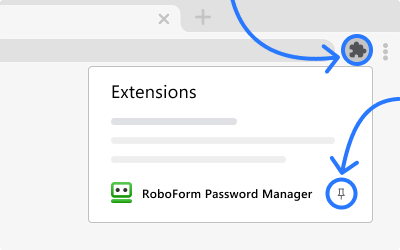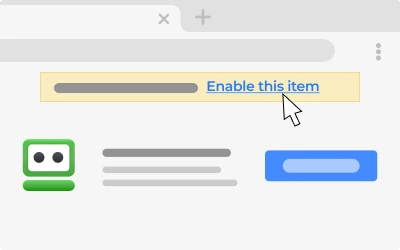RoboForm Manual for Mac
Current through RoboForm Version 9.6.4. To access the most up-to-date information about the current version of RoboForm visit our Help Center.
Printable Manual is available in PDF
Table Of Contents
- Chapter 1: Installation and Account Setup
- Chapter 2: Key RoboForm Terms
- Chapter 3: Browser Integration
- Chapter 4: Logins
- Chapter 5: Bookmarks
- Chapter 6: Safenotes
- Chapter 7: Identities
- Chapter 8: RoboForm Editor
- Chapter 9: Menu Bar Icon
- Chapter 10: AutoFill Dialog
- Chapter 11: Password Generator
- Chapter 12: Authenticator
- Chapter 13: Sharing and Sending
- Chapter 14: Emergency Access
- Chapter 15: Security Center
- Chapter 16: RoboForm Online
- Chapter 17: Start Page
- Chapter 18: Settings
- Chapter 19: RoboForm Security
Chapter 1: Installation and Account Setup
Requirements: RoboForm 9 works on macOS 10.13 and up. Supported browsers include Safari, Chrome, Firefox, Edge, and other Chromium-based browsers.
- Go to the RoboForm Download page here: https://www.roboform.com/download. To the right of your recommended download, click the green "Install" button.
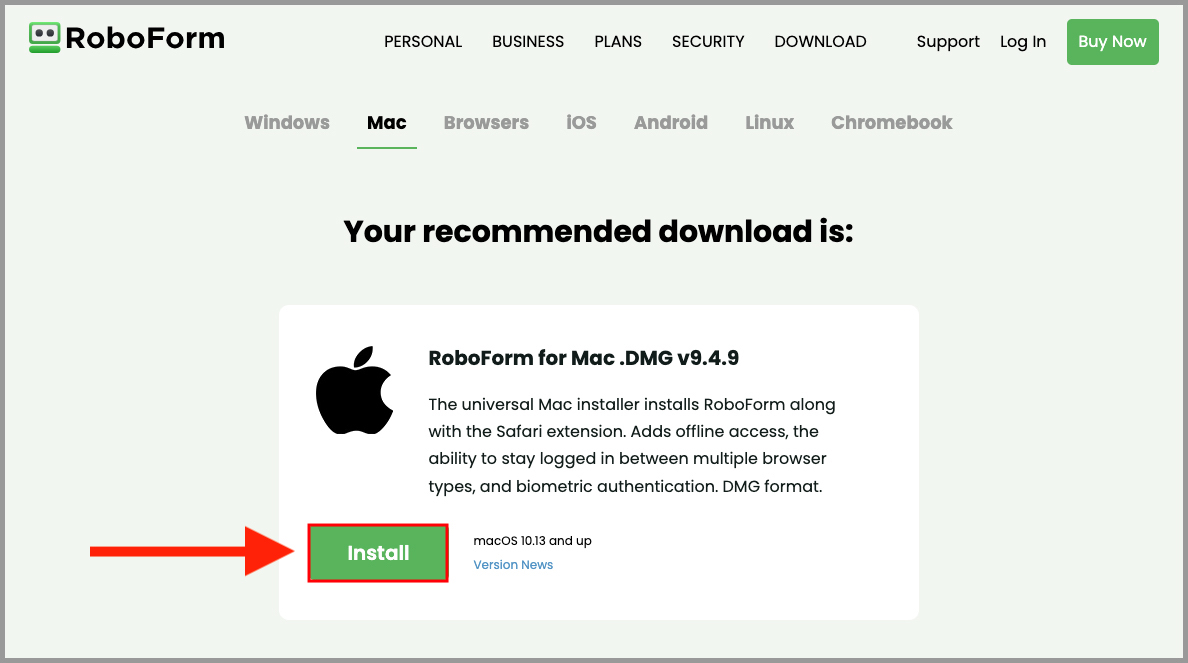
- Once the Setup file is downloaded, a link to it displays in the Downloads menu at the top right corner of your browser window. Click it to begin the setup process.
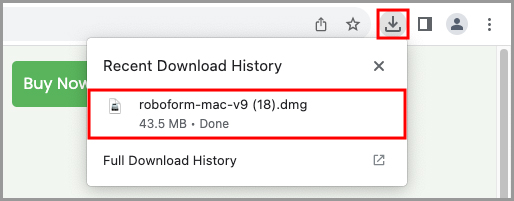
- The RoboForm Installer window will appear. Double-click the "RoboForm" icon to begin the installation.
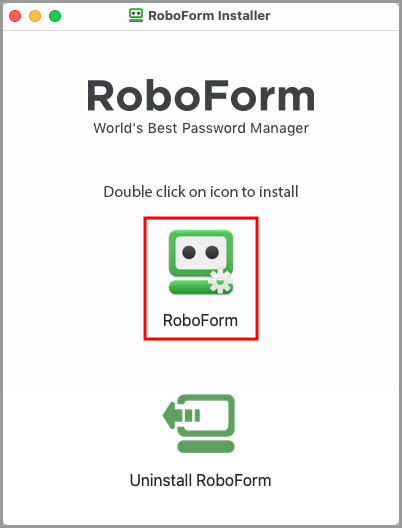
- You will be prompted to confirm that you would like to open RoboForm. Click the blue "Open" button on this message.
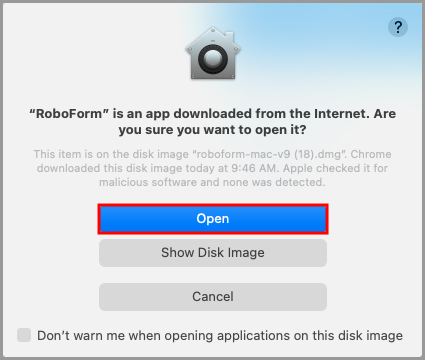
- Once the installation is finished, you will be prompted to install the RoboForm browser extension. For help with installing the RoboForm browser extension, click here.
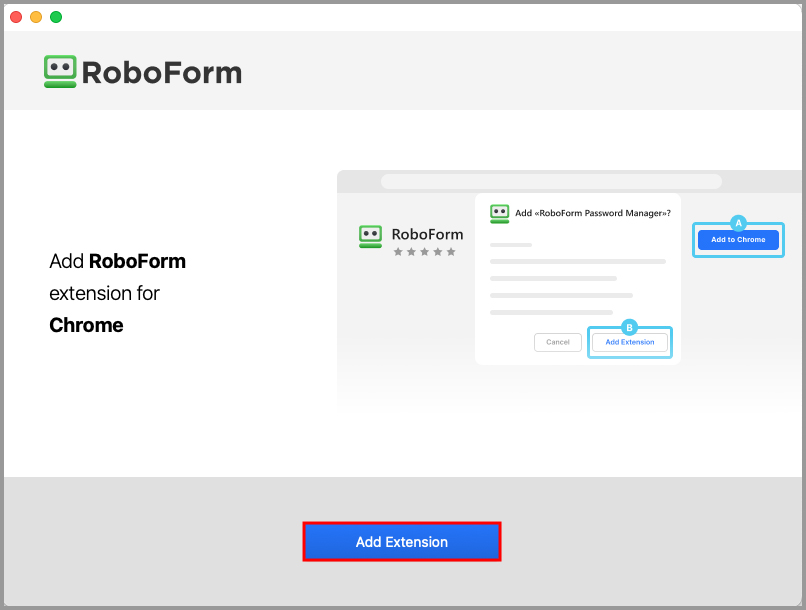
NOTE: Be sure to Pin the extension once you have finished adding it to your browser.

- You will be brought to the RoboForm Start Page where you will see options to either create your RoboForm account or to log in to an existing account.
- If you already have an account, choose the "Log In" option and enter your login credentials. Once you are logged in, you are ready to begin using RoboForm.
- If you do not have an account yet, choose the "Create New Account" option and steps 7 and 8 will walk you through the account creation process.
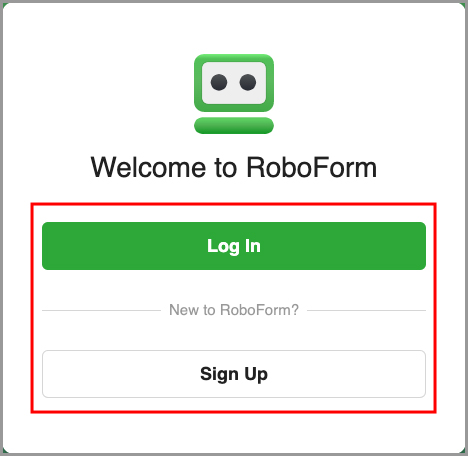
- After selecting "Create New Account," you will be on the "Create Account" window. Enter the email address you would like to use with your account, and a secure Master Password that you will be able to remember.
NOTE: If you forget your Master Password, you may be able to reset it through the RoboForm mobile app without losing your data.
Click here for our tutorial on enabling the Master Password Restore feature on iOS.
Click here for our tutorial on enabling the Master Password Restore feature on Android.
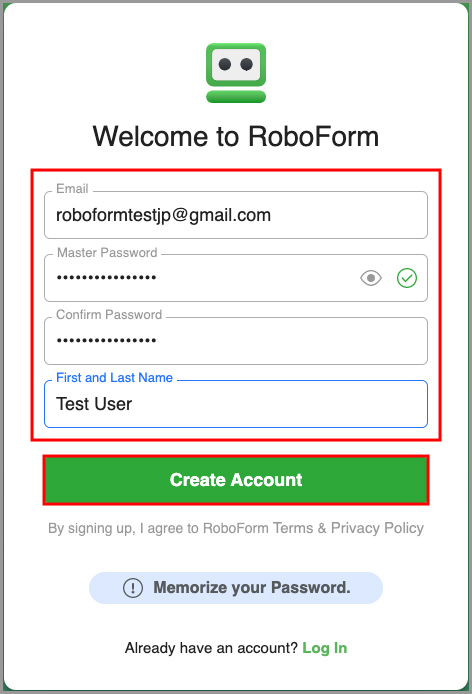
- Your RoboForm account has been successfully created. Click "Get Started" and your installation will be complete.
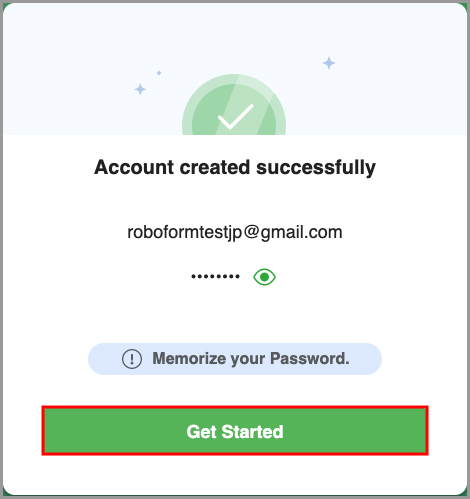
Chapter 2: Key RoboForm Terms
- Login - RoboForm saves online passwords into what we call a Login. Logins allow you to log in to a site with only one click. After saving a Login, RoboForm will offer to fill your Login details automatically when you visit the sign-in page for the site again.
- Bookmarks - Bookmarks are websites and web pages you can save to RoboForm, similar to a Bookmark on your browser. Creating a Bookmark leaves you one click away from your favorite web pages.
- Identity - Your Identity is your personal profile. RoboForm can use Identities to automatically fill in web forms, such as an online checkout. Identities consist of the following categories: Person, Address, Credit Card, Bank Account, Business, Passport, and Car.
- Contact - This is your Address Book. Each entry in this Address Book is called a Contact. A Contact is like an Identity but is not used for form filling. Instead, it is used to lookup other people’s personal data such as their name, phone number, address, etc.
- Safenote - You can store frequently-used text into what we call a Safenote. Safenotes provide storage for important information that is not automatically stored in Logins or Identity such as lock key combinations, secret family recipes, and software activation codes.
- RoboForm Data - All of your RoboForm items - your Logins, Bookmarks, Identities, Contacts, and Safenotes - make up your RoboForm Data.
- Folder - All of your RoboForm items can be categorized in Folders, similar to Windows Folders. Any item of RoboForm Data can be organized into Folders - including other Folders!
- Master Password - This is the main password that unlocks all of your RoboForm Data for use. Do not forget your Master Password! We do not store it and will not be able to recover it for you if you lose it. NOTE: If you forget your Master Password, you may be able to reset it through the RoboForm mobile app without losing your data. Click here for our tutorial on enabling the Master Password Restore feature on iOS. Click here for our tutorial on enabling the Master Password Restore feature on Android.
- RoboForm Extension - This is the main vertical or horizontal RoboForm Browser application. The RoboForm Extension is the term that will be used to characterize both Extensions and Toolbars.
- In Google Chrome, Mozilla Firefox, Opera, and Microsoft Edge, Roboform is seen as an Extension that is located in the top right corner next to the address bar.
- In Safari, the RoboForm Extension is located on the left side of the address bar.
- RoboForm Menu Bar Icon - This button initiates the RoboForm menu that is located next to your computer’s date and time. The Menu Bar Icon allows you to access RoboForm outside of your browser.
- RoboForm Editor - This is an application within RoboForm. You can edit, create, and access RoboForm Data in the RoboForm Editor.
- RoboForm Start Page - This is a web page that allows you to view and access your RoboForm Data on Windows or Mac. The Start Page cannot be accessed without the RoboForm extension being installed.
- RoboForm Online - This is a site located here which is now identical to the Start Page.
- Logins Menu - All of your Logins are organized in the Logins Menu. This menu can be found in the RoboForm Extension, Start Page, Menu Bar Icon, and the RoboForm Editor.
- Bookmarks Menu - All of your Bookmarks are organized in the Bookmarks Menu. This menu can be found in the RoboForm Extension, Start Page, Menu Bar Icon, and the RoboForm Editor.
- Identities Menu - All of your Identities are organized alphabetically in the Identities Menu. This menu can be found in the RoboForm Extension, Start Page, Menu Bar Icon, and the RoboForm Editor.
- Safenotes Menu - All of your Safenotes are organized alphabetically in the Safenotes Menu. This menu can be found in the RoboForm Extension, Start Page, Menu Bar Icon, and the RoboForm Editor.
- Fill Logins Tab - In the RoboForm Extension, the Fill Logins tab finds which Login is the best fit for the web page you are visiting.
- Identity Tab - In the Extension, the Identity Tab shows Identities that can fill the form on the web page.
- Help Menu - This menu has all the resources that will help you understand how to use RoboForm, including links to this manual, FAQs, the RoboForm website, Customer Support, and more.
- AutoSave Dialog - When AutoSave is enabled, this tool automatically pops up and offers to save Logins or Bookmarks for a web page.
- RoboForm Password Generator - A tool which allows you to generate a random and secure password. It has customizable parameters to ensure that, no matter what the password requirements of a website are, you will be able to generate a password which complies.
- RoboForm Authenticator - The RoboForm Authenticator allows you to use RoboForm as a two-factor authenticator for other sites and apps.
- Sharing Center - The Sharing Center provides a simple way to securely share or send RoboForm data items (Logins, Identities, or Safenotes) to another RoboForm user.
- Security Center - The Security Center is a tool that allows you to evaluate the strength of your passwords.
- Number of Compromised or Weak passwords
- Number of Duplicated Logins (username and password combinations)
- Number of Unique passwords
- Strength of individual passwords
- Emergency Access - Emergency Access allows you to select a trusted contact to securely obtain access to your RoboForm Data in the event of death, incapacitation, or simply as a method of account recovery. More than one Emergency Contact can be selected, with the option to vary the waiting period before providing access. Emergency Access can be revoked at any time.
Chapter 3: Browser Integration
RoboForm Data is accessible from your browser(s) by using the RoboForm Extension and Start Page.
RoboForm Extension
With Version 9, when you initially open the RoboForm Extension, you will be on the Logins tab.
This tab has different filters for your Popular (most used) Logins, your Recent (most recently used) Logins, an A-Z (alphabetical) list of your Logins, and an All filter, where you can view all of your logins in one place.
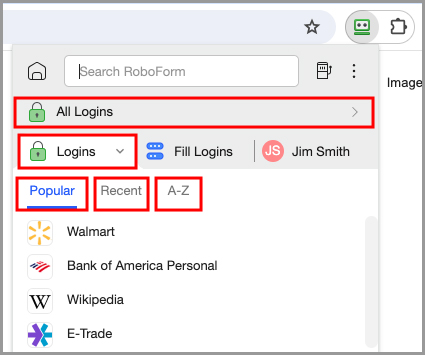
If you click the [ v ] button on the right side of the Logins button, you will receive a dropdown menu which contains options to view your Pinned Logins, All, Logins, Safenotes, and Identities.
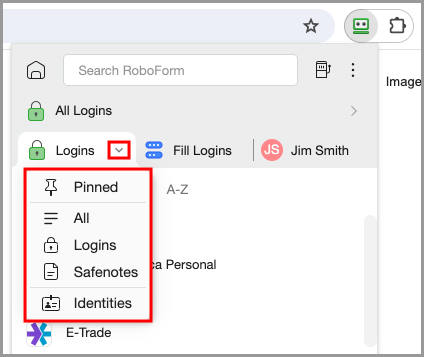
While viewing your Logins, you can click the 3 dots on the right of each Login to display a dropdown menu. Within this menu, you will see options to:
- Log In - Logs you in with one click.
- Go Fill - Takes you to the page for the Login and fills the fields without submitting.
- Go To - Takes you to the site attached to that Login without filling any fields.
- Fill Forms - Takes you to the site and fills its forms with that Login.
As well as options to view, edit, rename, delete, send, share, and add or remove a Login from your Pinned list.
There are also options to copy the username and password for that Login to your clipboard. These options are useful for when you are visiting sites which our autofill is not able to recognize, and need to manually paste your login credentials into their respective fields.
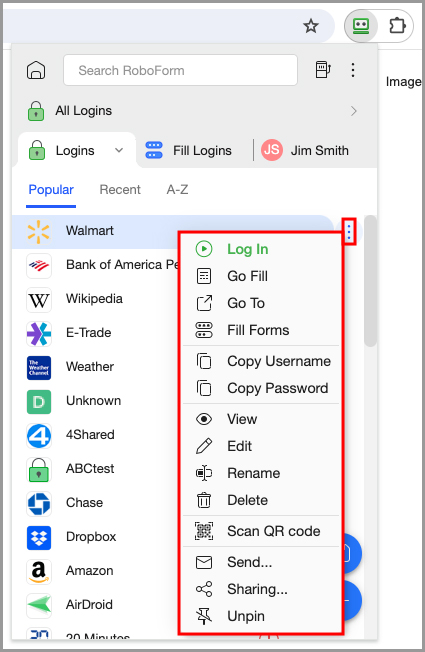
With the RoboForm extension, RoboForm changes its behavior based on the type of page you are on. If you visit a site which you have multiple Logins for, RoboForm will now open to the Fill Logins tab and show matching logins when you click the extension while on that site.
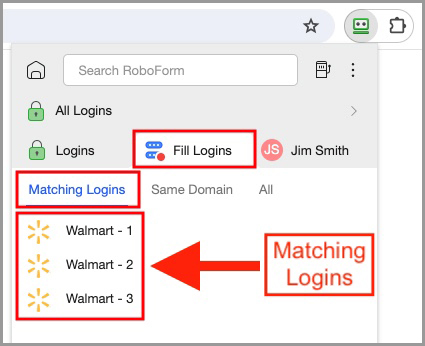
If you are on a page which contains a form to fill out, the extension will open up to the Identities tab automatically when clicked, and allows for fast form filling in one click by clicking the "Fill Forms" button.
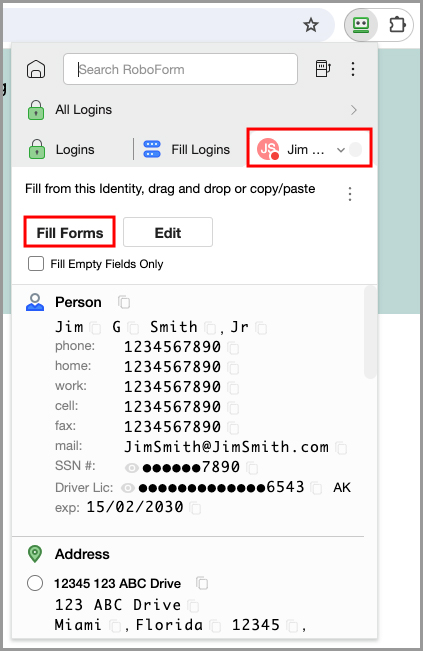
If you would like to save a page as a pre-filled form, a Login, or a Bookmark, you can do so by selecting the Fill Logins tab and clicking the blue “Floppy Disk” icon in the lower right.
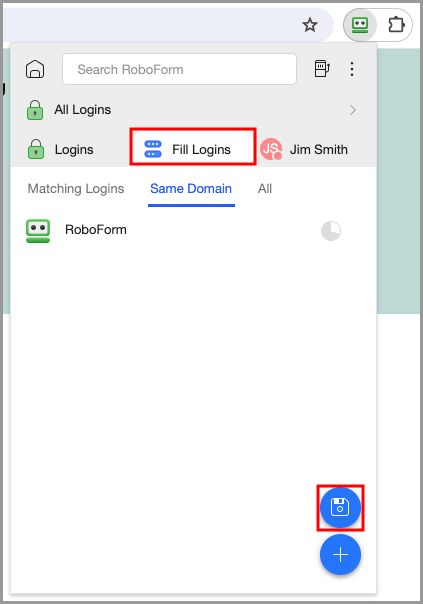
You can edit your Identities by clicking the "Edit" button next to the "Fill Forms" button.
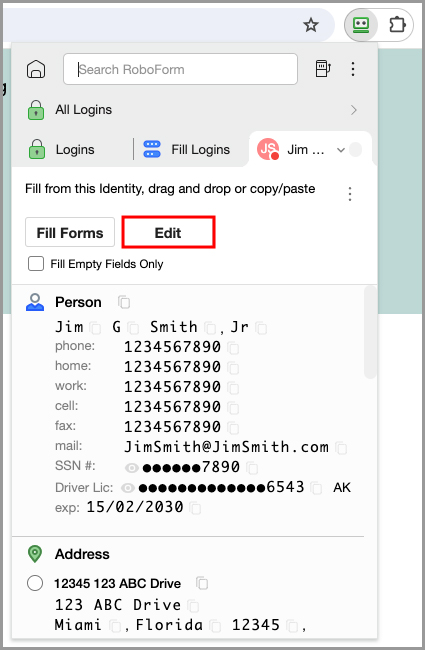
This will bring you to a window where you can edit the information stored in the selected Identity by clicking the "Pencil" icon in the upper right of the Identity. If you click the 3 dots in the upper right hand corner of this page, you will be presented with options to Share, Send, Print, Rename, Move, Clone, Copy All Fields, Delete, and Add to Pinned.
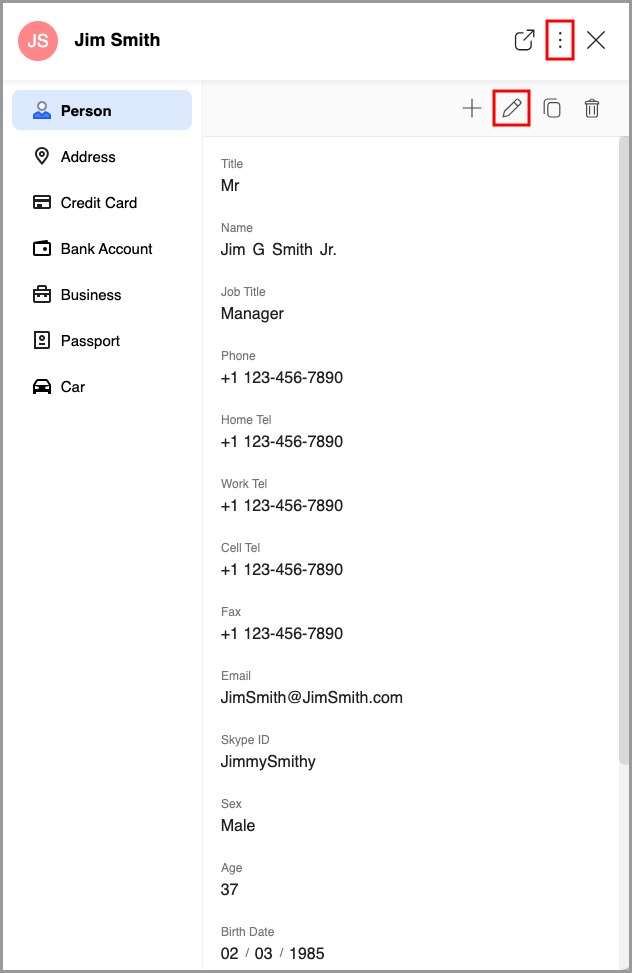
You can open the RoboForm Tools and Settings menu by clicking the 3 dots in the upper right corner of the RoboForm Extension. This menu contains the Password Generator, links to the Authenticator, Sharing Center, Security Center, and Emergency Access page, a Sync button, the Settings page, an Import option, an option to Scan a QR code, our Help menu, information about Referral Rewards, and offers the ability to Log Out.
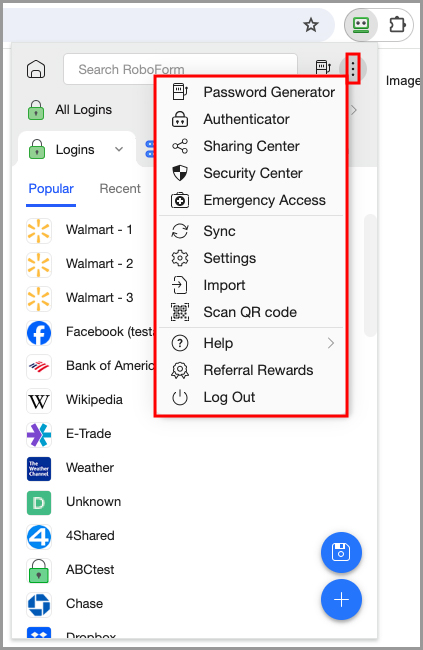
The Password Generator offers powerful customization options to ensure that no matter what the password requirements of a website are, you will be able to generate a password which complies.
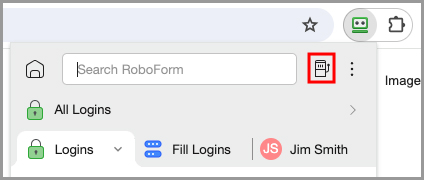
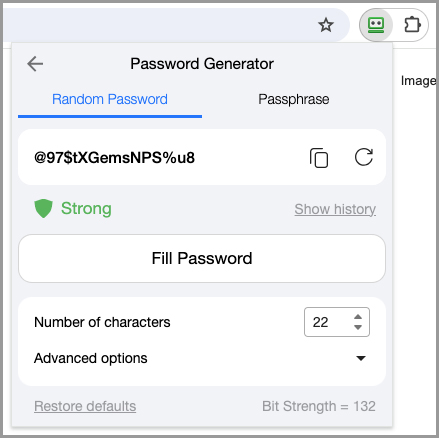
The Help menu offers links to our Manual, FAQs, and Home Page, information for what to do if you forget your password, the option to Contact Support, the ability to report an issue on a page, and an About page which gives you information about your version of RoboForm.
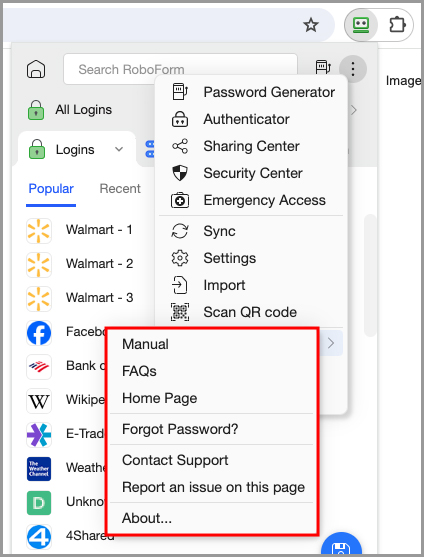
If you would like to view or edit your logins from the RoboForm Start Page, there is a convenient link (House Icon) in the upper left corner which will take you there.
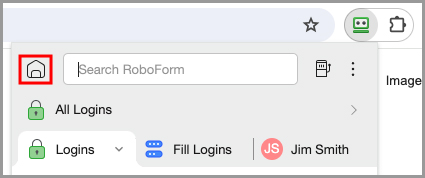
Chapter 4: Logins
Use Logins to store data that is specific to a website; data such as Usernames, Passwords, Survey fields, and more. Essentially, you can save any form data to Logins and use it to automatically fill any form later.
Saving Logins
AutoSave Dialog
When you manually enter login data to a login page and click the Login (Submit) button, RoboForm will offer to save this login info by displaying the AutoSave dialog.
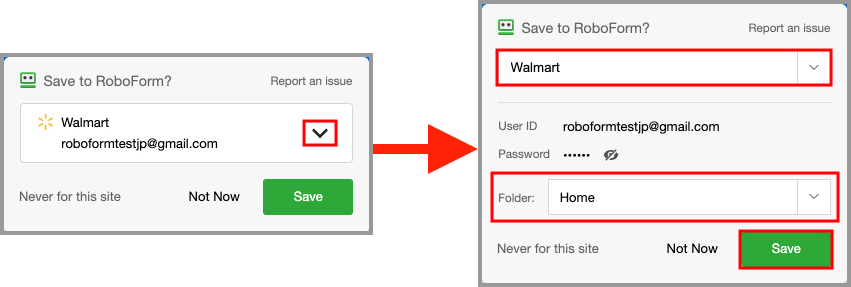
How to AutoSave a Login
- After ensuring that you have installed the RoboForm Browser Extension into your supported browser of choice, and have logged in, navigate to the site you would like to save your login information for. For this example, we will use Walmart.com. Enter your login information, and click the “Sign In” button. Or, if you are creating a new account, enter your new account information and click the “Create Account” button.
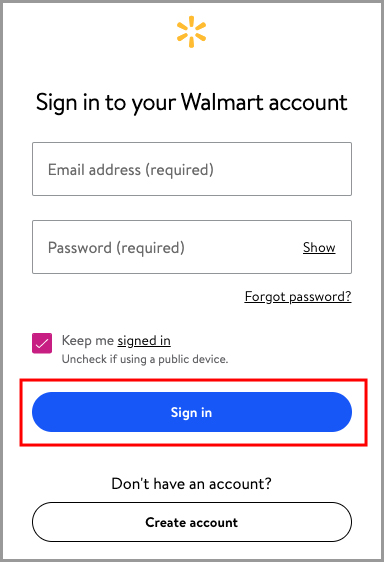
- After creating or entering your account credentials, a window will appear prompting you to save your login credentials into RoboForm. While on this window, you also have the ability to edit the name of your login, place that login into an existing folder, or create a new folder for the login.
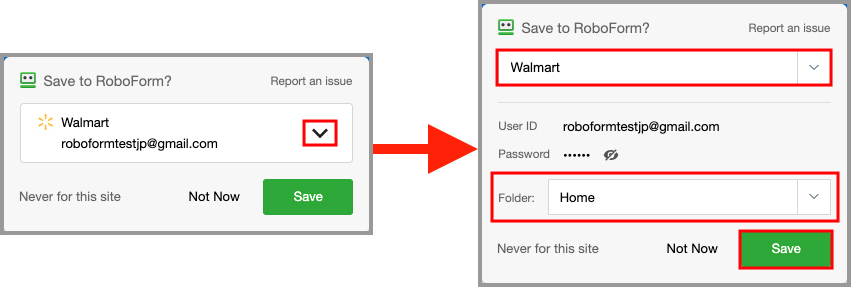

NOTE: Clicking "Never for this site" will disable RoboForm AutoSave from popping up on the website you are on. The AutoSave dialog pops up only if the Login data you entered is New, Different, or Updated. It will not prompt you if the exact same data (e.g., Username & Password) is already saved to RoboForm.
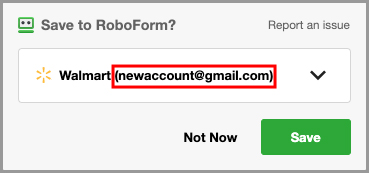
If you try to save a Login that has the same name as an existing Login, you will be shown a warning that says saving the Login will overwrite the data of your existing Login.
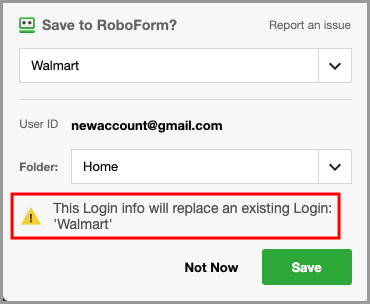
Password Change Detection
When changing your password on an existing account, RoboForm will offer to save your new password and overwrite your old password in Logins. The RoboForm Editor notes the date the password was changed.
Updated Website
You might have to do a Resave or Manual Save of a Login if the website’s login page has been changed or updated. Simply manually log in, and the AutoSave dialog will overwrite and save the original Login.
Forcing AutoSave
To “Force” an AutoSave for non-standard forms:
- Hold the ALT key and click the Login/Submit button on a web page.
If holding the ALT key and clicking does not work, enable the Force AutoSave keyboard shortcut:
- Open your browser, click the RoboForm extension, and then click the 3 dots in the upper right corner. Select “Settings.”
- Select “AutoSave” and enable the “Enable keyboard shortcut: ALT + click on sign-in button forces AutoSave” option.
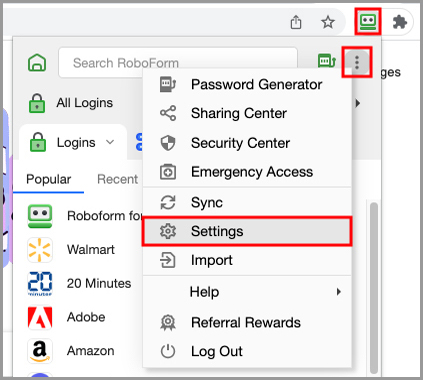
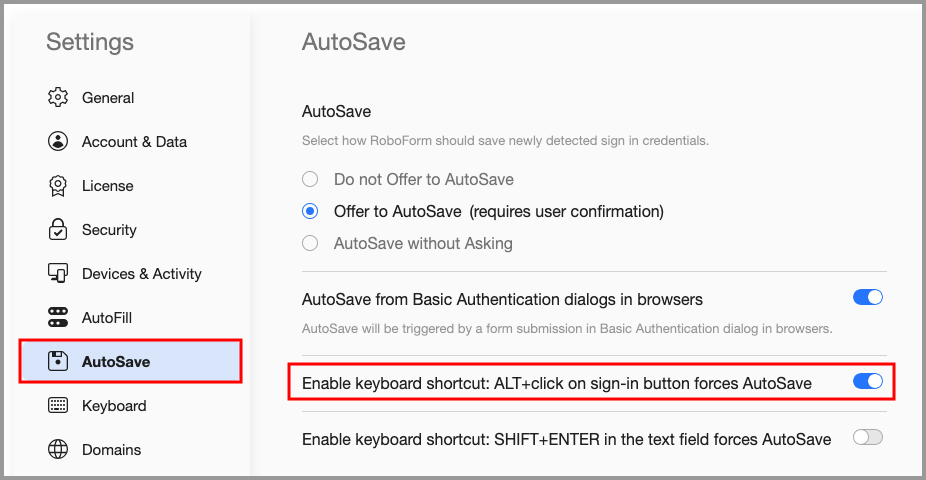
Saving a Login Manually
- Go to the RoboForm Start Page. Click the blue [ + ] button in the lower right corner.
- This will bring you to the “Add New Login” window. Search for the web page or click “Create your own.”
- Enter the Login details and click the “Save” button.
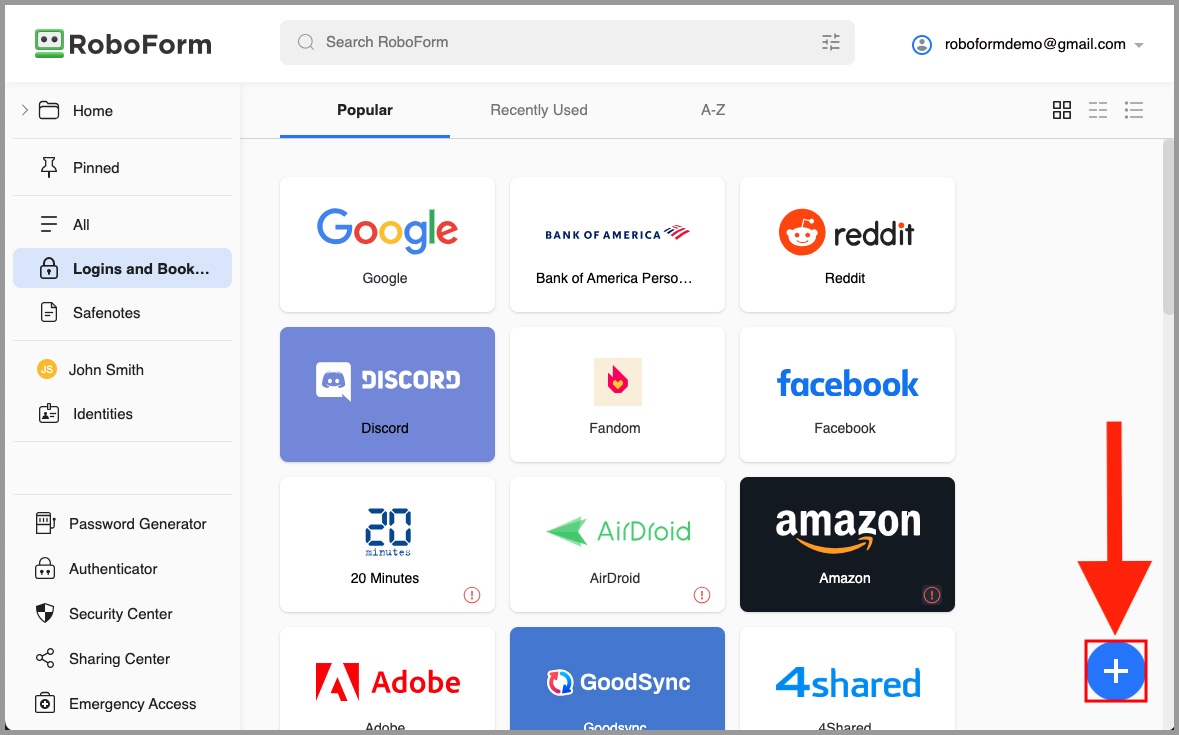
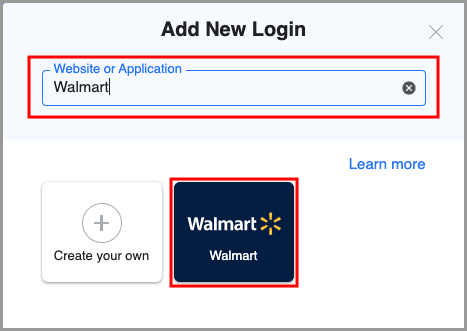
Using Logins
One-Click Login
RoboForm completes the entire Login sequence with one click via the RoboForm Extension, Menu Bar Icon, or Editor.
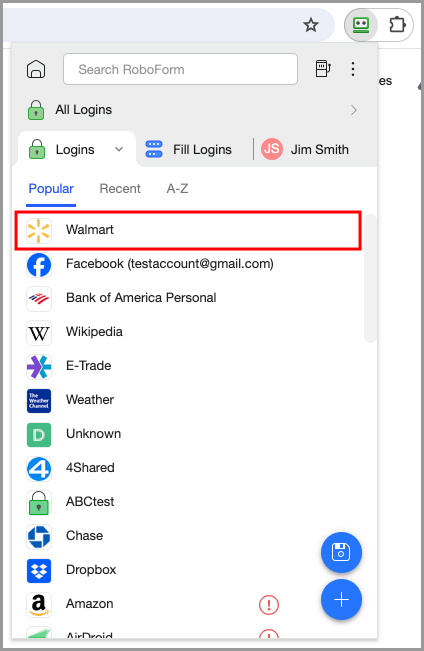
Matching Logins
When you visit a website with saved Logins, RoboForm shows the best match in the “Fill Logins” tab. Select the desired Login to log in.
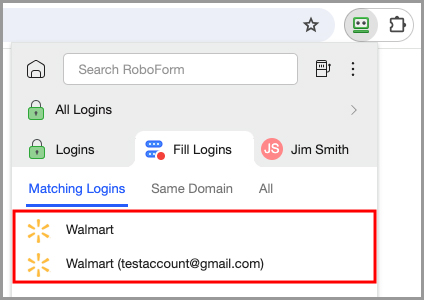
Chapter 5: Bookmarks
Use Bookmarks to store web addresses (URLs) in order to be one click away from your favorite pages and articles.
Saving Bookmarks
How to Save Bookmarks
- Go to the web page that you would like to save a Bookmark for.
- In the RoboForm Extension, click the “Floppy Disk” icon in the bottom right.
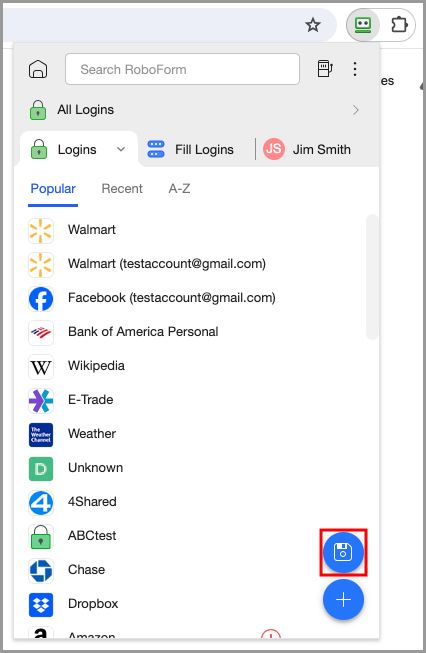
- Name your Bookmark and select which Folder you would like your Bookmark to be in. Then, click the blue “Save” button.

You can find your saved Bookmarks in the RoboForm Extension, the Start Page, the RoboForm Menu Bar Icon, or the RoboForm Editor.
Using Bookmarks
RoboForm Extension
In the RoboForm Extension, Bookmarks are stored in the “All” menu. Click the dropdown arrow next to “Logins” and select “All” from the menu.
NOTE: You may need to sort by A-Z to see your Bookmark if it is not a popular or recently used item.
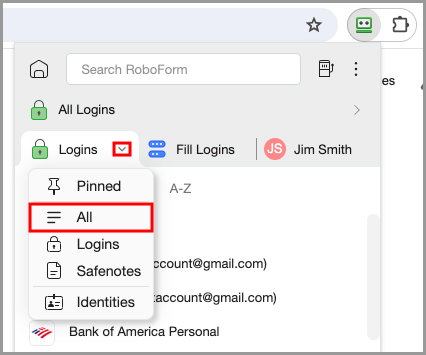
Then, click your desired Bookmark. RoboForm will open the Bookmark in a new tab.
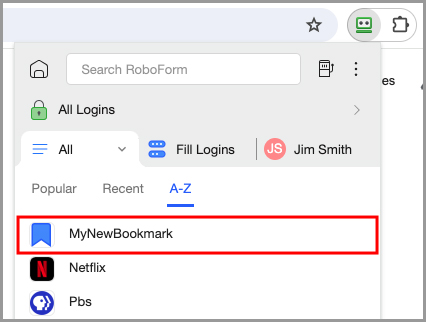
RoboForm Menu Bar Icon
In the RoboForm Menu Bar icon, Bookmarks are stored in the “All” menu. Click the dropdown arrow next to “Logins” and select “All” from the menu.
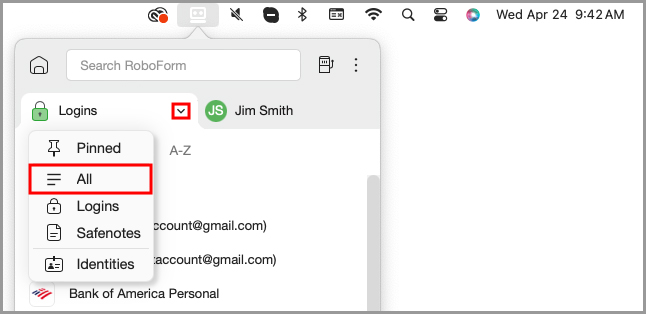
Then, click your desired Bookmark. RoboForm will open the Bookmark in a new tab.
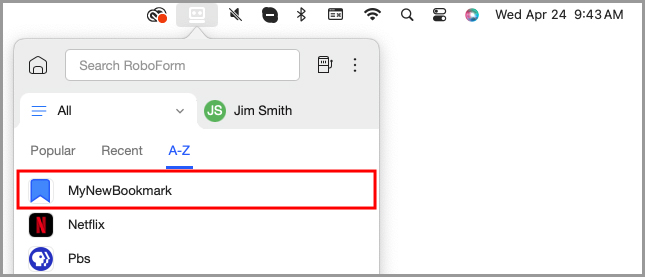
RoboForm Editor
Open Bookmarks in the Editor, select your desired Bookmark, and click the "Go To" button in the Editor’s details toolbar. RoboForm will open that address in a new window.
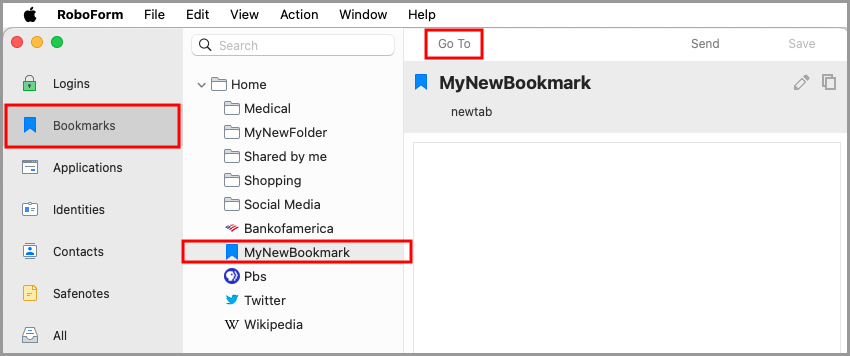
Right-Click Options
Right-clicking or clicking the 3 dots on an individual Bookmark in the Menu Bar icon’s interface will give you the following options:
- Go To - Opens the web page in a new tab.
- Copy URL - Copies the URL of the Bookmark to your clipboard.
- View - Opens the Bookmark on the Start Page for you to view.
- Edit - Opens the Bookmark on the Start Page for you to edit.
- Rename - Allows you to rename the Bookmark.
- Delete - Deletes the Bookmark.
- Send… - Allows you to send the Bookmark to another RoboForm user.
- Sharing… - Allows you to share the Bookmark with another RoboForm user.
- Add to Pinned - Adds the Bookmark to your Pinned list.
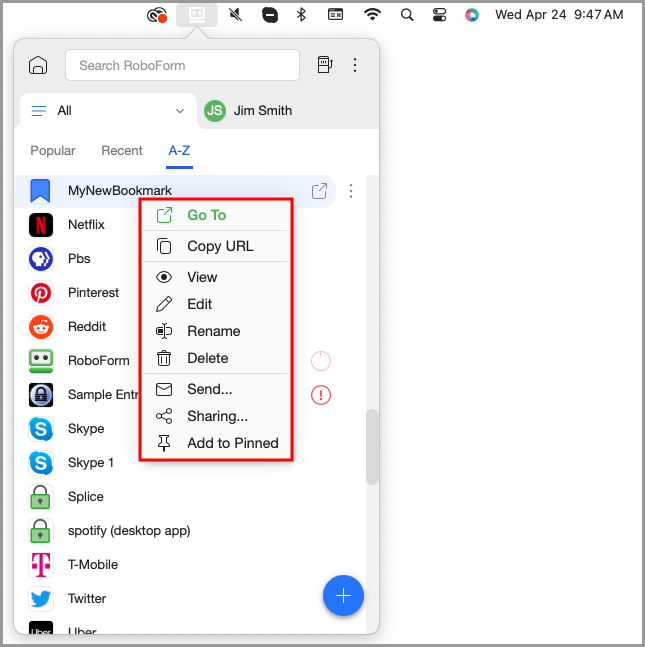
Right-clicking or clicking the 3 dots on an individual Bookmark in the extension will give you similar options.
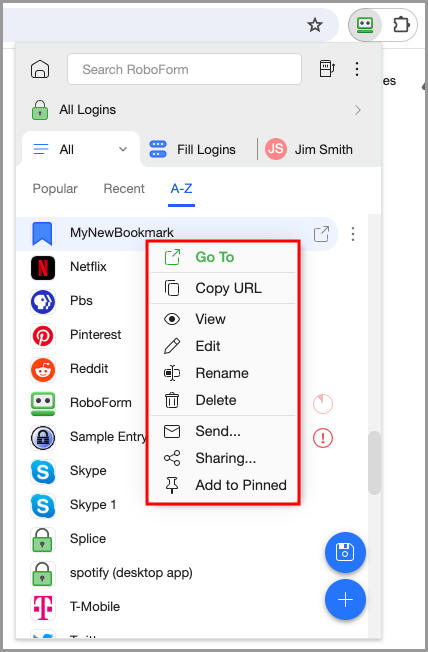
There are additional Bookmark Options in the RoboForm Editor which are detailed in Chapter 8: RoboForm Editor.
Chapter 6: Safenotes
Use Safenotes to store any text data or anything that RoboForm could not save into Logins. Some example Safenotes could include:
- Safe lock combinations.
- WiFi router Passwords.
- Software activation codes.
- Secret family recipes.
How to Create a New Safenote
RoboForm Extension
- In the RoboForm Extension, click the dropdown arrow next to “Logins” and select “Safenotes” from the menu.
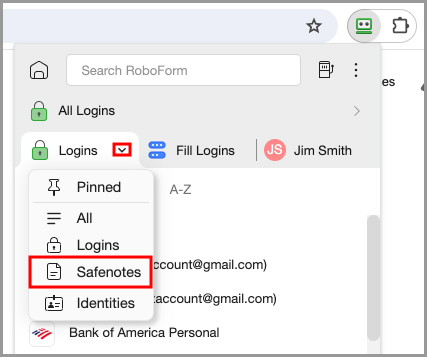
- Click the blue [ + ] button in the bottom right corner of the Safenotes menu.
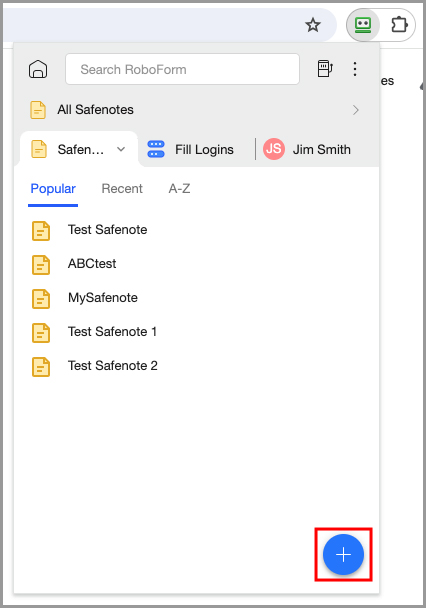
You will be brought to the Start Page to create your Safenote. The "New Safenote" window will appear. If you click the 3 dots in the upper right corner of this window, you will see a menu with options to Share, Send, Print, Rename, Move, Clone, and Delete your Safenote.
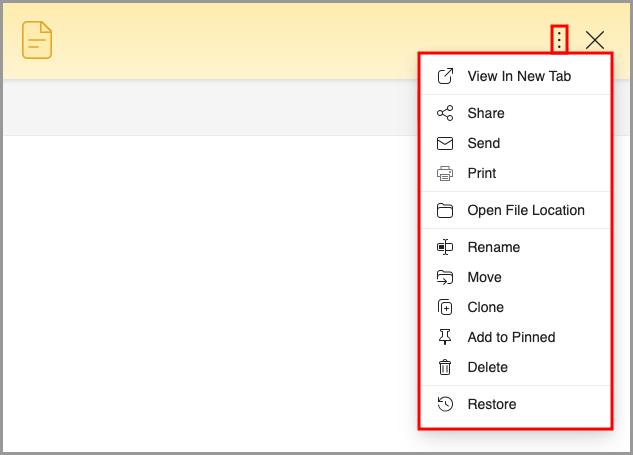
When you begin filling in the text of your Safenote, the title will automatically populate with the initial few words you write. Once you are finished filling out the text of your Safenote, click the blue "Save" button in the upper right to save your changes.
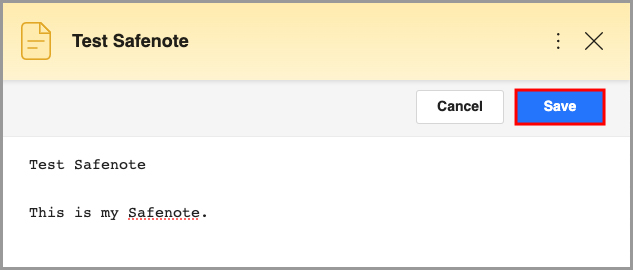
RoboForm Menu Bar Icon
- Click the RoboForm Menu Bar icon. Then, click the dropdown arrow next to “Logins” and select “Safenotes” from the menu.
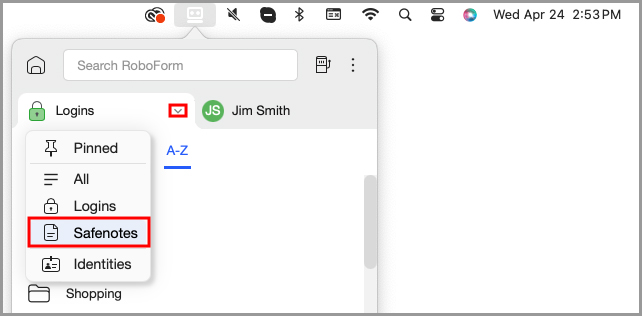
- Click the blue [ + ] button in the bottom right.
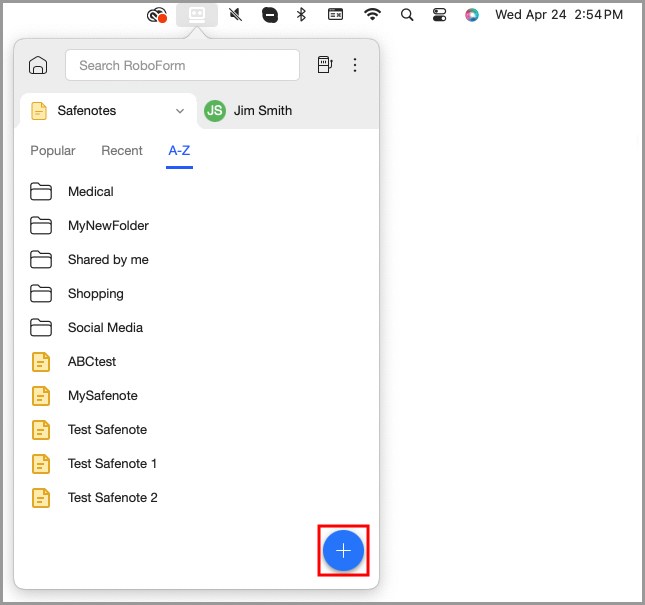
- The "Create New Safenote" window will appear. In this window, you can name your Safenote by filling out the "Name" field. When you are finished, click the "OK" button.
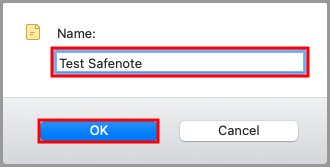
You will be brought to the Editor where you can view and edit your new Safenote. Fill out the Safenote as you wish, and then click the “Save” button at the top of the Editor to save your changes.
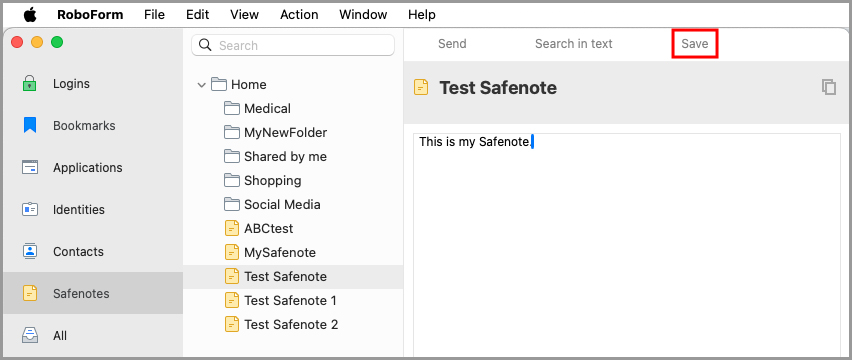
RoboForm Editor
- Click the [ ^ ] button (show hidden icons) in the lower right corner. Click the RoboForm icon. Select "Editor" from the menu.
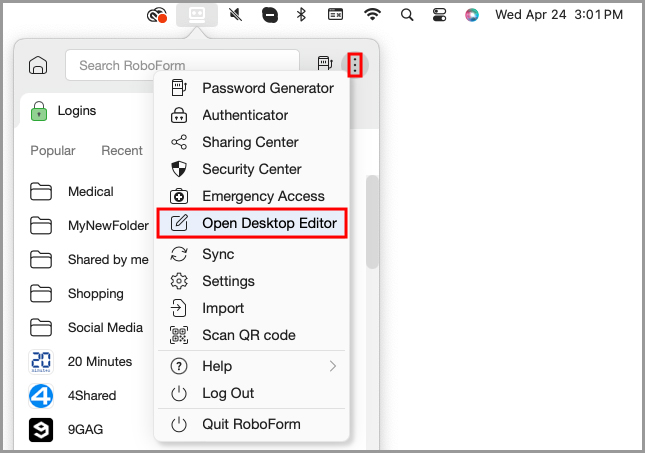
- Select “Safenotes” from the column on the left and click the [ + ] icon on the right.
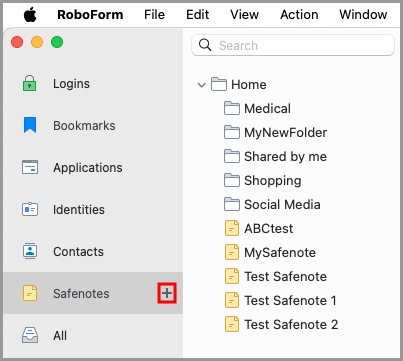
- Name your Safenote and click the “OK” button.
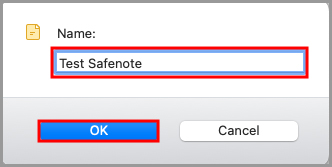
Fill out the Safenote as you wish, and then click the “Save” button in the upper middle of the editor to save your changes.
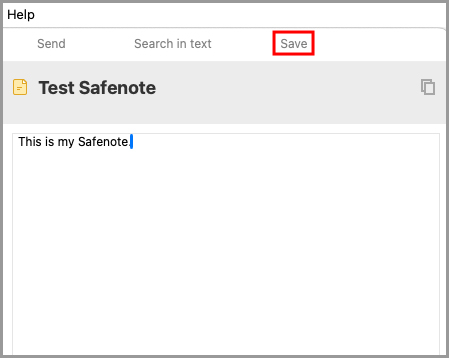
How to View Safenotes
RoboForm Extension
Select the Safenote in the Extension’s Safenote menu.
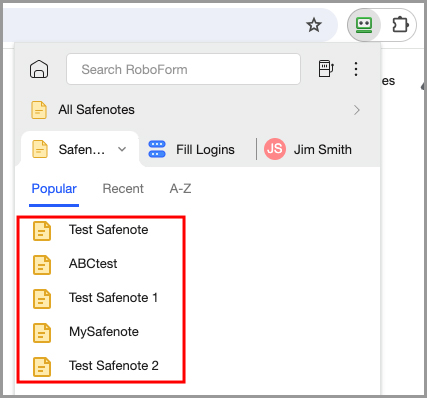
It will open on the Start Page.
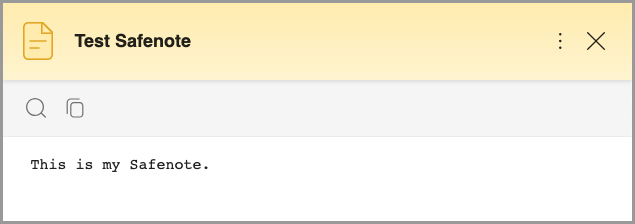
RoboForm Menu Bar Icon
Select the Safenote in the Safenote menu.
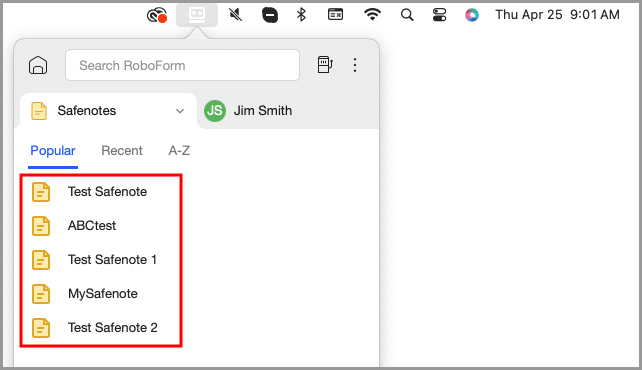
It will open on the RoboForm Start Page.
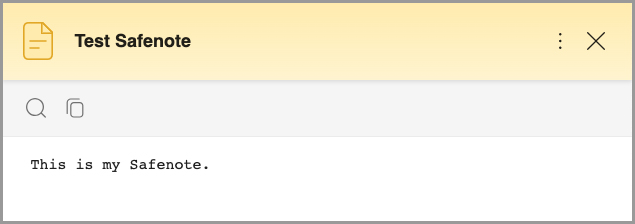
RoboForm Editor
Select the Safenote in the Safenote menu. It will appear in the Details Pane (right side) of the RoboForm Editor.
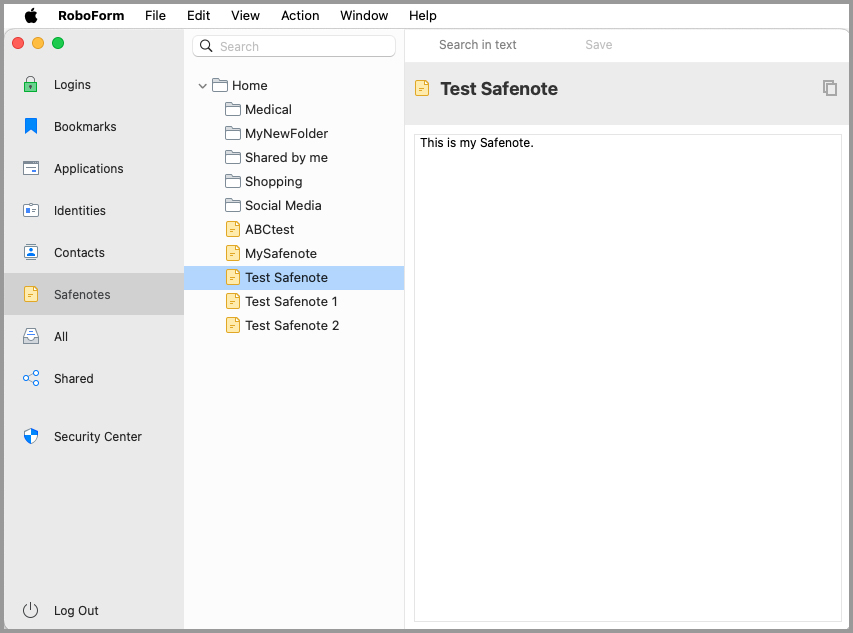
In the RoboForm Menu Bar icon, there are options to sort your Safenotes by Popular (popularity), Recent (recently used), and A-Z (alphabetical).
Right Clicking the Safenote in the Menu Bar Safenotes Menu will provide you with the following options:
- View - Opens the web page in a new tab.
- Copy Text - Copies the URL of the Bookmark to your clipboard.
- Rename - Allows you to rename the Bookmark.
- Delete - Deletes the Bookmark.
- Send… - Allows you to send the Bookmark to another RoboForm user.
- Sharing… - Allows you to share the Bookmark with another RoboForm user.
- Add to Pinned - Adds the Bookmark to your Pinned list.
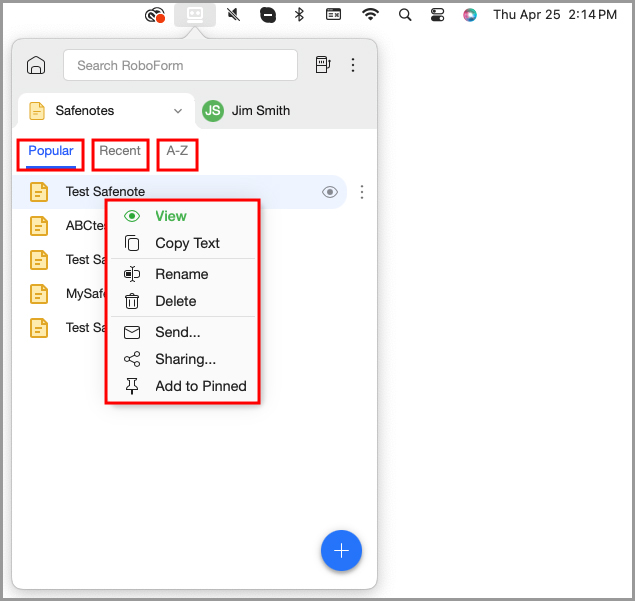
In the RoboForm Extension, there are options to sort your Safenotes by Popular (popularity), Recent (recently used), and A-Z (alphabetical).
Clicking the 3 dots on the right of an individual Safenote in the Extension’s Bookmarks Menu will give you the following options:
- View - Opens the web page in a new tab.
- Copy Text - Copies the URL of the Bookmark to your clipboard.
- Rename - Allows you to rename the Bookmark.
- Delete - Deletes the Bookmark.
- Send… - Allows you to send the Bookmark to another RoboForm user.
- Sharing… - Allows you to share the Bookmark with another RoboForm user.
- Add to Pinned - Adds the Bookmark to your Pinned list.
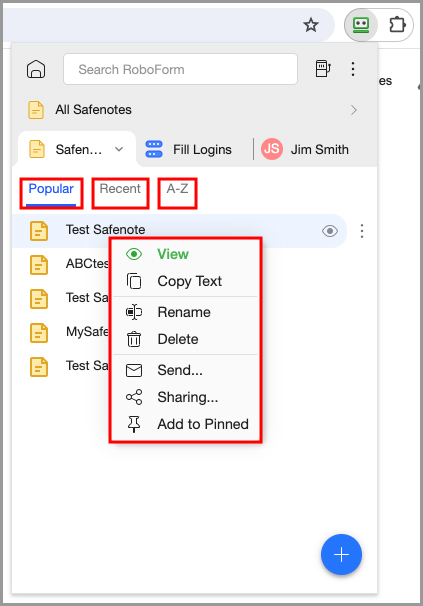
There are additional Safenote Options in the RoboForm Editor which are detailed in Chapter 8: Roboform Editor.
Chapter 7: Identities
Identities are profiles containing personal data which you can save within RoboForm. RoboForm can automatically fill non-password forms (e.g., Online Shopping Checkouts, Sign Up Forms) with information from your saved Identities.
Creating an Identity
Creating an Identity through the RoboForm Extension:
- Open your browser and click the RoboForm extension icon. Then, click the house icon in the upper left corner of the extension’s menu.
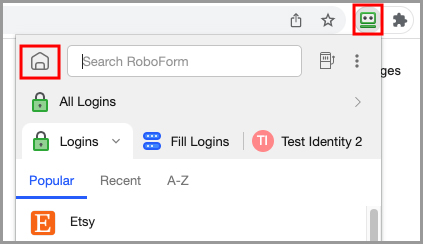
- You will now be on the Start Page. Select the "Identities" tab from the column on the left, and then click the blue [ + ] button in the bottom right corner.
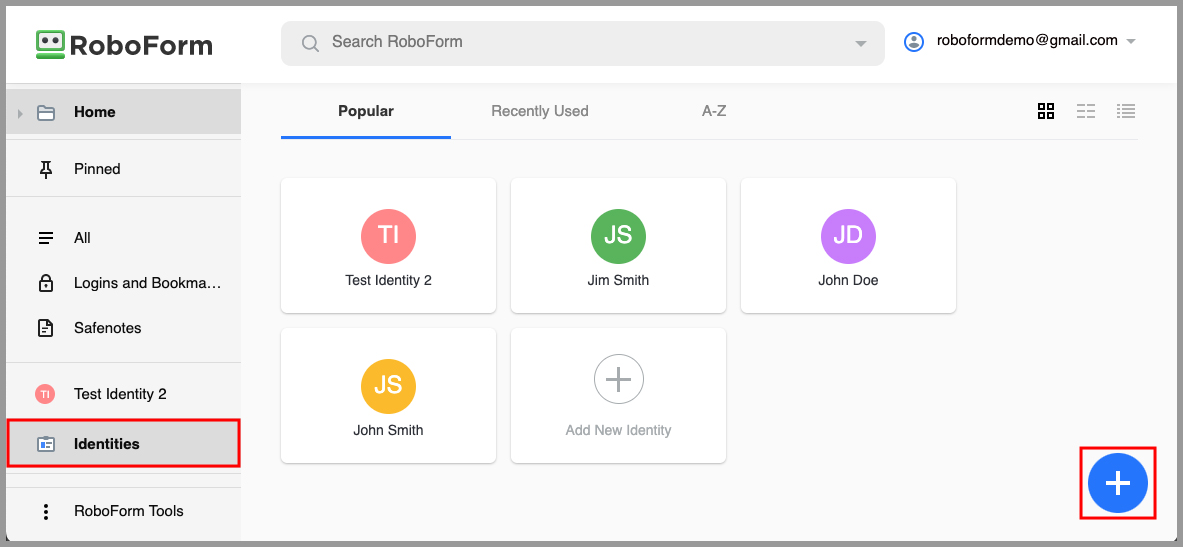
- The Create New Identity window will appear. Within this window, you can name your identity and select the country applicable to it. After inputting this information, click the blue “Next” button.
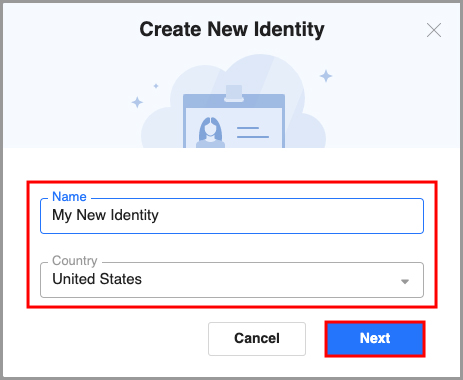
- Click the "Save" button when you have entered your information.
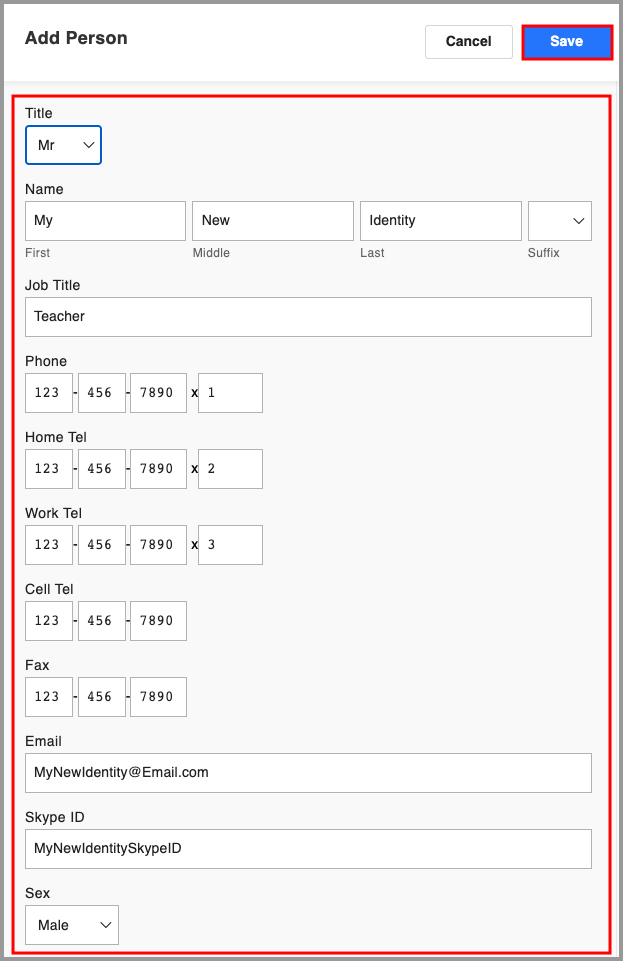
- Within your Identity, you can include the following categories of information:
- Person - Personal information for the Identity,
- Business - Workplace information for the Identity
- Passport - Passport details for the Identity
- Address - Address for the Identity
- Credit Card - Credit card details for the identity
- Bank Account - Banking information for the identity
- Car - Vehicle details for the identity
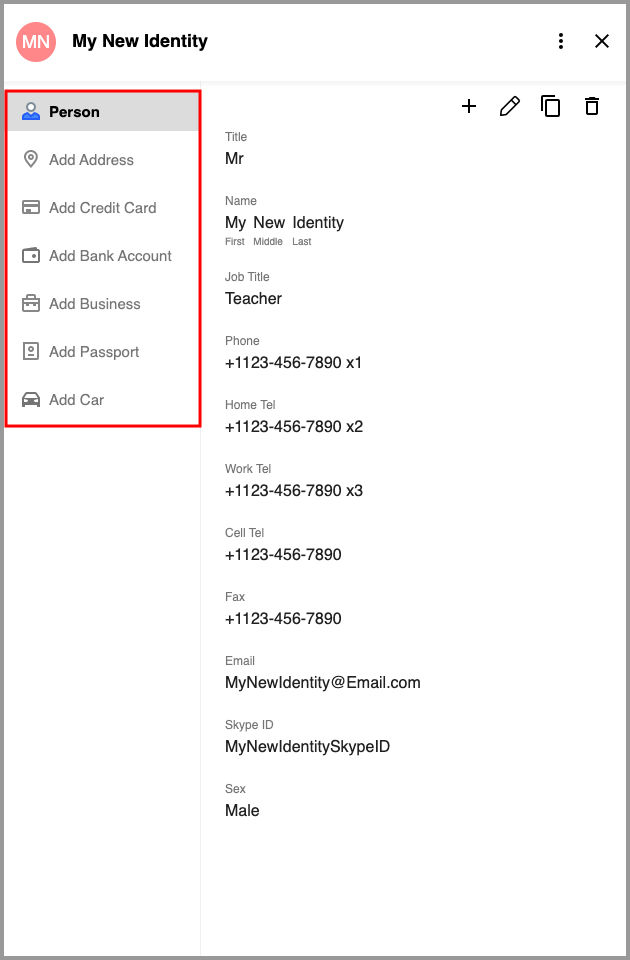
Creating an Identity through the RoboForm Editor:
- Click the RoboForm Menu Bar icon. Click the 3 dots in the upper right corner. Then, select "Open Desktop Editor" from the menu.
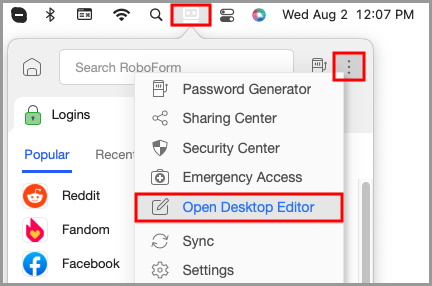
- In the RoboForm Editor, click the “ + ” button next to the Identities tab in the column on the left.
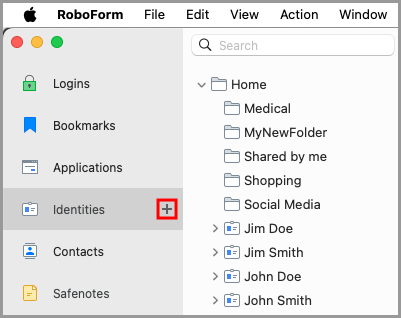
- The Create New Identity dialog will pop up. Name the Identity, and select the appropriate Country.
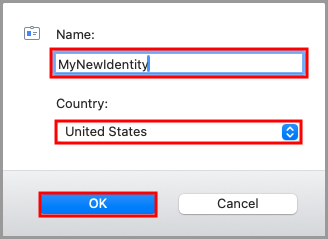
- Click the “OK” button once you are done.
- Within your Identity, the following Identity Elements provide you with organized storage of the Identity’s information:
- Person - Personal information for the Identity,
- Business - Workplace information for the Identity
- Passport - Passport details for the Identity
- Address - Address for the Identity
- Credit Card - Credit card details for the Identity
- Bank Account - Banking information for the Identity
- Car - Vehicle details for the Identity
- Custom - Custom fields for the Identity.
- Click the "Save" button when you have entered your information.
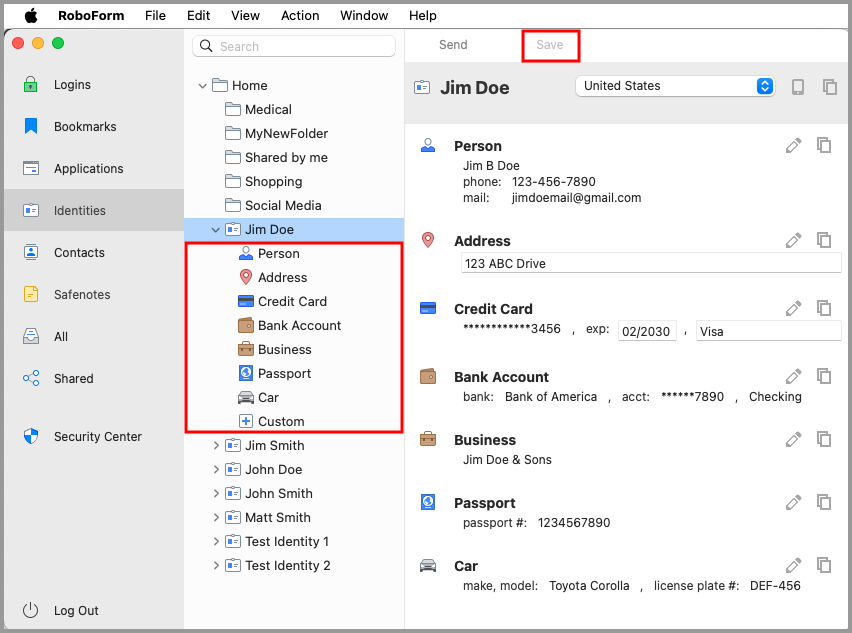
How to Add another Element
- Right click the Element you have multiple of and select the “New” option.
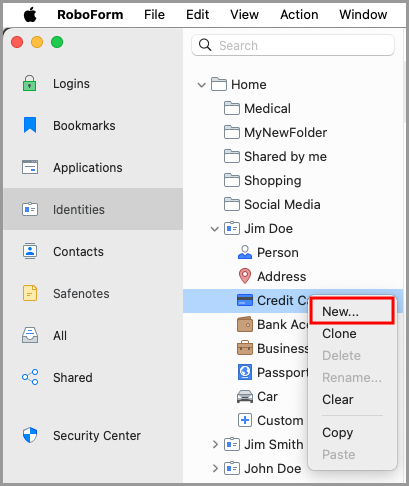
- Rename the new element by right clicking it and selecting “Rename” from the menu.
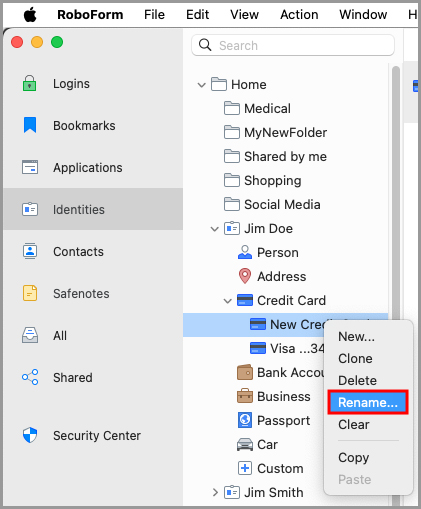
- Then, select the New [Element] and you will be able to fill the Contact Fields of the new Element in the Editor. Once you have filled them out as you wish, click the Save button in the upper right.
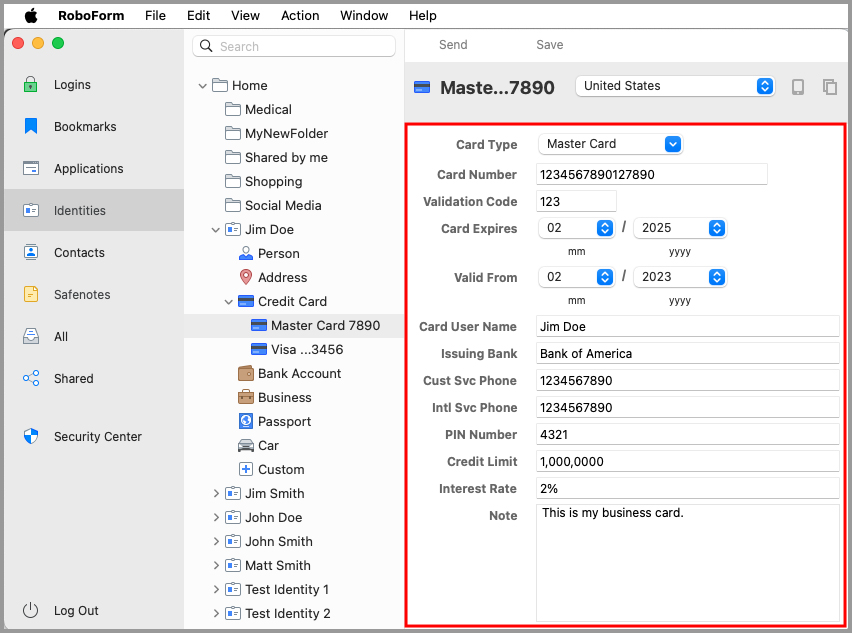
Custom Fields
Custom is for any other fields that are not covered in RoboForm.
How to Use Custom Fields
- Click the RoboForm icon in the top right of your screen on the Menu bar. Then, click the 3 dots in the upper right corner. Select "Open Desktop Editor" from the menu.
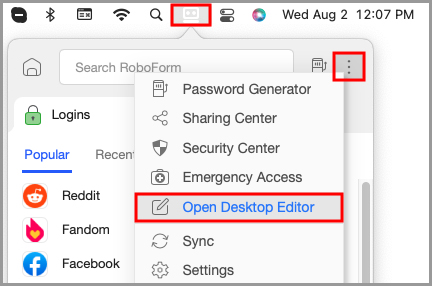
- Select "Identities" from the column on the left, and then click the dropdown arrow to the left of the Identity you would like to add a Custom Field to. From there, select the "Custom" option.
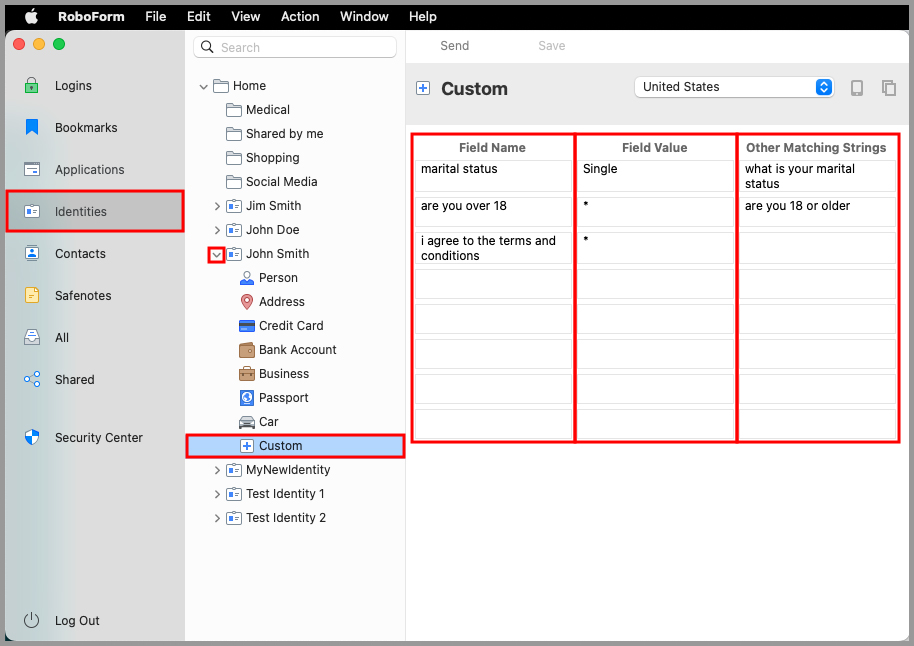
Using an Identity
- Navigate to a website which contains forms you need to fill out, and click the RoboForm autofill icon. Then, select the identity you wish to fill from and click the "Fill" button.
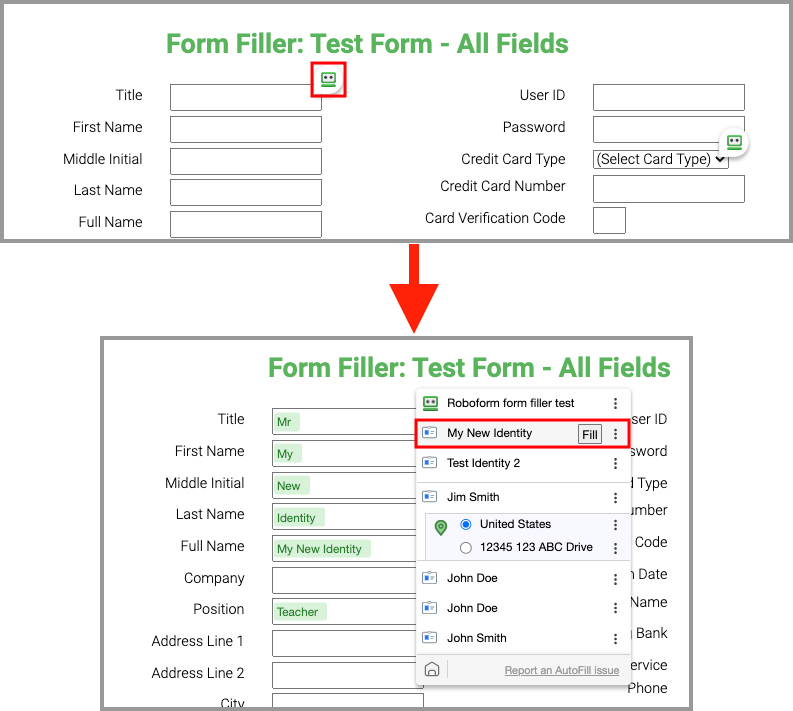
- The information saved within that Identity will automatically be filled into the appropriate lines within the form.
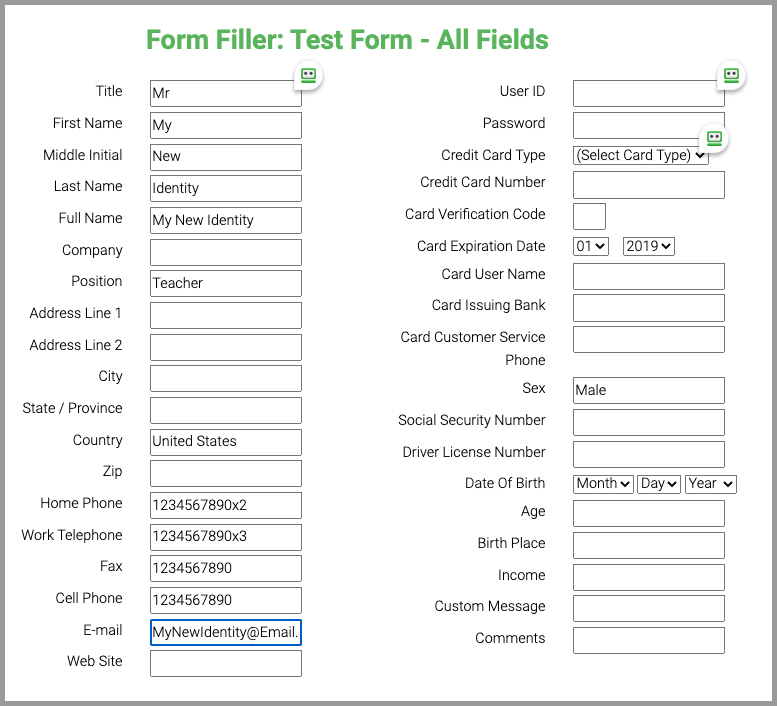
More Options
Clicking the 3 dots on the right of an Identity in the Extension’s Identity menu will give you options such as Fill Forms, Edit, Rename, Delete, Send, Sharing, and Add to Pinned.
Clicking the 3 dots on the right of an Identity in the Menu Bar Icon’s Identity menu provides similar options.
Chapter 8: RoboForm Editor
The RoboForm Editor is a tool to organize your RoboForm Data. The Editor allows you to view, edit, and create individual RoboForm items and organize them into folders.
Accessing the Editor
The Editor can easily be found by one of these ways:
- Opening the RoboForm Menu Bar, clicking the 3 dots in the upper right corner, and selecting “Open Desktop Editor” from the menu.
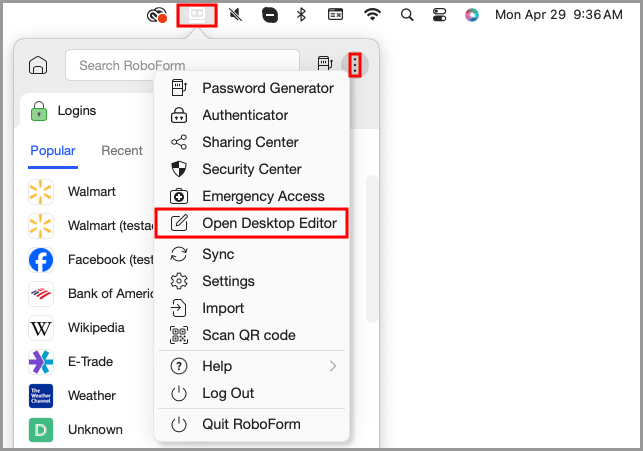
- Searching for RoboForm using your Mac’s Spotlight Search.
To have quick access, right click the RoboForm Editor and add it to your Dock.
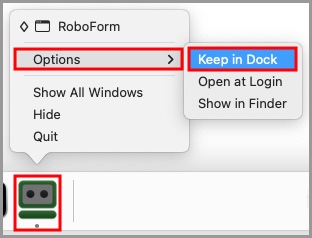
Editor Overview
There are three sections in the RoboForm Editor:
- The Left Panel shows the RoboForm Menu button at the top, the Logins, Bookmarks, Applications, Identities, Contacts, Safenotes, All, and Shared tabs in the middle, and lastly the Security Center.
- The Navigation Pane in the middle has multi-level navigation of the selected tab’s folders and items.
- The Details Pane on the right shows the contents or the details of the selected item or folder from the Navigation Pane.
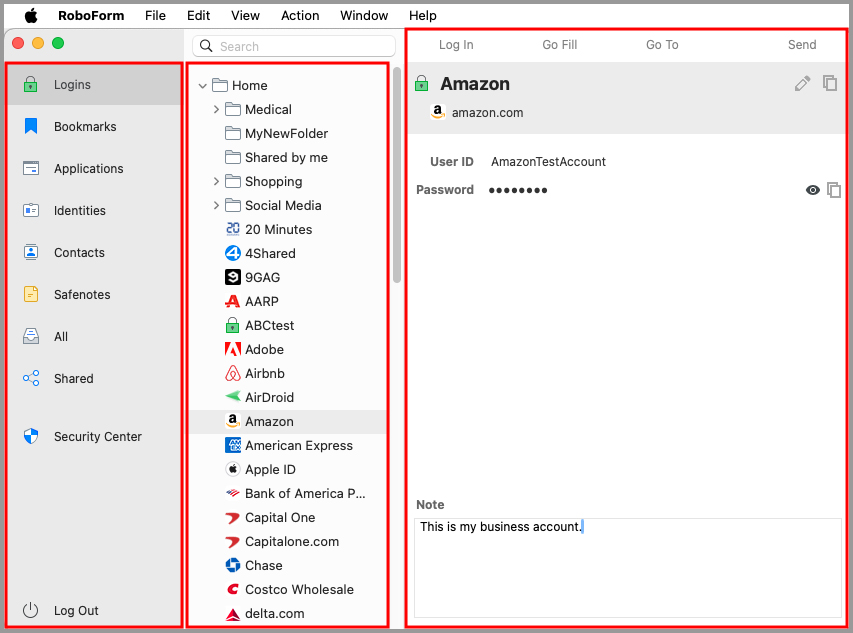
Menu Bar Options
The next section will go through each menu tab (e.g. RoboForm, File, Edit, etc.) and its options.
RoboForm App Menu
With the Editor open, the RoboForm App Menu will appear in the upper left corner of your screen in the Menu Bar. This is a menu for RoboForm and is only visible when the RoboForm Editor is open:
- About - Shows the version of RoboForm that you are using and your license expiration.
- RoboForm Start Page - Opens the RoboForm Start Page in a new window in your browser. You can view and access your RoboForm Data on the Start Page.
- Change Master Password - Allows you to change your Master Password. How to change your Master Password is covered in Chapter 18: Settings.
- Preferences - Opens the settings of RoboForm in a new window. Read more in Chapter 18: Settings.
- Feedback - Creates a diagnostic file of your RoboForm to send to the RoboForm Support Team.
- Renew RoboForm Premium - Will redirect you to the online store for RoboForm Premium.
- Services - Opens the Preferences for Mac. Read more in Chapter 18: Settings.
- Hide RoboForm - Minimizes RoboForm. Make RoboForm appear again by clicking the RoboForm Icon in the Dock along the bottom of the computer screen.
- Hide Others - Minimizes all open windows except RoboForm.
- Show All - Will open all minimized windows.
- Quit RoboForm - Closes the RoboForm Editor.
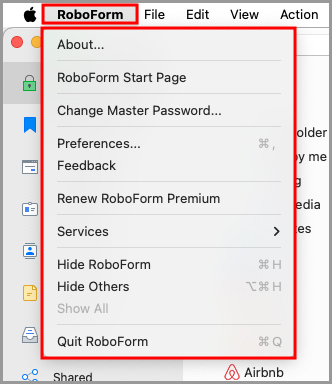
How to Submit a Support Ticket:
- Click the RoboForm App Menu and select the “Feedback” option.
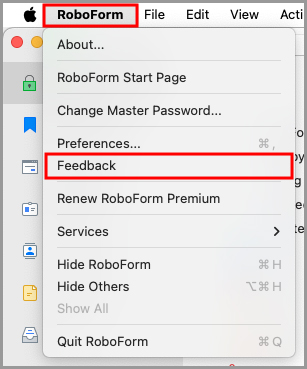
- A zipped diagnostic file will be created.
- Click “Attach Diagnostic” to attach the diagnostic file to the support ticket which will be sent to the RoboForm Support Team.
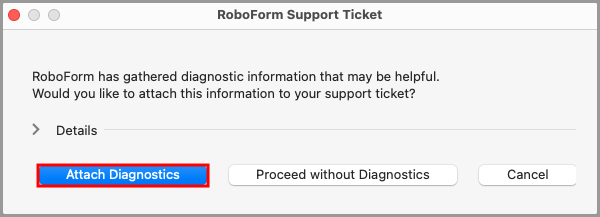
- You will be directed to RoboForm’s online support system. Select a topic for your ticket from the list.
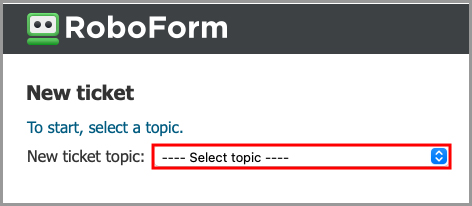
- You will be taken to the ticket creation page. Fill out a subject and a detailed description of the issue you are experiencing. Then, click the “Submit” button. This information will only be used for support purposes.
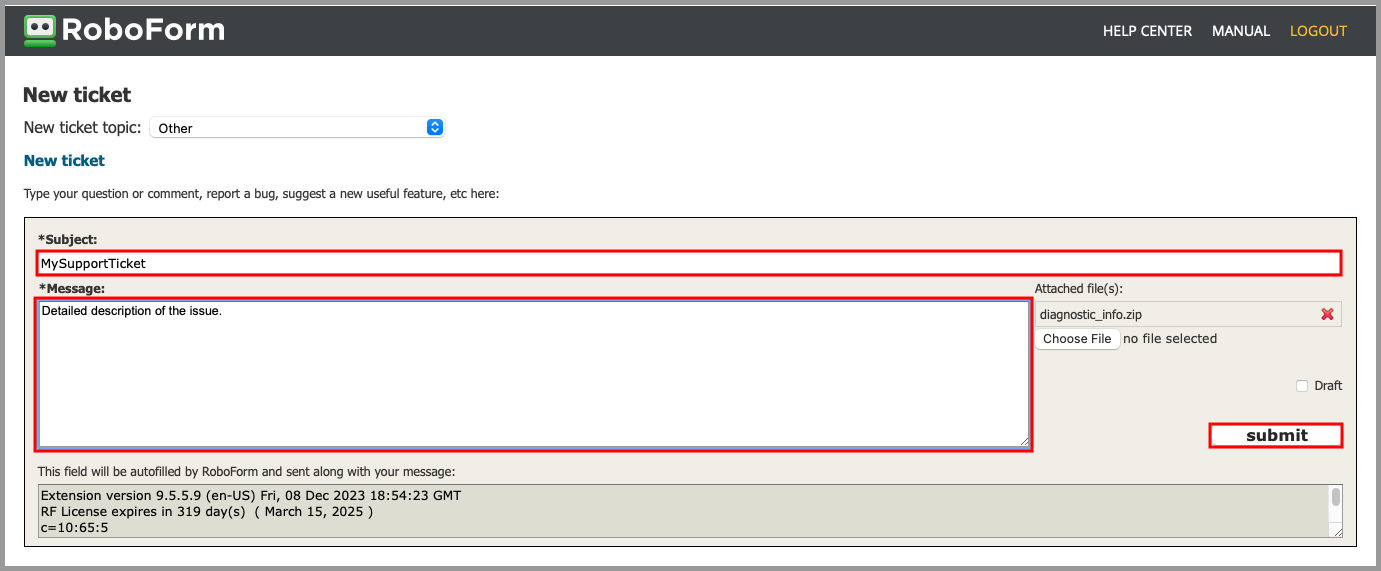
File
- New:
- New Folder... - Creates a new folder in the RoboForm Editor section that you are using.
- Create shared folder… - Creates a shared folder. You can learn more about how to create a shared folder in this chapter under Shared.
- New Identity - Creates a new Identity in the RoboForm Editor. Read more in > Identities in the Editor.
- New Contact - Creates a new Contact in the RoboForm Editor. Read more in Contacts in the Editor.
- New Safenote - Creates a new Safenote in the RoboForm Editor. Read more in Safenotes in the Editor.
- Print List… - Creates a printable list of either your Logins, Identities, or Safenotes. A new page appears in your browser that previews the printed list you selected. Print this browser page as you normally would.
- Import - Allows you to import any data from browsers or other password managers to RoboForm. For browsers, click the Import button next to the browser name. For other password managers, click Import from File and follow the directions on the page.
- Import into folder - Allows you to select a folder to import your data into.
- Export - Allows you to export your RoboForm Data to a location on your computer.
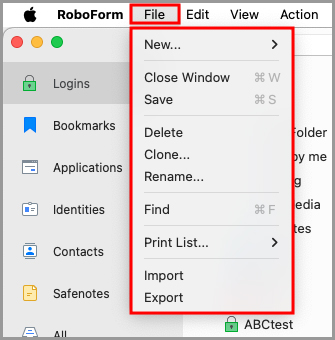
Edit
- Undo - Reverses the previous edit.
- Redo - Reverses the previously “undone” edit.
- Cut - Allows you to copy and remove an item from its original location.
- Copy - Allows you to copy an item.
- Paste - Places the copied item where you select.
- Delete - Removes the item.
- Select All - Selects all items.
- Search in Text - Opens a search toolbar near the top of the Editor. Your search query will be highlighted within the text. You are able to go between your search results, match the case of the search query, and search for the whole word.
- AutoFill:
- Contacts - Allows you to select a contact to AutoFill from.
- Passwords - Allows you to select a Login to AutoFill from.
- Start Dictation - Allows you to use a microphone to verbally dictate the text you wish to be filled into a field.
- Emojis and Symbols - Allows you to select emojis and alternate symbols from a menu.
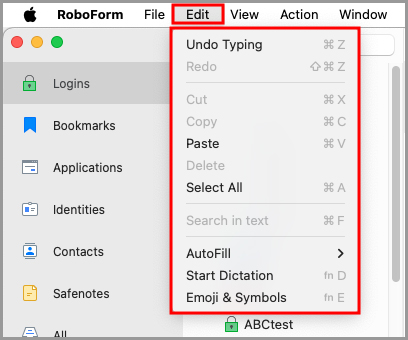
View
- Edit Values - Allows you to edit the information stored in an item.
- Details - Allows you to see additional information and details stored in an item.

Action
- Log In - Logs you into your selected Login with one click.
- Go & Fill - Takes you to the sign-in page for your saved Login and fills your information without submitting.
- Go To - Takes you to the sign-in page for your saved Login.
- Set as Default - Allows you to set an item as default.
- Add Field - Allows you to add a field to a Login.
- Add Login Tip - Allows you to add a Login Tip to a Login.
- Sharing… - Allows you to share an item with another RoboForm user.
- Send… - Allows you to send an item to another RoboForm user.
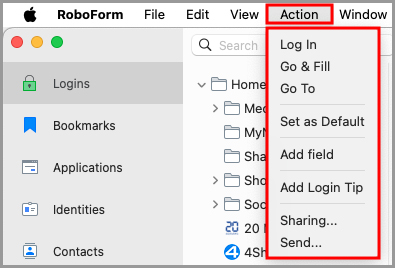
Window
- Minimize - Minimizes the current window.
- Zoom - Expands and contracts the current window.
- Move Window to Left Side of Screen - Shifts the window to the left side of the screen.
- Move Window to Right Side of Screen - Shifts the window to the right side of the screen.
- Replace Tiled Window - Replaces tiled window.
- Remove Window from Set - Removes the window from the set.
- Bring All to Front - Brings the RoboForm Editor to the front of all other windows.
- RoboForm - Brings up the RoboForm Editor if minimized.
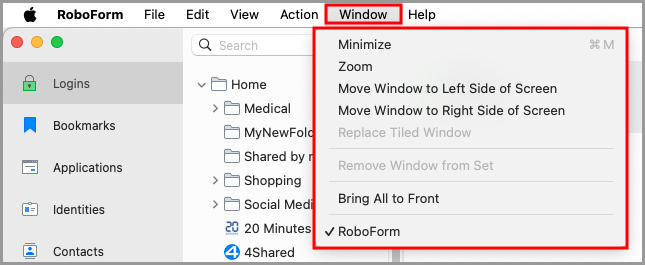
Help
- Search - Finds options within the RoboForm App Menu.
- RoboForm Help - Opens the RoboForm Manual in a new browser tab.

NOTE: The tabs for Edit, View, Action, and Window are visible in the RoboForm App Menu. However, these tabs either have general Mac options or are not applicable to RoboForm.
Navigation Pane Commands
There are some general Navigation Pane commands that apply to all categories in the RoboForm Editor.
At the top of the Navigation Pane, there is a Search Bar that will help you locate any RoboForm item within a category of RoboForm Data. For example, if you have selected Bookmarks in the Left Panel, you can only search for Bookmarks.

Right-clicking any item in the Navigation Pane will show the following commands:
- Rename - Changes the name of the item.
- Clone - Duplicates the item. The duplicated item will be labeled “Copy”.
- Delete - Removes the item.
- Copy - Copies the item.
- Cut - Removes the item and adds it to your clipboard.
- Sharing - Opens the item in RoboForm sharing. Read more in Chapter 12: Sharing and Sending.
- Send - Opens the item in RoboForm sending. Read more in Chapter 12: Sharing and Sending.
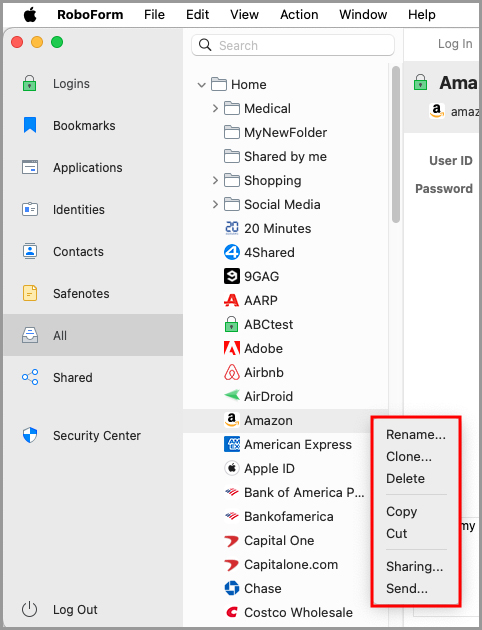
Right-clicking an Identity Element in the Navigation Pane will show the following commands:
- New - Creates a new Identity Element, see above: Multiple Identity Elements.
- Clone - Duplicates an Identity Element. The duplicated item will be labeled “Copy”.
- Delete - Removes an Identity Element.
- Rename - Changes the name of an Identity Element.
- Clear - Removes all the information in Identity Fields within an Identity Element.
- Copy - Copies the text of the Identity Element.
- Paste - Pastes the text of an Identity Element.
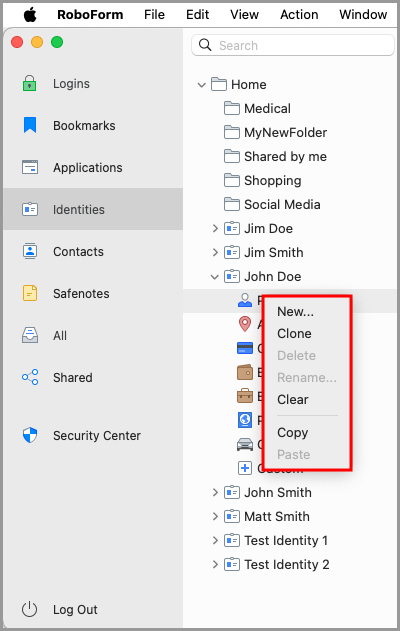
Right-clicking a folder in the Navigation Pane will show the following commands:
- New Folder - Creates a new folder within the folder selected.
- Rename - Changes the name of the folder.
- Delete - Removes the folder and its contents.
- Copy - Copies the contents of the folder.
- Cut - Copies and removes the folder from its location.
- Paste - Allows you to paste items from your clipboard into the folder.
- Share Folder - Allows you to share your folder with other RoboForm users.
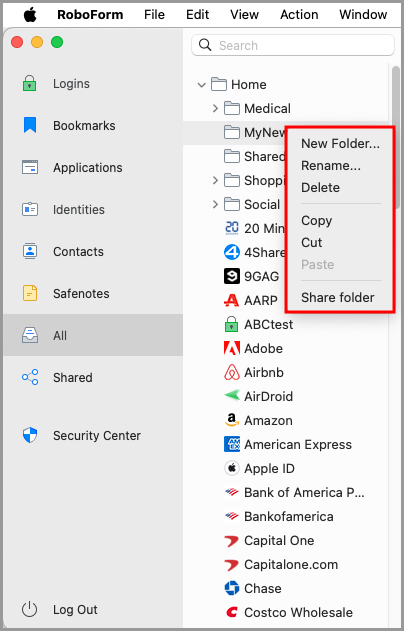
Logins in the Editor
Logins are found in the “Logins” tab. Within the Logins tab, all your Logins are organized alphabetically in the Navigation Pane. From here, you can go to web pages, fill forms, and edit your Logins.
NOTE: You can’t create a Login in the Editor. Create a Login by going to the website and logging in; RoboForm will offer to save a new Login for that site. Read more about creating Logins in Chapter 4: Logins.
Using Logins in Editor
- Selecting a Login in the Navigation Pane will open its information in the Details Pane. This includes the Name, Website, User ID, and Password. Clicking the Eye Icon will reveal or hide the password.
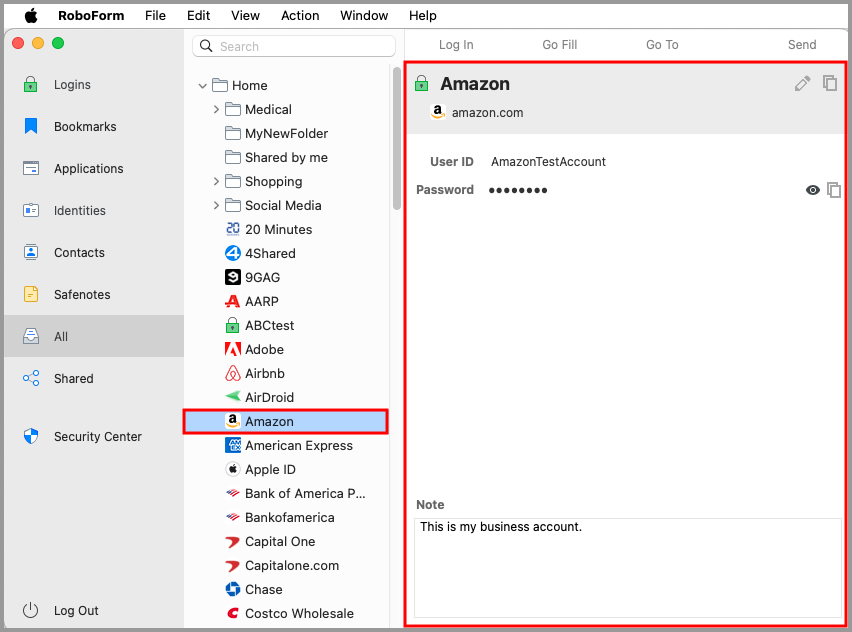
- The Editor Toolbar at the top of the Details Pane has the following options:
- Login - Opens the website of the Login and automatically logs you in.
- Go Fill - Opens the website of the Login and fills the forms.
- Go To - Opens the website of the Login.
- Send - Allows you to send the Login to another RoboForm user.
- The Pencil Icon - Allows you to edit the Login. By clicking it, you can edit the URL (for Go To command and Matching Logins) and the user details.
- The Copy Icon - Copies the whole text of the Login.
- The Note - At the bottom of the page keeps track of password changes and allows you to add any notes to it.
- Click the Save Button in the top-right corner to save any changes you made.
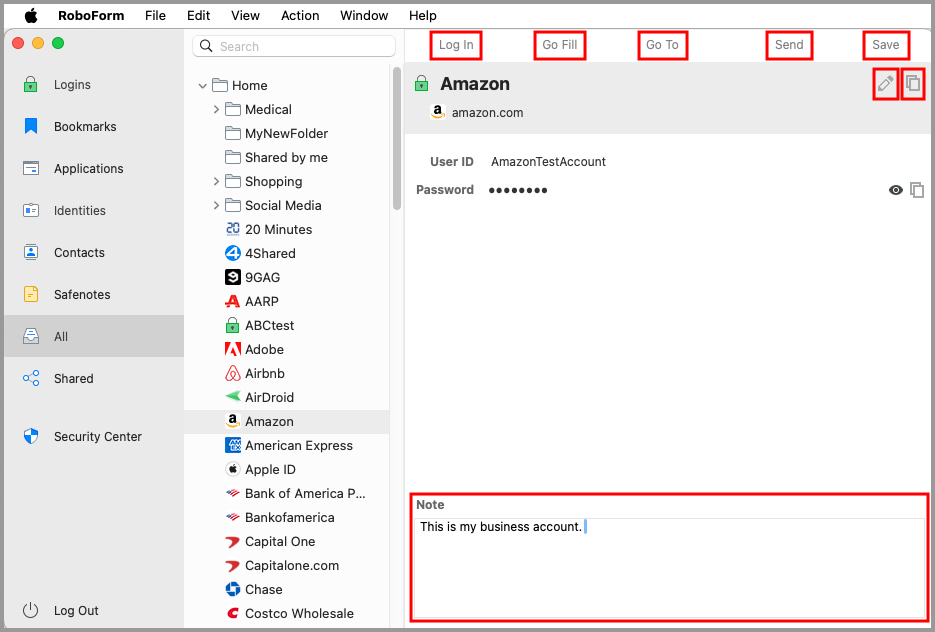
Bookmarks in the Editor
Bookmarks are found in the “Bookmarks” tab. Within the Bookmarks tab, all your Bookmarks are organized alphabetically in the Navigation Pane. This is where you can view, edit, and go to your Bookmarks.
NOTE: You can’t create a Bookmark in the Editor. You can read about how to create one in Chapter 5: Bookmarks.
- Selecting a Bookmark in the Navigation Pane will open its information in the Details Pane. This includes the Website, URL, and any Notes.
- The Editor Toolbar at the top has the following Bookmark options:
- Go To - Opens the website of the Bookmark.
- Send - Opens the Bookmark in RoboForm sending. Read more about sending in Chapter 13: Sharing and Sending.
- The Pencil Icon - Allows you to edit the Bookmark. By clicking it, you can edit the URL (for Go To command) and the Bookmark Note.
- The Copy Icon - Copies the whole text of the Bookmark.
- The Note - Allows you to add notes.
- Click the Save Button to save any changes you made.
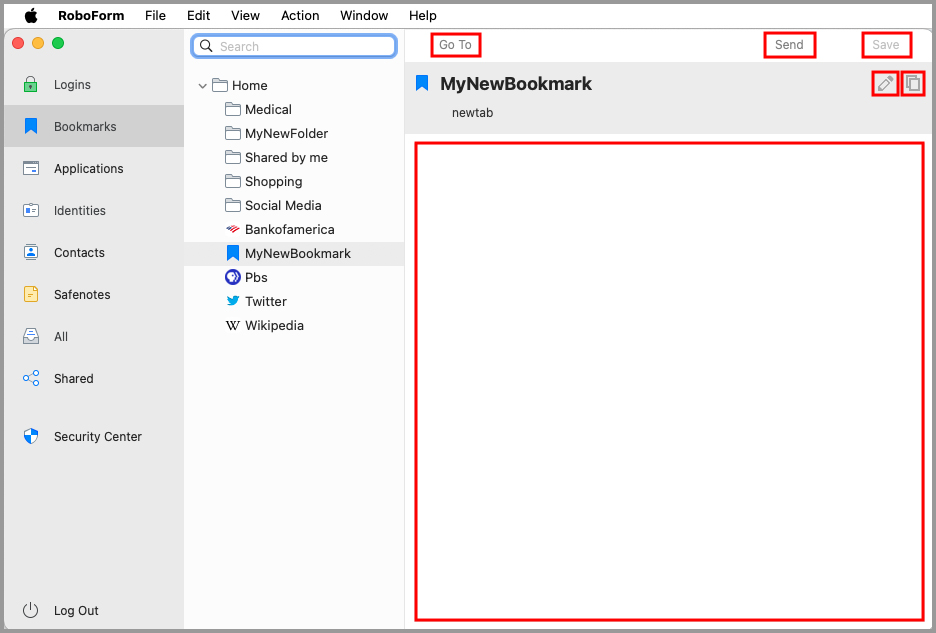
You can Drag and Drop the URL of a bookmark into the address bar. While in Edit mode, simply click and hold an individual field - in this case, the URL - and drop it where you like on the page.
Applications in Editor
Applications are found in the “Applications” tab. Within the Applications tab, all your Application Logins are organized alphabetically in the Navigation Pane. Although you may have Application Logins in your RoboForm account, RoboForm on Mac does not currently support applications that require login. You can only view and edit in the Mac editor.
- Selecting an Application in the Navigation Pane will open its information in the Details Pane.
- The Pencil Icon - Allows you to edit the Bookmark. By clicking it, you can edit the URL (for Go To command) and the Bookmark Note.
- The Copy Icon - Copies the whole text of the Bookmark.
- The Note - Allows you to add notes.
- Send - Opens the Bookmark in RoboForm sending. Read more about sending in Chapter 13: Sharing and Sending.
- Click the Save Button to save any changes you made.
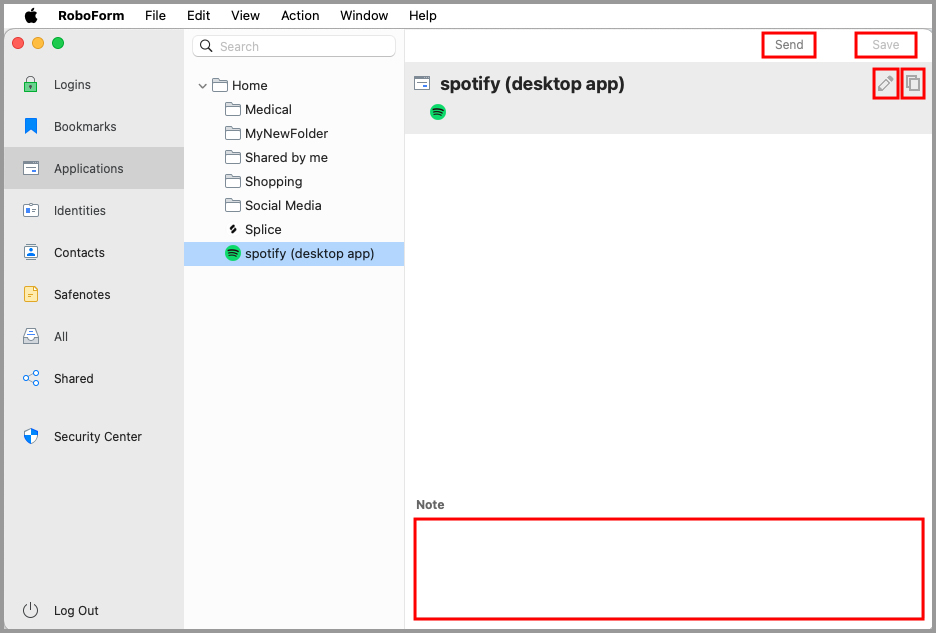
Application Logins share the same functions in the Editor as normal Logins. Please refer to the “Logins in Editor” portion of this chapter to learn more about using Applications in the Editor.
NOTE: If you want to remove all changes to your Application Login, click Drop Changes.
Identities in Editor
Identities are found in the “Identities” tab. Within the Identities tab, all your Identities are organized alphabetically in the Navigation Pane.
NOTE: Go to Chapter 7: Identities if you would like to read about:
- What are Identity Elements?
- How to Create an Identity?
- How to Add and Edit Personal Details in Identity?
Selecting a Login in the Navigation Pane will open an Identity Summary in the Details Pane. Expanding the Identity folder in the Navigation Pane will show all the Identity Elements. Selecting an Identity Element will open its information in the Details Pane. Each Identity Element is made up of individual Identity Fields (e.g., Date of Birth), or distinct personal details.
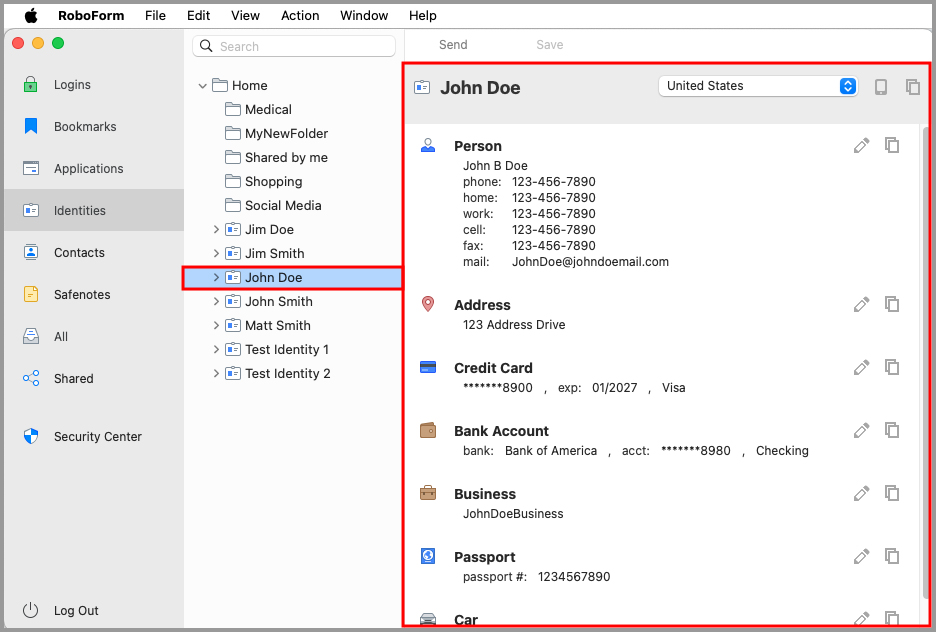
- Send - Opens the RoboForm Send dialogue in a new window.
- Click the Save Button to save any changes you made.
- The Pencil Icon - Allows you to edit the Identity Element.
- The Copy Icon - Copies the whole text of the Identity Summary or an Identity Element.
- Phone Prefix - Allows you to format your Identity’s phone number according to the form you are filling:
- None - The default for calling within the country.
- National Prefix - The number added to the front of a phone number to call long distance within the country.
- Country Codes - The number added to the front of a phone number to call internationally.
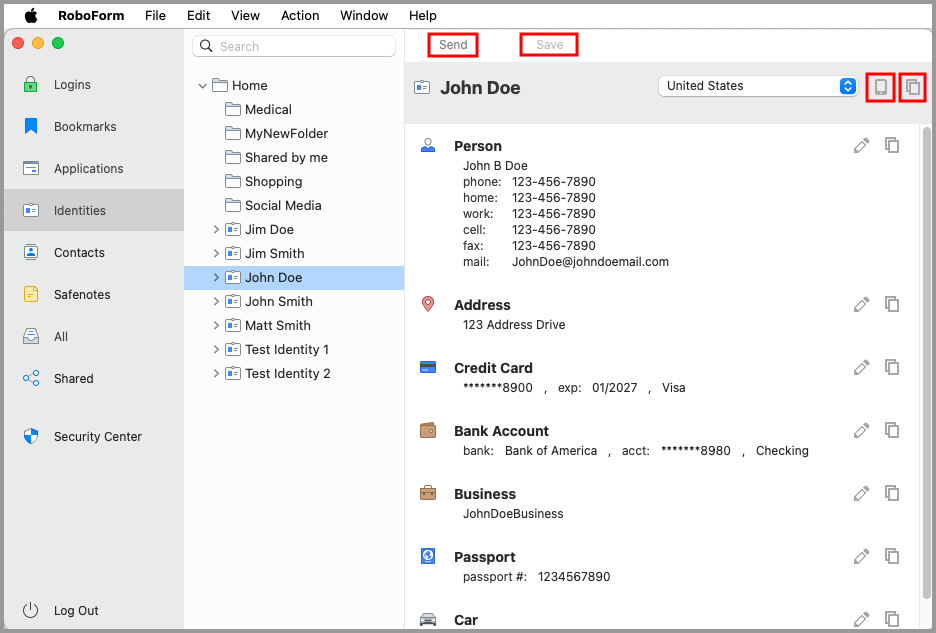
Filling Forms from RoboForm Editor
- Navigate to the form you wish to fill in your browser.
- Select the Identity in the Editor.
- Drag and drop the Identity information from the Editor into the form.
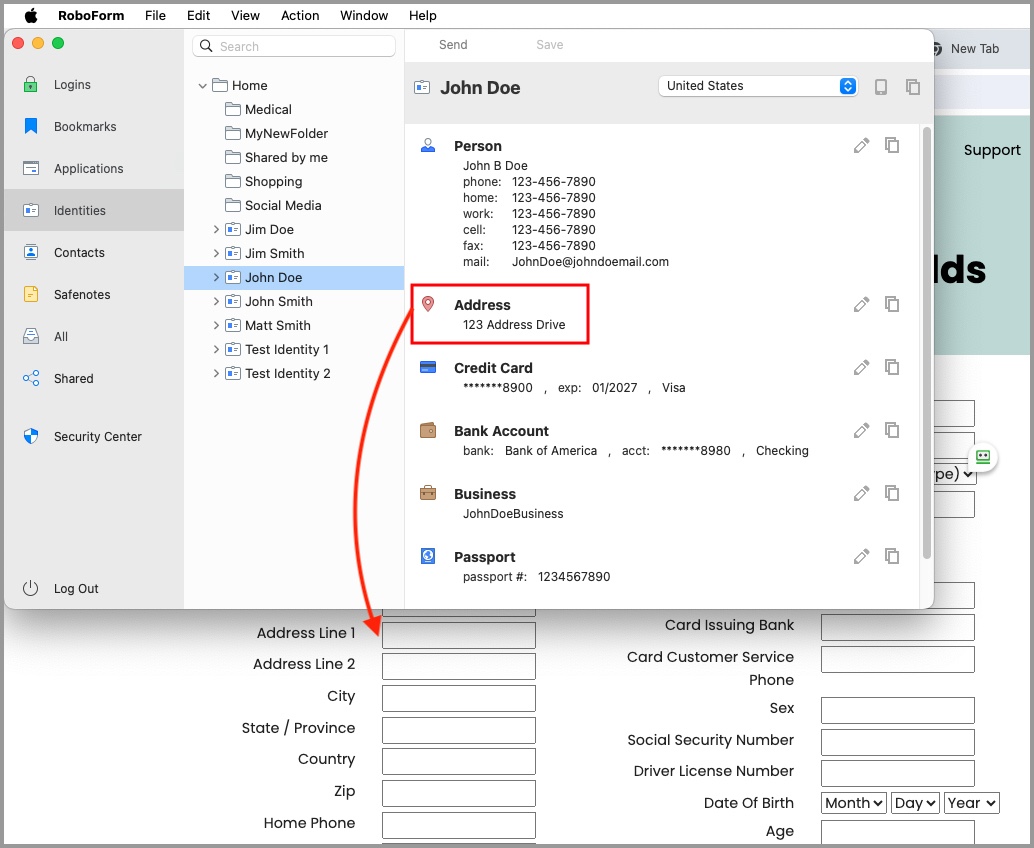
Contacts in Editor
Contacts are found in the “Contacts” tab. Within the Contacts tab, all your Contacts are organized alphabetically in the Navigation Pane. Contacts are where you can store an individual’s contact information, similar to a phone-book. The RoboForm Editor is your main tool to create and edit contacts. From here you can create contacts, edit them, and fill forms with them.
- Selecting a Contact in the Navigation Pane will open the Contact Summary in the Details Pane. Expanding the Contact folder in the Navigation Pane will show all the Contact Elements (E.g. Person, Business, Address).
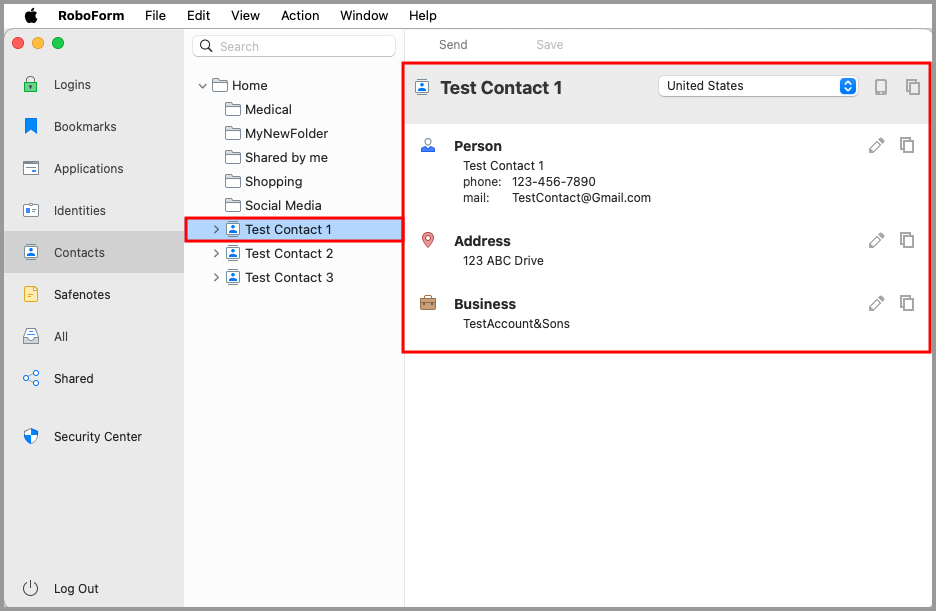
Selecting a Contact Element will open its information in the Details Pane.
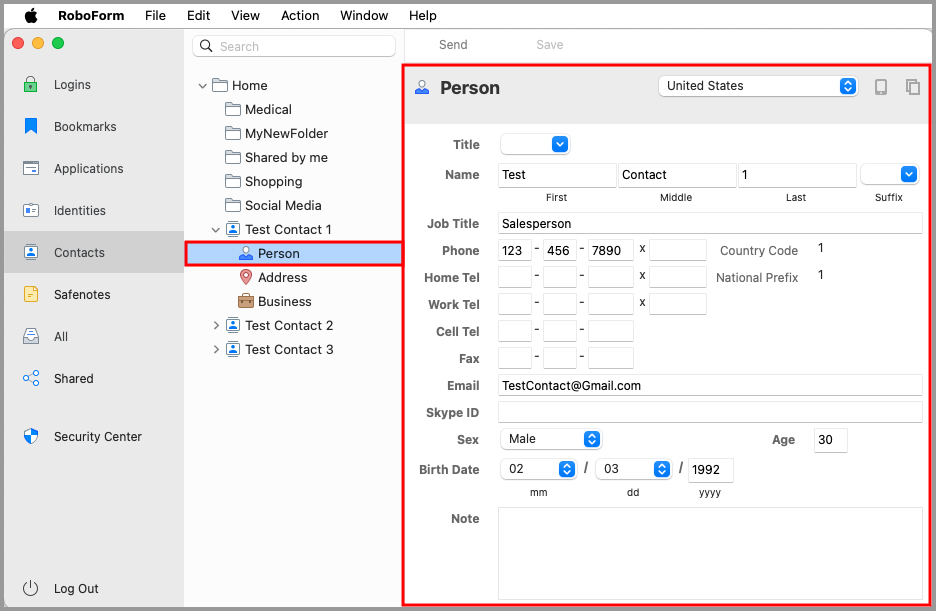
- Person has all the fields associated with an individual such as name, phone numbers, etc.
- Address is your Contact’s physical location.
- Business is the business entity that the Contact is associated with.
- The Pencil icon allows you to edit the Contact.
- The Copy icon copies the whole text of the Contact.
- Click the Save button to save any changes you made.
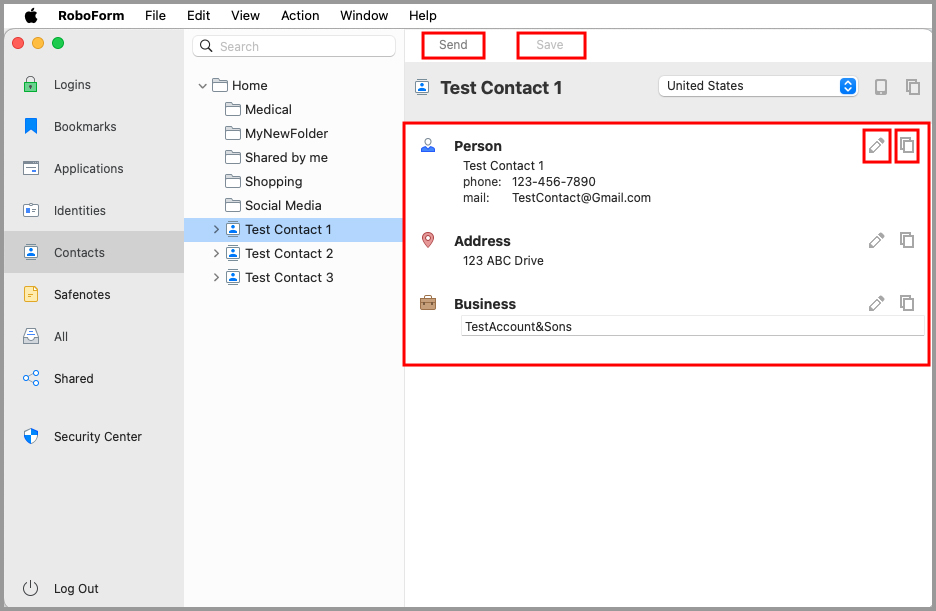
You can Drag and Drop the text of a Contact into a web page. Simply click and hold the name of an individual field (E.g. Phone Number) and drop it where you like on the page.
NOTE: You don’t have to enter any dashes or spaces when you are typing in fields with numbers.
How to Create a Contact in Editor
- In the RoboForm Editor, click the “ + ” next to the Contact tab.
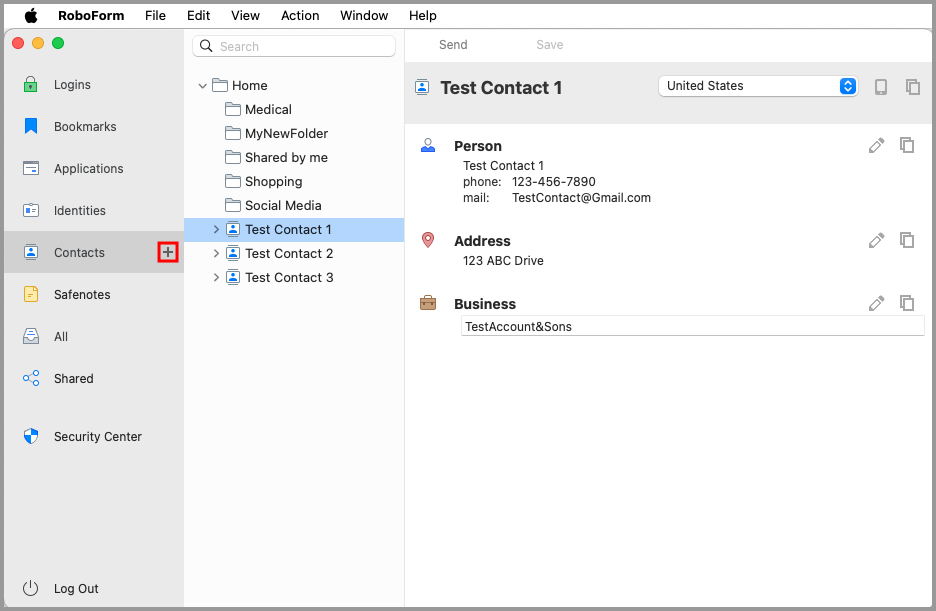
- The New Contact dialog will pop up. Name the Contact, and select its Country.
- Click the “Ok” button once you have entered the information.
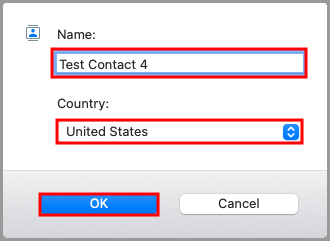
How to Add another Element
If you have more than one business or address for a contact, you can create Multiple Contact Elements.
- Right click the Element and select “New” from the menu.
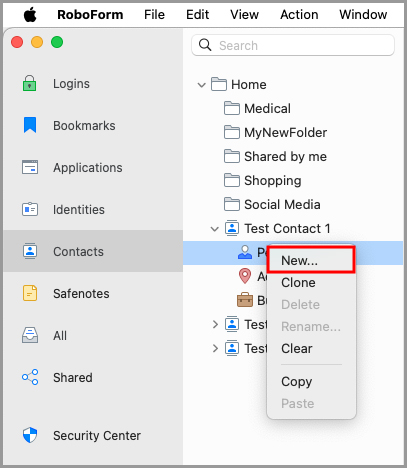
- Rename the new element by right clicking it and selecting “Rename” from the menu.
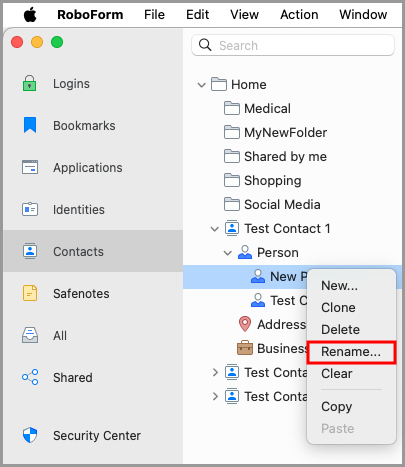
- Then, select the New [Element] and you will be able to fill the Contact Fields of the new Element in the Editor.
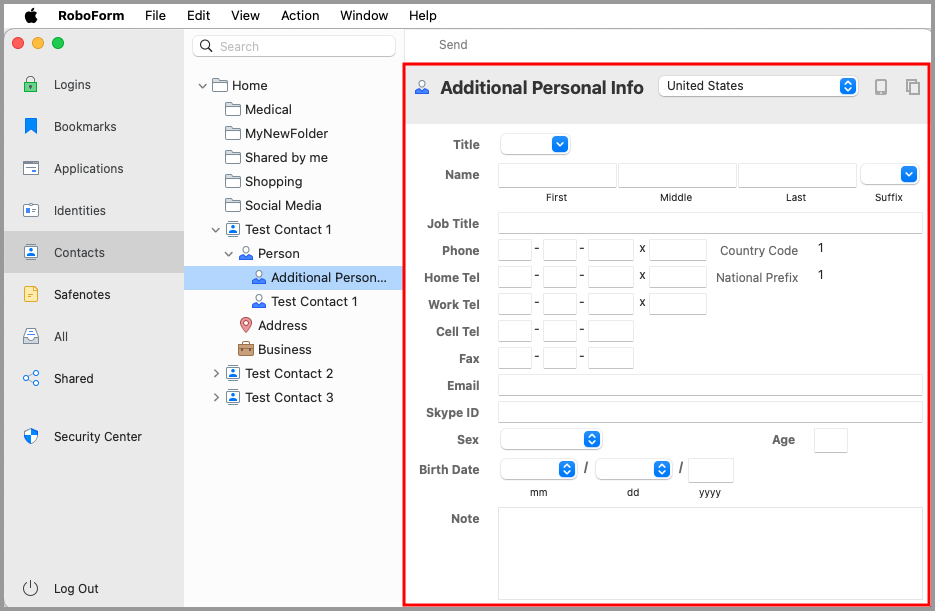
NOTE: Your original Element will now be labeled “[Main]” on the left side of the editor. Right click the original Element and select Rename to change its name.
How to Fill Forms with Contacts
- Navigate to the form you wish to fill in your browser.
- Select the Contact.
- Drag and drop the Contact information from the editor into the form.
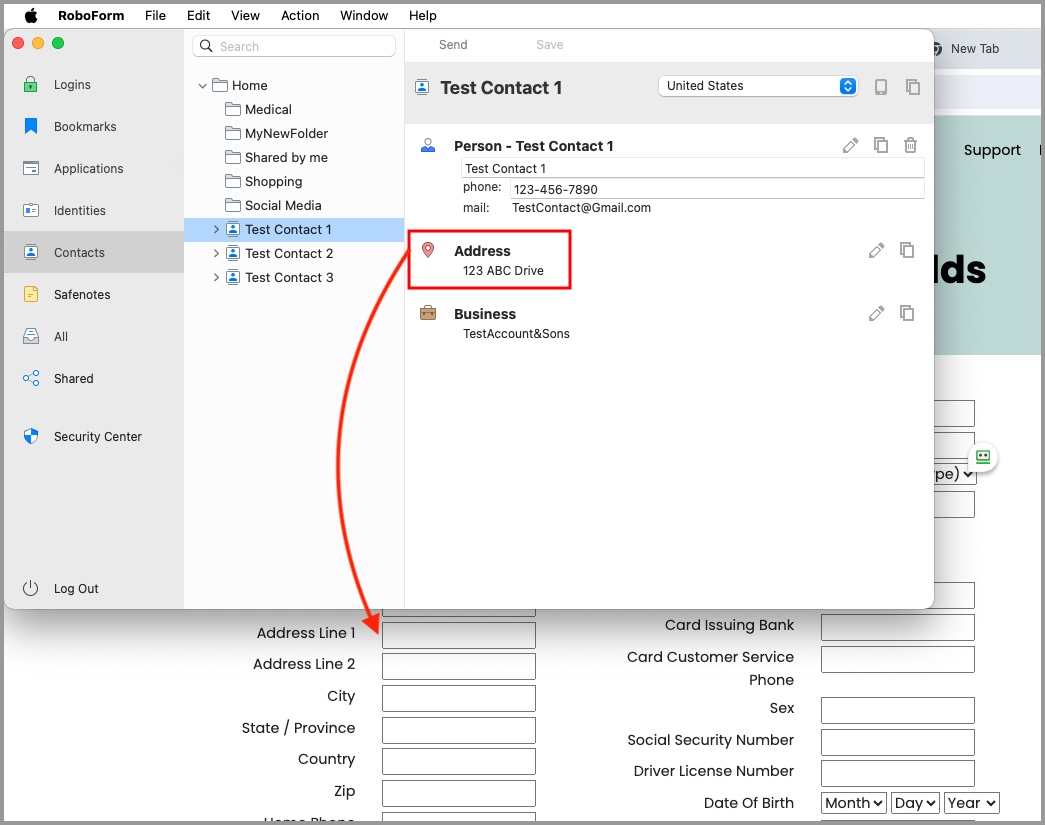
The Phone Prefix, Add to, and More options for Contacts work identically to Identities.
Safenotes in Editor
Safenotes are found in the “Safenotes” tab. Within the Safenotes tab, all your Contacts are organized alphabetically in the Navigation Pane. This is where you can view and edit your Safenotes.
NOTE: Refer to Chapter 6: Safenotes for how to create a Safenote.
- Selecting a Safenote in the Navigation Pane will open its information in the Details Pane.
- The Copy icon copies the whole text of the Safenote.
- You can Edit your Safenote by clicking inside the text box and inputting the text you wish your Safenote to contain.
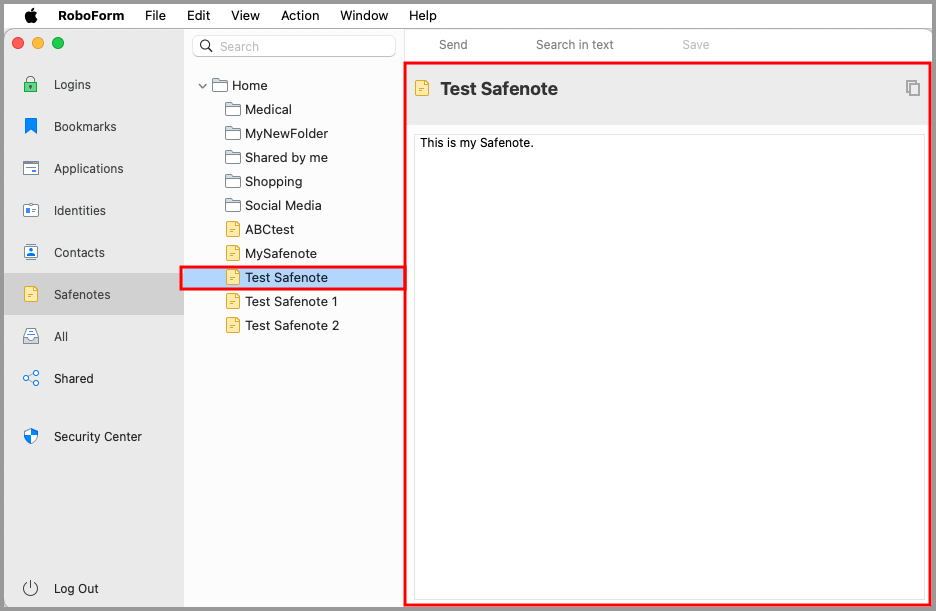
You can Drag and Drop the text of the Safenote. Simply click and hold the name of the Safenote and drop it where you like on a web page.
The Editor Toolbar at the top has the following Safenote options:
- Send opens the RoboForm Sharing window and allows you to send the Safenote to another RoboForm user.
- Search in text opens a search toolbar near the top of the Editor. Your search query will be highlighted within the text of the Safenote. You are able to go between your search results, match the case of the search query, and search for the whole word.
- Click the Save button after you made any changes.
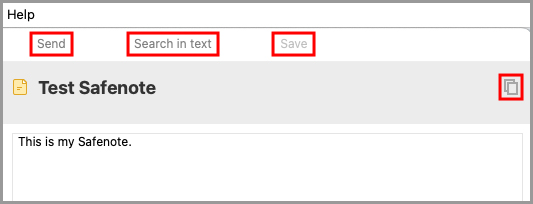
The All Tab in the Editor
This tab shows all of your Logins, Bookmarks, Applications, Identities, Contacts, Safenotes and Folders together. They are organized alphabetically within their sections (e.g. all the Logins are grouped together, all the Safenotes are grouped together, etc).
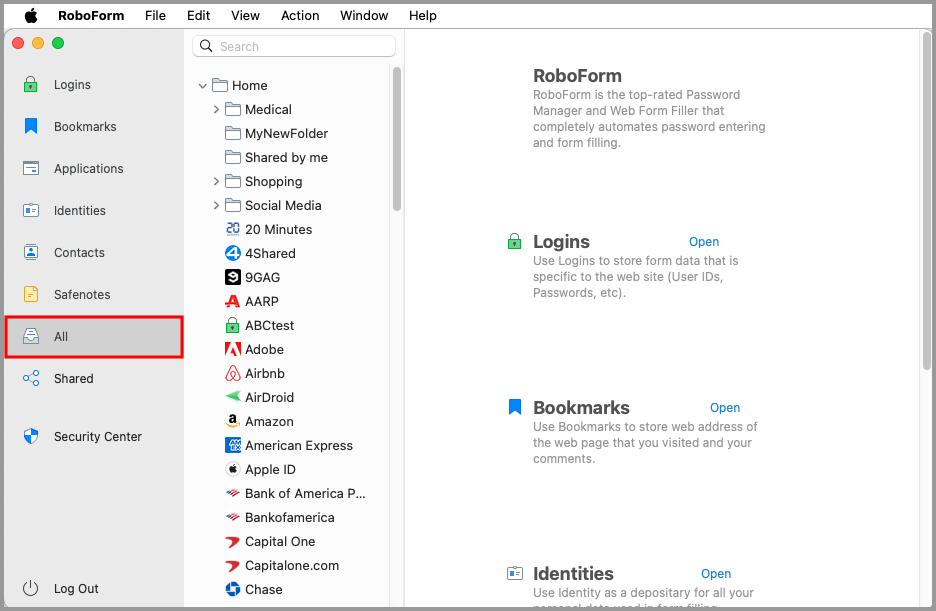
The Shared Tab in the Editor
Shared shows the RoboForm items that you shared with others or items that are shared with you:
- Items or Folders with a blue icon are items you shared with others.
- Items or Folders with a black icon are items that are shared with you.
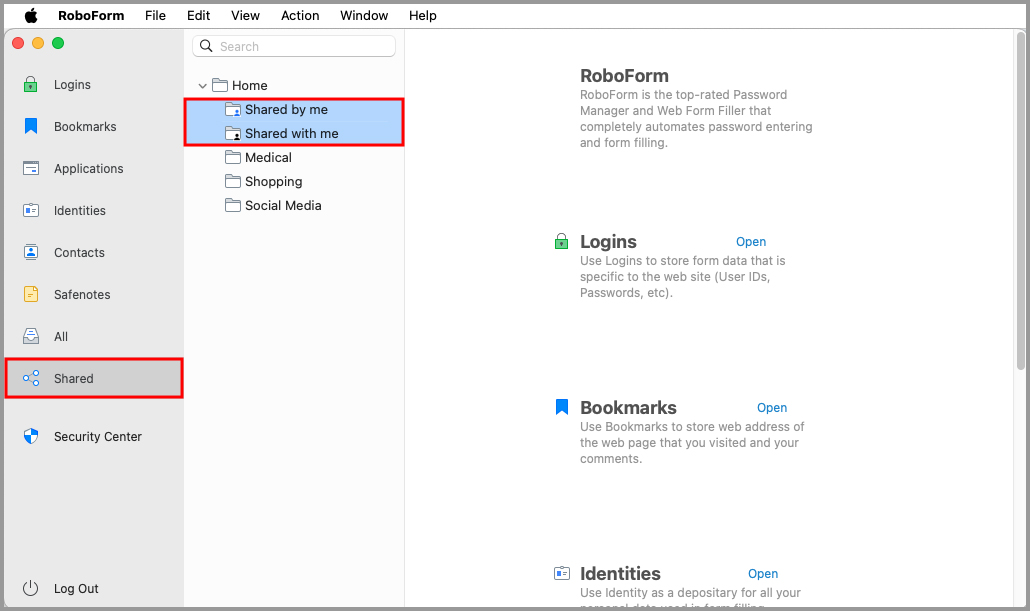
NOTE: To find out what the different permission levels mean, how to create a Shared Folder, and more Shared Folder information, read Chapter 13: Sharing and Sending.
The Authenticator Tab in the Editor
The RoboForm Authenticator allows you to use RoboForm as a two-factor authenticator for other sites and apps. To learn more about the RoboForm Authenticator, go to Chapter 12: Authenticator.
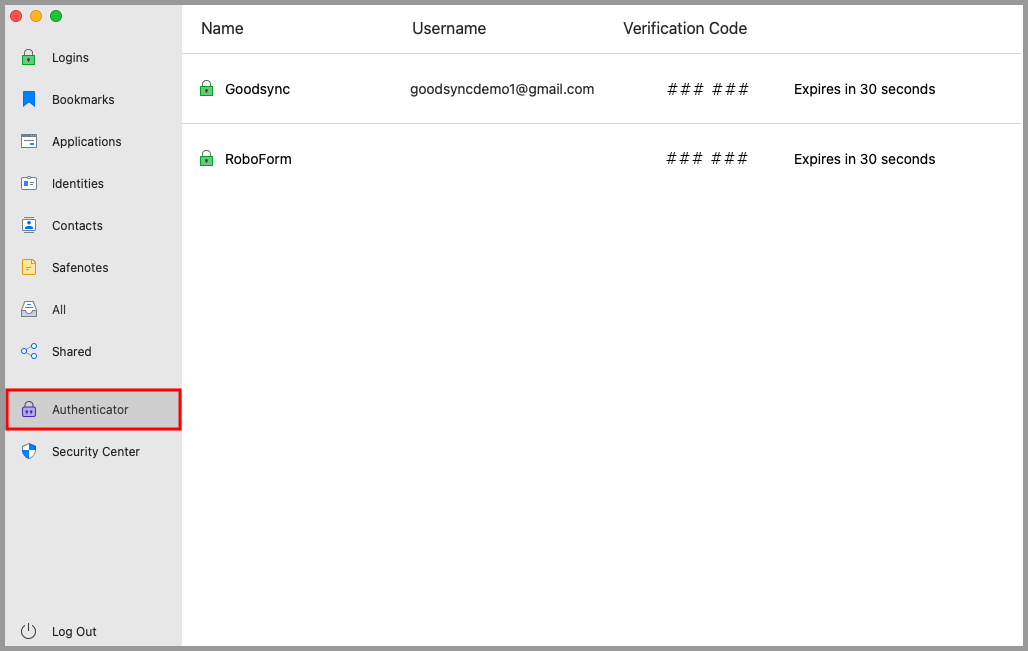
The Security Center in the Editor
Read more about the Security Center in Chapter 15: Security Center.
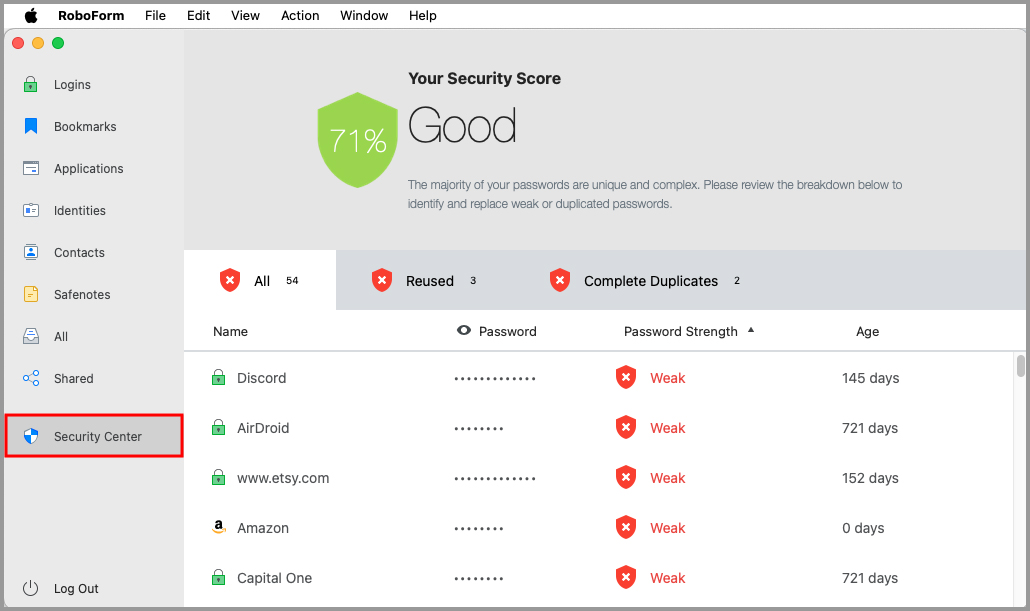
Chapter 9: Menu Bar Icon
The RoboForm Menu Bar Icon provides quick access to RoboForm’s functions and your saved data.
The RoboForm Menu Bar Icon appears in the top right corner of your screen where the time and date is displayed.
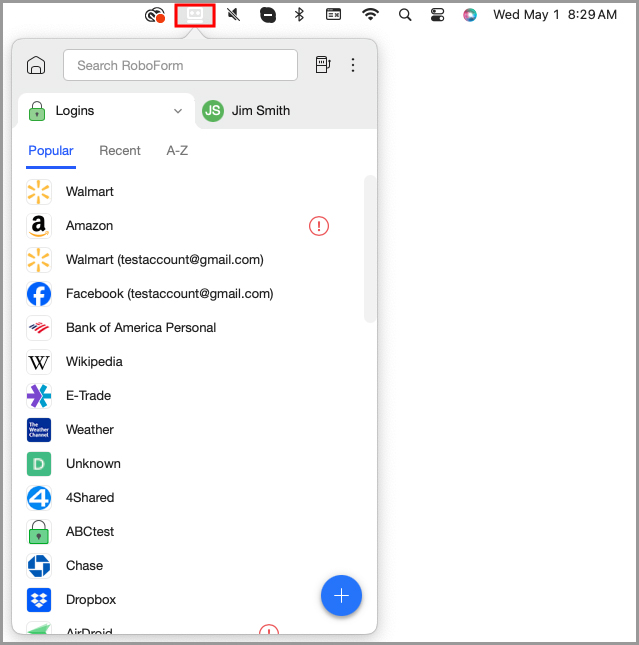
Data in the Menu Bar Icon is only accessible when you are logged into RoboForm using your Master Password.
Data in the Menu Bar Icon
The RoboForm Menu Bar Icon allows you to sort your data into the following categories: Pinned, All, Logins, Safenotes, or Identities.
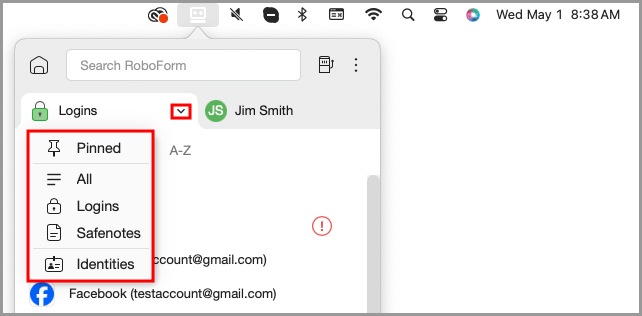
- Pinned - A list of just your Pinned items.
- All - A list of all of your RoboForm items.
- Logins - A list of just your Logins. Allows you to view, edit, and use your Logins.
- Safenotes - A list of just your Safenotes. Allows you to view, create, and edit your Safenotes.
- Identities - A list of just your Identities. Allows you to view, edit, and use your Identities.
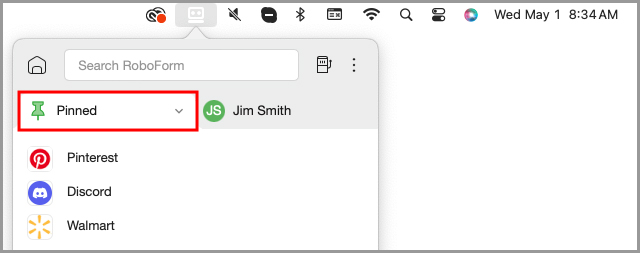
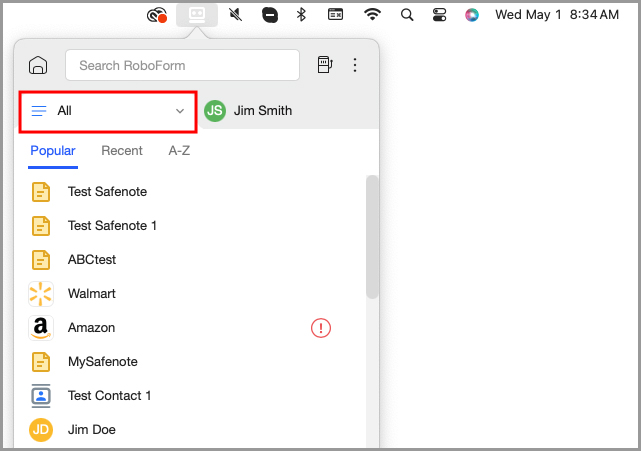
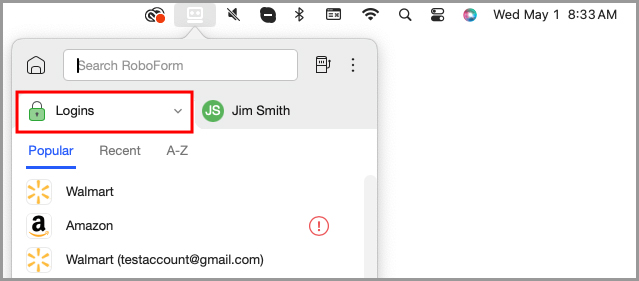
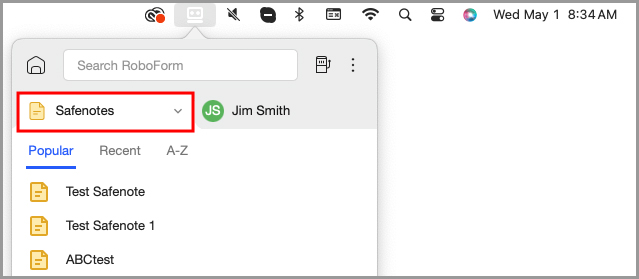
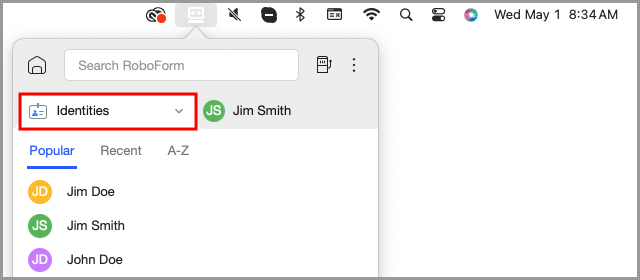
You can view your Identities in more detail by clicking the Identities tab on the right.
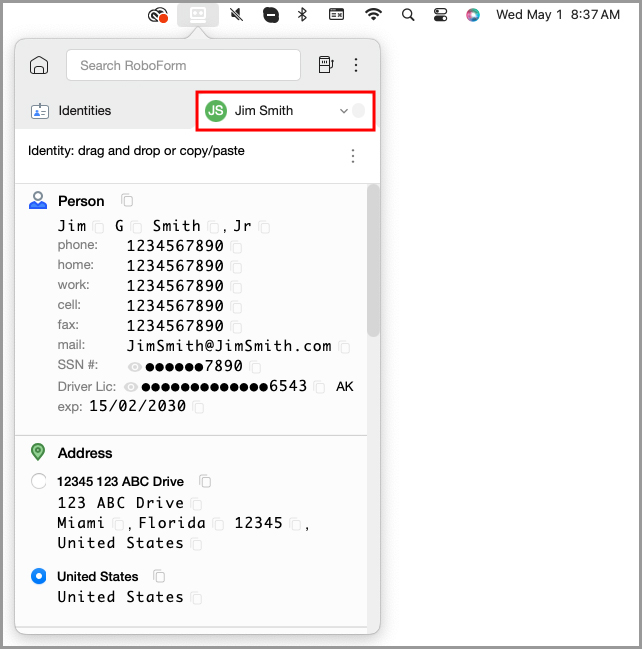
If you click the 3 dots on the right of the Identity in this window, you will see options to:
- Edit - Allows you to edit the Identity on the Start Page.
- Rename - Allows you to rename the Identity.
- Delete - Allows you to delete the Identity.
- Send… - Allows you to send the Identity to another RoboForm user.
- Sharing… - Allows you to share the Identity with another RoboForm user.
- Add to Pinned - Allows you to add the Identity to your Pinned list.
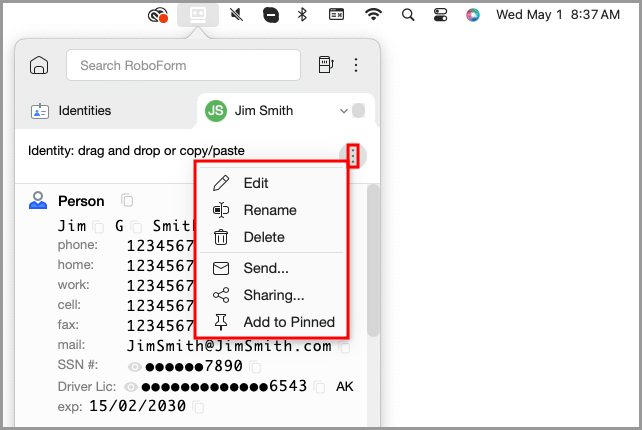
At the Top of the Menu:
- House Icon - Clicking on this icon will take you to the Start Page.
- Search Bar - Use this search bar to RoboForm for specific data items.
- Password Generator - Click this icon to use the RoboForm Password Generator within the Menu Bar Icon.
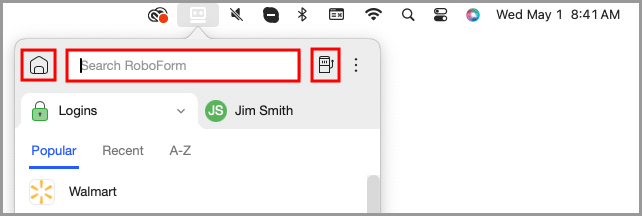
Clicking the 3 Dots in the Upper Right Corner:
This reveals a menu with the following options:
- Password Generator - Opens the RoboForm Password Generator.
- Authenticator - Takes you to the RoboForm Authenticator on the RoboForm Start Page.
- Sharing Center - Takes you to the Sharing Center on the RoboForm Start Page.
- Security Center - Takes you to the Security Center on the RoboForm Start Page.
- Emergency Access - Opens Emergency Access in a new window. This feature allows approved RoboForm users to gain access to your RoboForm data in case of an emergency. Read more in Chapter 14: Emergency Access.
- Open Desktop Editor - Opens the RoboForm Editor.
- Sync - Manually syncs your device and your RoboForm account.
- Log In/Log Out - Log in or out of RoboForm.
- Settings - Opens the settings of RoboForm in a new window. Read more in Chapter 18: Settings.
- Import - Allows you to import your passwords from an alternative password manager.
- Scan QR Code - Allows you to scan a QR code on a page.
- Help - Shows the Help menu (details below).
- Quit RoboForm - Turns off RoboForm.
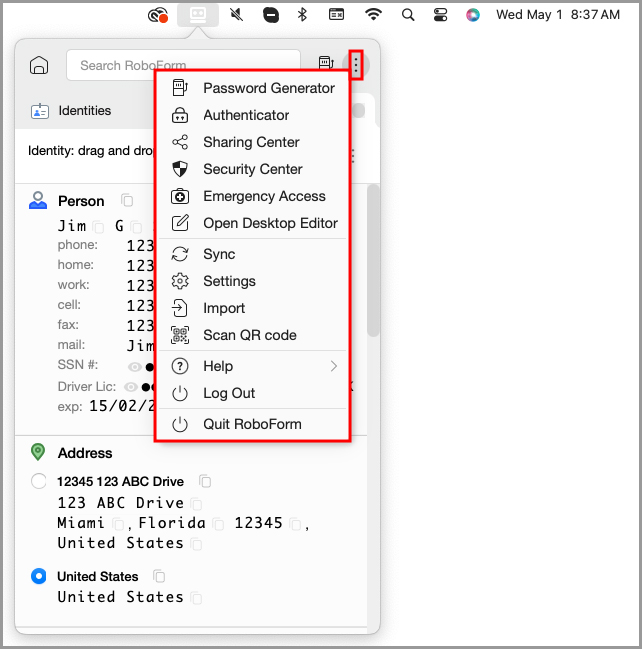
The Help Menu:
- Manual - Opens the RoboForm Manual.
- FAQs - Takes you to the Roboform support page.
- Home Page - Takes you to the RoboForm website’s home page.
- Forgot Password? - Takes you to our support article on what your options are if you forget your password.
- Contact Support - Allows you to submit a support ticket.
- About… - Shows the RoboForm License Agreement, the Version of RoboForm that you are using, and whether your version of RoboForm needs to be updated.
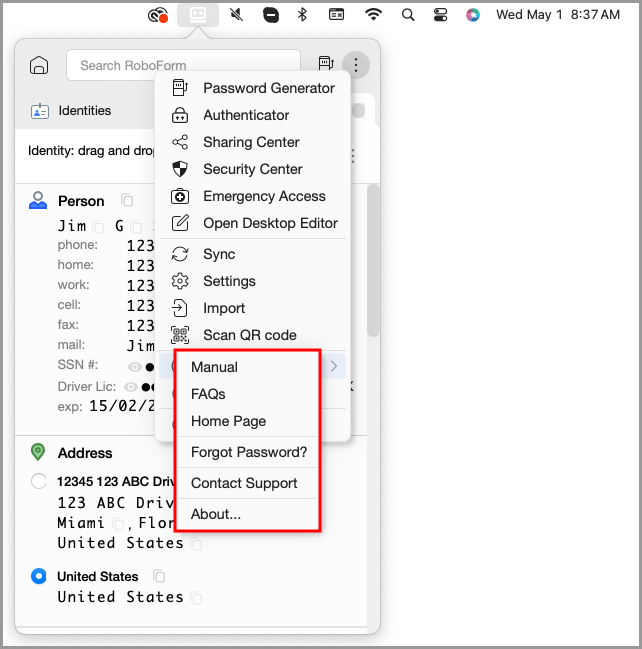
Chapter 10: AutoFill Dialog
AutoFill is an optional function that automatically fills forms (Logins or Identities) when you visit a website. It appears as a RoboForm icon on the side of a field.
How to Enable AutoFill
- Click the RoboForm icon in the top right of your screen on the Menu bar. Then, click the 3 dots in the upper right corner. Then, select "Settings" from the menu.
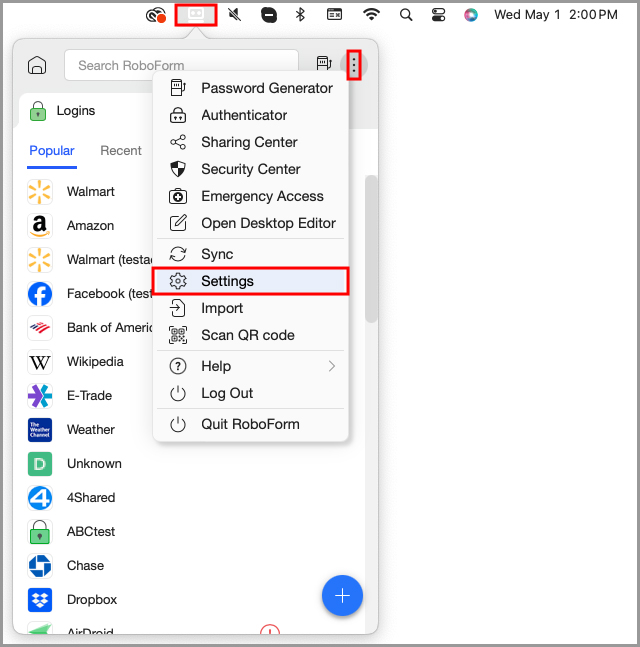
- Select "General" from the column on the left. Under AutoFill, ensure the option “Offer to AutoFill” is enabled. Click the blue "OK" button to save your changes.
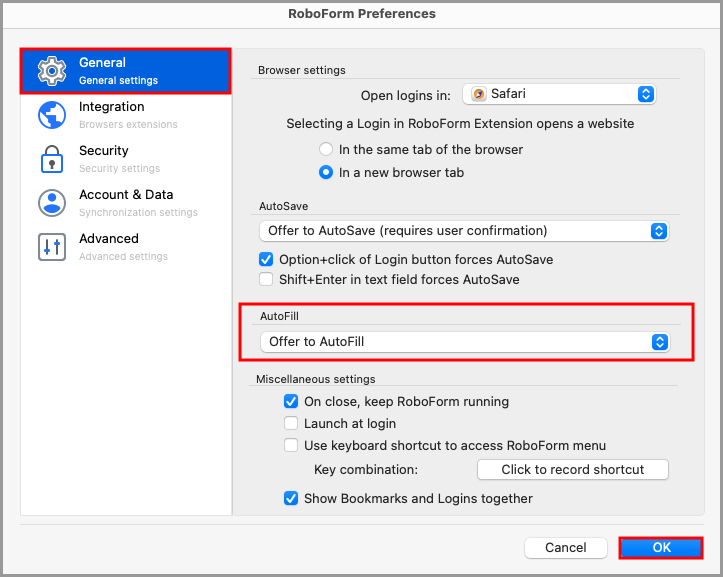
How to Use AutoFill Dialog
RoboForm will offer to AutoFill website forms that contain:
- A login form that matches one of your RoboForm Logins.
- A long non-password form that can be filled by an Identity; by default, 4 fields in a form trigger AutoFill.
On a website with empty forms, the AutoFill Dialog will pop up and offer to fill the forms with:
- Matching Logins (previously called Passcards)
- Any of your Identities.
Select the desired Login or Identity.
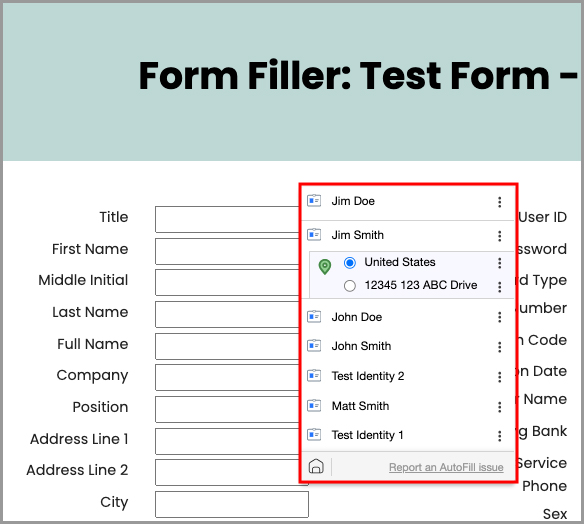
Clicking the 3 dots to the right of an item opens a menu with options to:
- Fill - Completes the form with the selected Login or Identity but does not submit.
- Edit - Allows you to edit the Login or Identity.
- Rename - Allows you to rename the Login or Identity.
- Delete - Allows you to delete the Login or Identity.
- Open Start Page - Takes you to the Start Page.
- Do show on this domain - Turns off the Autofill dialog at that domain.
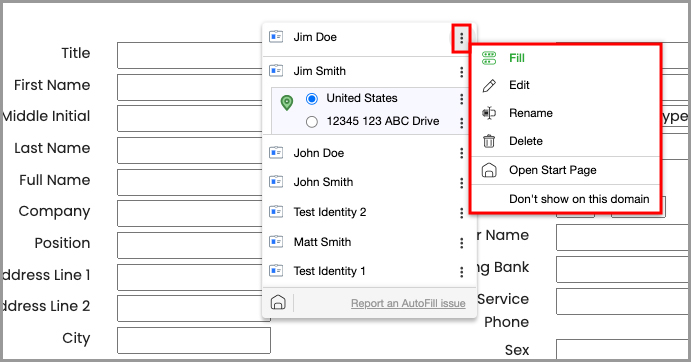
There are more settings for AutoFill actions and appearance within RoboForm's settings. Read more in Chapter 18: Settings.
Chapter 11: Password Generator
The RoboForm Password Generator is a powerful tool which allows you to generate random and secure passwords. It has customizable parameters to ensure that, no matter what the password requirements of a website are, you will be able to generate a password which complies.
Using the Password Generator When Creating a New Account
In order to generate a random password when creating a new account:
- Go to the website you wish to create an account for and navigate to their Account Creation page. For example: Walmart.com. Enter the required information for account creation. When you reach the "Password" field, click the RoboForm autofill icon next to the field to bring up the password generation dialogue.
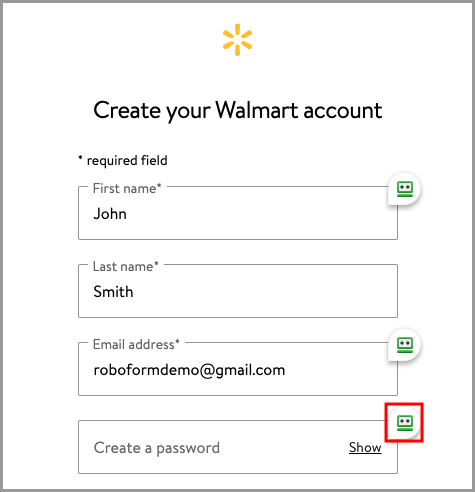
NOTE: If you do not see the RoboForm icon next to the field, you can still access the password generator by clicking the RoboForm extension, and then clicking the Password Generator icon (slot machine).
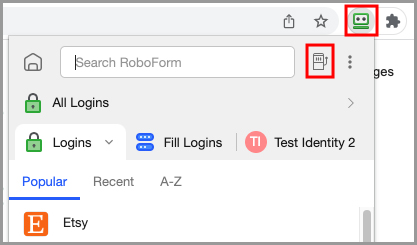
- Click "Generate" from the password generation dialogue, and then click the "Fill" button.
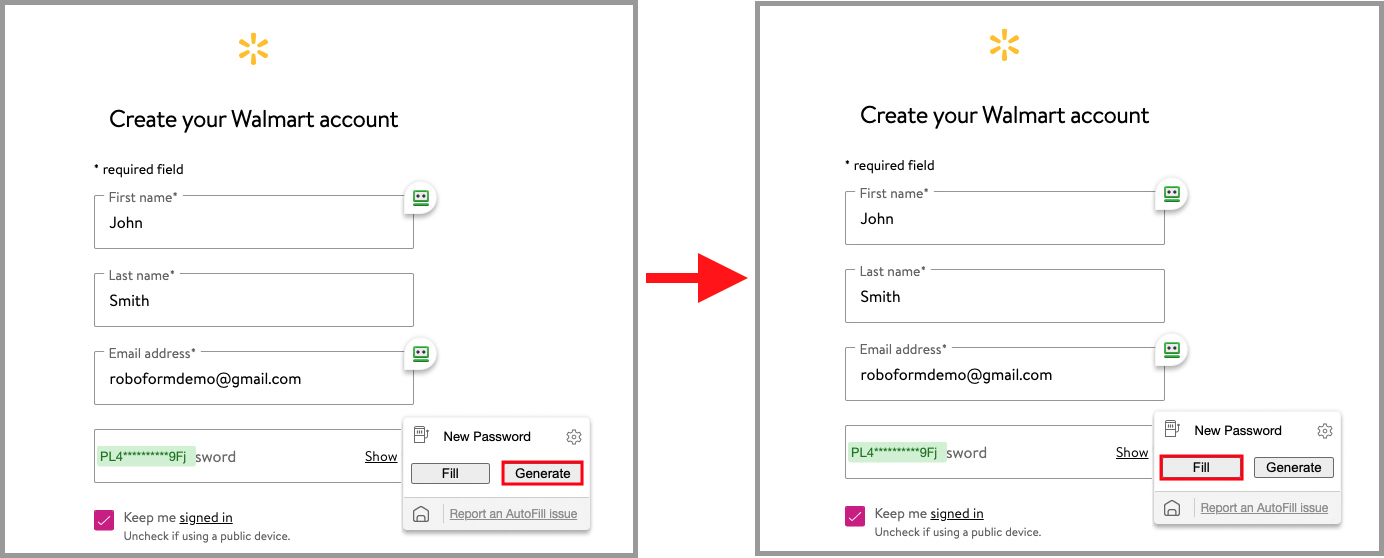
- After entering the account creation information, click "Create Account" or the equivalent button on the site you are on.
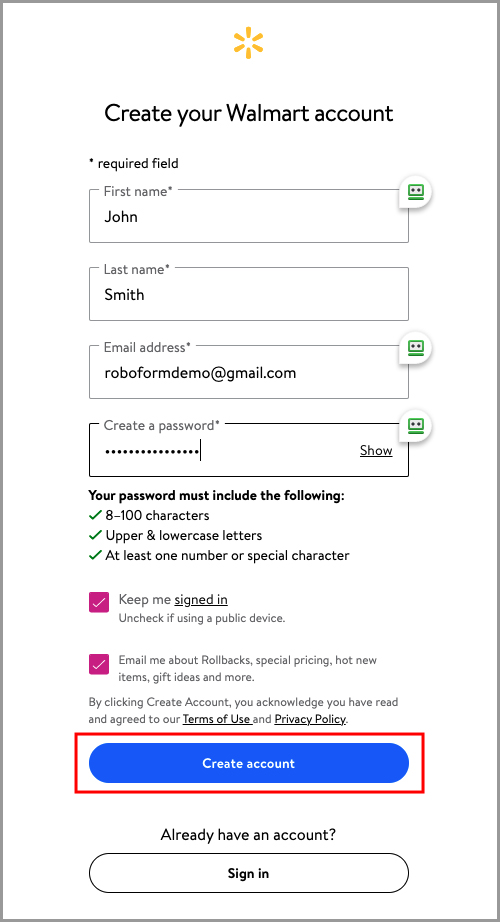
- The RoboForm autosave dialogue will appear offering to save the account credentials as a new Login. Confirm that the information is correct and that the Login's name and folder placement are to your specifications. Then, click the "Save" button.
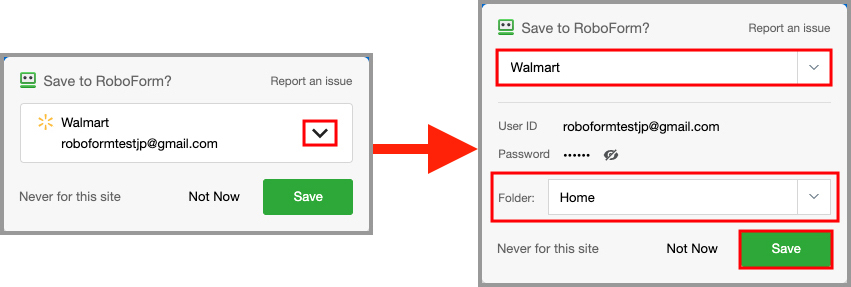
- RoboForm will present you with a window confirming that the new password was saved.

NOTE: If the RoboForm autosave dialogue does not appear, you will need to save your new Login manually through the Start Page. You can view our tutorial for creating a Login through the Start Page here.
Using the Password Generator to Update an Existing Password
In order to update a Login to use a randomly generated password:
- Log in to the account you want to update the password for and navigate to the page which allows you to change the password for your account. Then, click the RoboForm icon next to the "New Password" field to bring up the password generation dialogue.
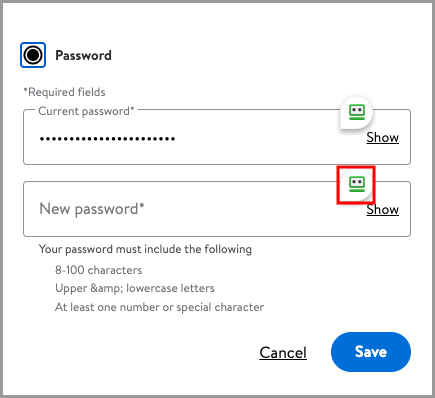
NOTE: If you do not see the RoboForm icon next to the field, you can still access the password generator by clicking the RoboForm extension, and then clicking the Password Generator icon (slot machine).
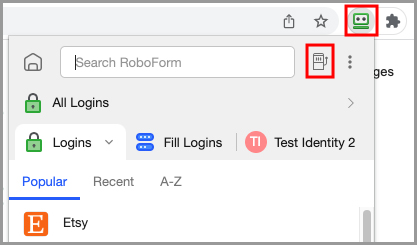
- Click "Generate" from the password generation dialogue, and then click the "Fill" button.
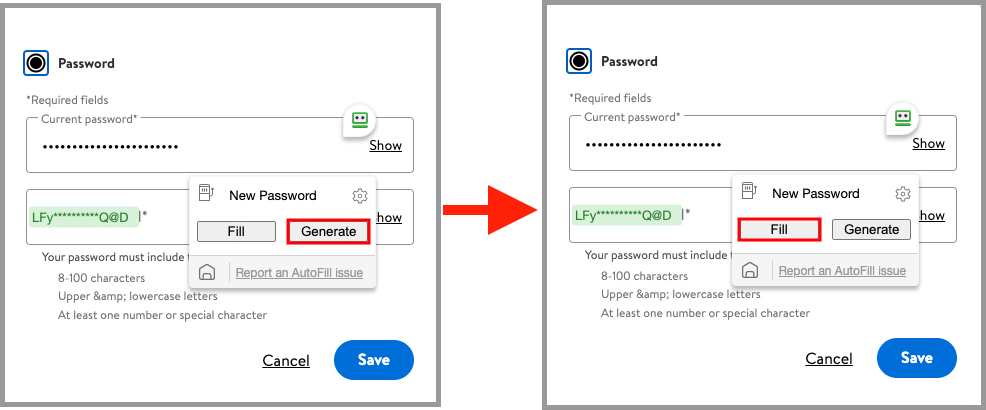
- Save your new password.
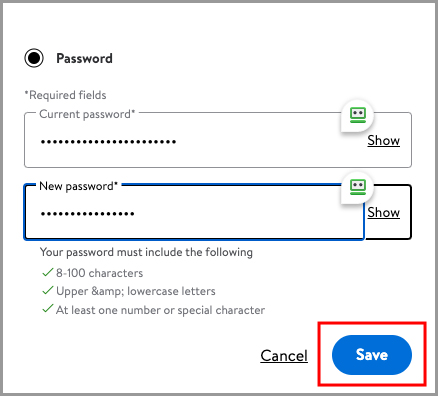
- The RoboForm autosave dialogue will appear offering to save the new password to your Login. Confirm that the information is correct, and then click the "Update" button.
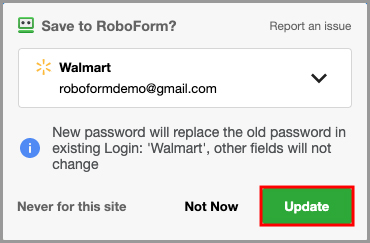
- RoboForm will present you with a window confirming that the new password was saved.

NOTE: If the RoboForm autosave dialogue does not appear, you will need to save your new password manually through the Start Page or Editor. You can view our tutorial for creating a Login through the Start Page here.
Customizing Password Generation Parameters
To change the password generation parameters on the RoboForm Password or Passphrase Generators, follow these steps:
- Open your browser, and click the RoboForm extension icon. Click the Password Generator icon (slot machine) in the upper right.
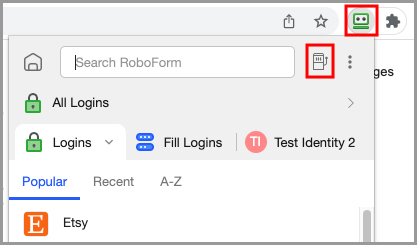
- Here, you will see the RoboForm Password and Passphrase Generators and will have access to their customizable parameters. The available customizations for the password generator are:
- You can change the character length of the generated password by adjusting the number in the "Number of Characters" field.
- Under "Advanced Options" there are more customizations:
- You can choose to allow or exclude numbers, uppercase letters, and/or lowercase letters by toggling on or off their respective options.
- You can choose to only use hexadecimal characters by toggling on the "Hexadecimal 0-9, A-F" option.
- You can choose to allow or exclude characters with similar appearances (For example, 1 and I) by toggling on or off the "Exclude similar" option.
- You can choose to allow or exclude special characters and have the ability to specify which special characters to use.
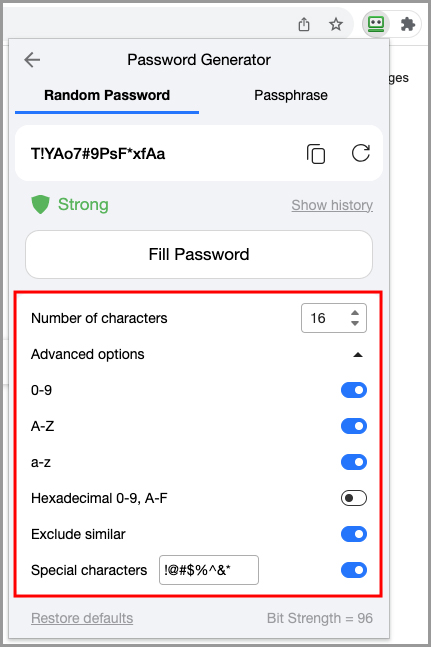
- The available customizations for the passphrase generator are:
- You can change the number of words in the generated passphrase by adjusting the number in the "Number of words" field.
- Under "Advanced Options" there are more customizations:
- You can use any character of your choice as a delimiter using the "Word separator" option.
- You can choose to have the first letter of each word in the passphrase be capitalized using the "Capitalize first letters" option.
- You can choose to include numbers in your passphrase using the "Add numbers" option.
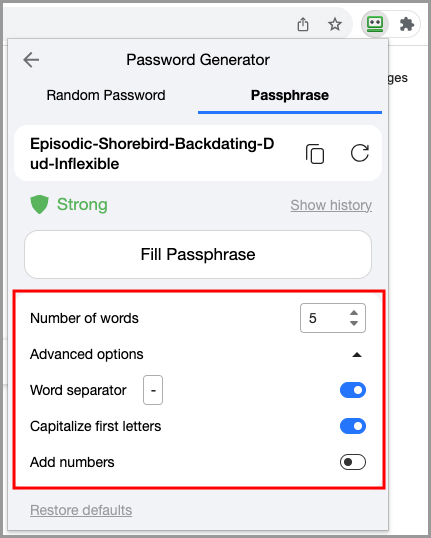
Chapter 12: Authenticator
The RoboForm Authenticator allows you to use RoboForm as a two-factor authenticator for other sites and apps. This allows you to contain both your login credentials and authentication code in one place, instead of having to use a third-party authentication app.
Logins you save an Authentication code for will be located in the Authenticator tab on the Start Page.
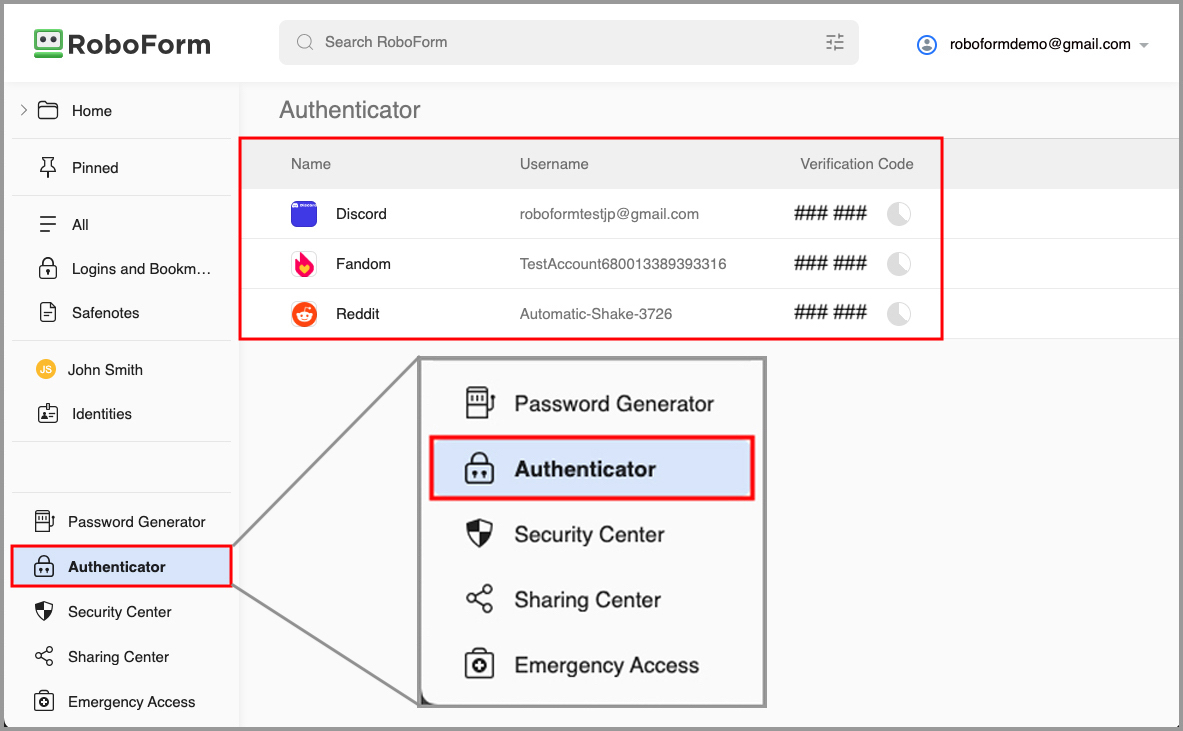
How to use RoboForm as a 2FA Authenticator for Other Sites and Apps
RoboForm offers built-in 2FA services which allow for a more efficient log in experience.
- Log in to the account you wish to enable two-factor authentication for and go to your account's settings. Once there, find the option to enable two-factor authentication.
NOTE: Not every site will have the option to enable two-factor authentication.
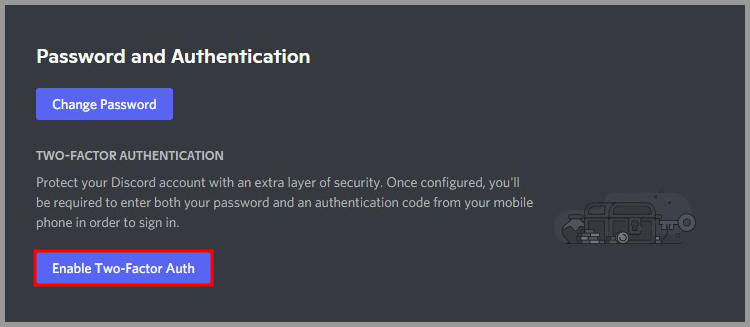
- You will be presented with a 2FA (two-factor authentication) key. Copy this key to your clipboard.
NOTE: Not every site will offer a 2FA key.
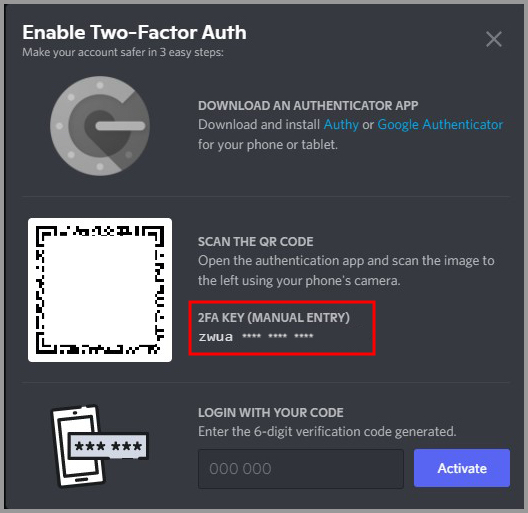
- In your browser, click the RoboForm Extension icon. Then, click the house icon in the upper left of the RoboForm extension to go to the Start Page.
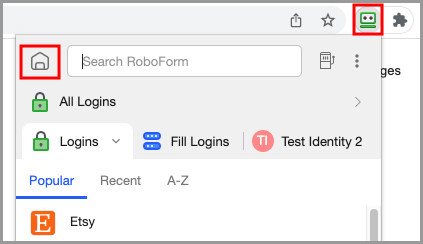
- Hover your mouse over the Login you wish to enable two-factor authentication for, and click the 3 dots in the upper right corner. Then, select the "View" option.
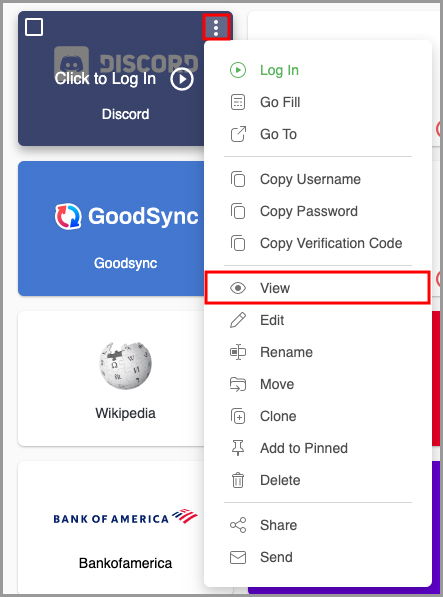
- Underneath your login credentials, you will see an option to enable two-factor authentication for this Login. Click the "Add authenticator setup key" button.
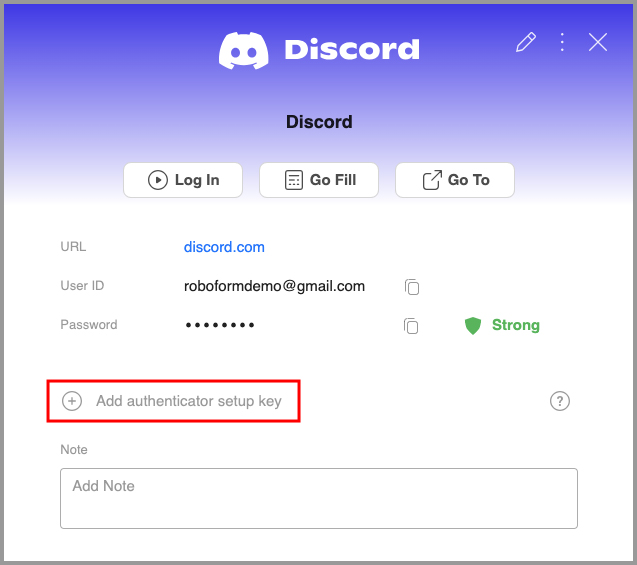
- A window will appear prompting you to enter the two-factor authentication key from your account's settings. Paste the 2FA key you copied earlier into this window and click the blue "OK" button.
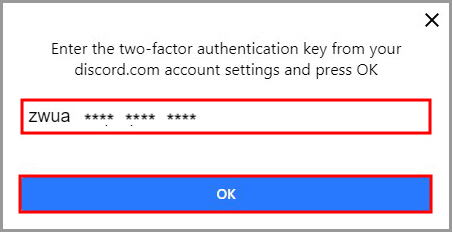
- RoboForm will now present you with a time-sensitive verification code. In order to finish enabling two-factor authentication for this Login, copy this code and enter it back on the account settings page for the Login in question.
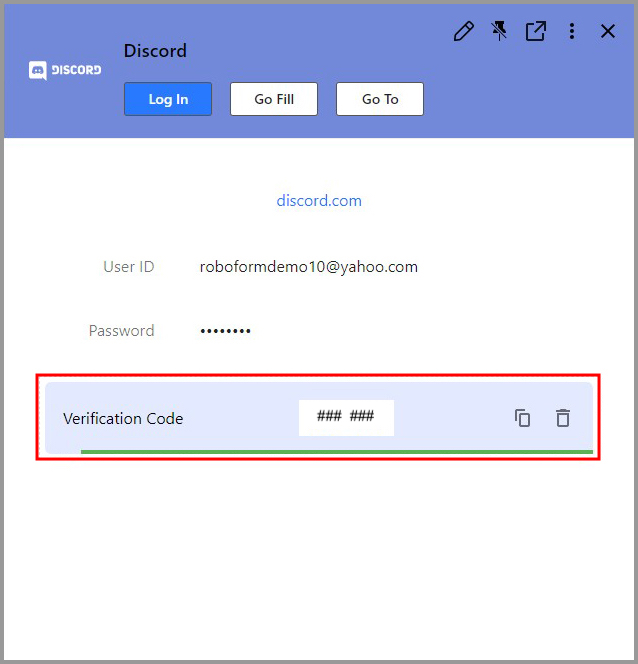
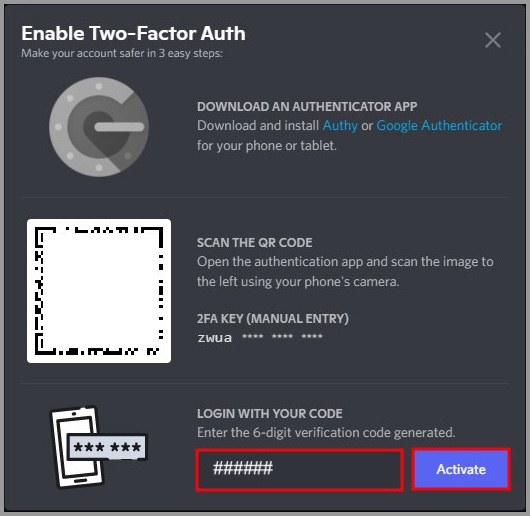
- After you have successfully enabled two-factor authentication, you will be able to use RoboForm to enter your 2FA code for you when logging in to this account.
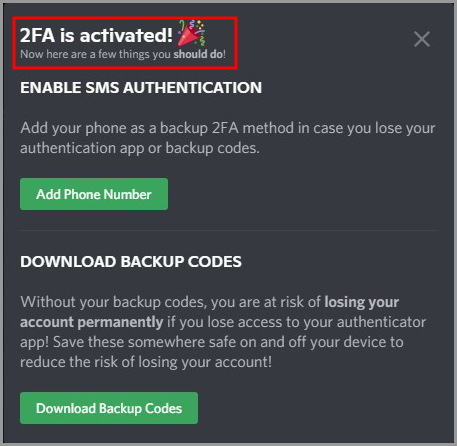
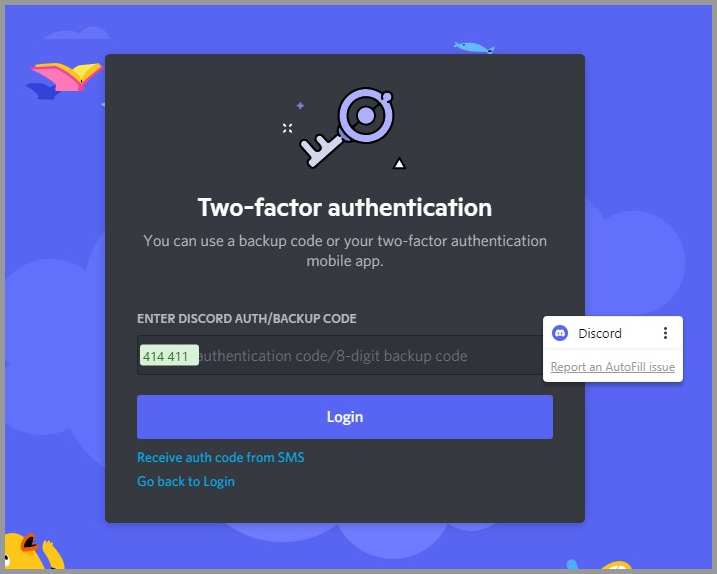
- NOTE: If the RoboForm AutoFill icon does not appear, you can still fill the verification code by clicking the RoboForm Extension, and then clicking the "Clock" icon to the right of the Login you are using RoboForm as a 2FA authenticator for. RoboForm will display the verification code for you to copy and paste into the appropriate field.
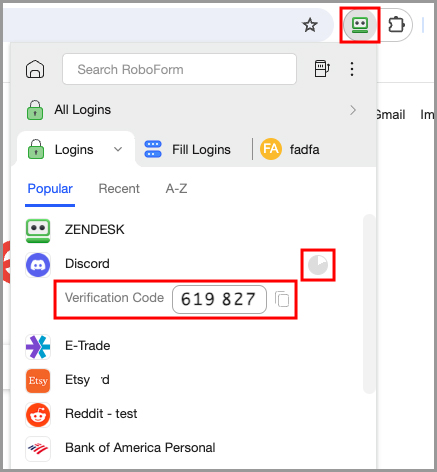
To view a list of all your 2FA codes, select the "Authenticator" tab in the bottom left corner of the Start Page.
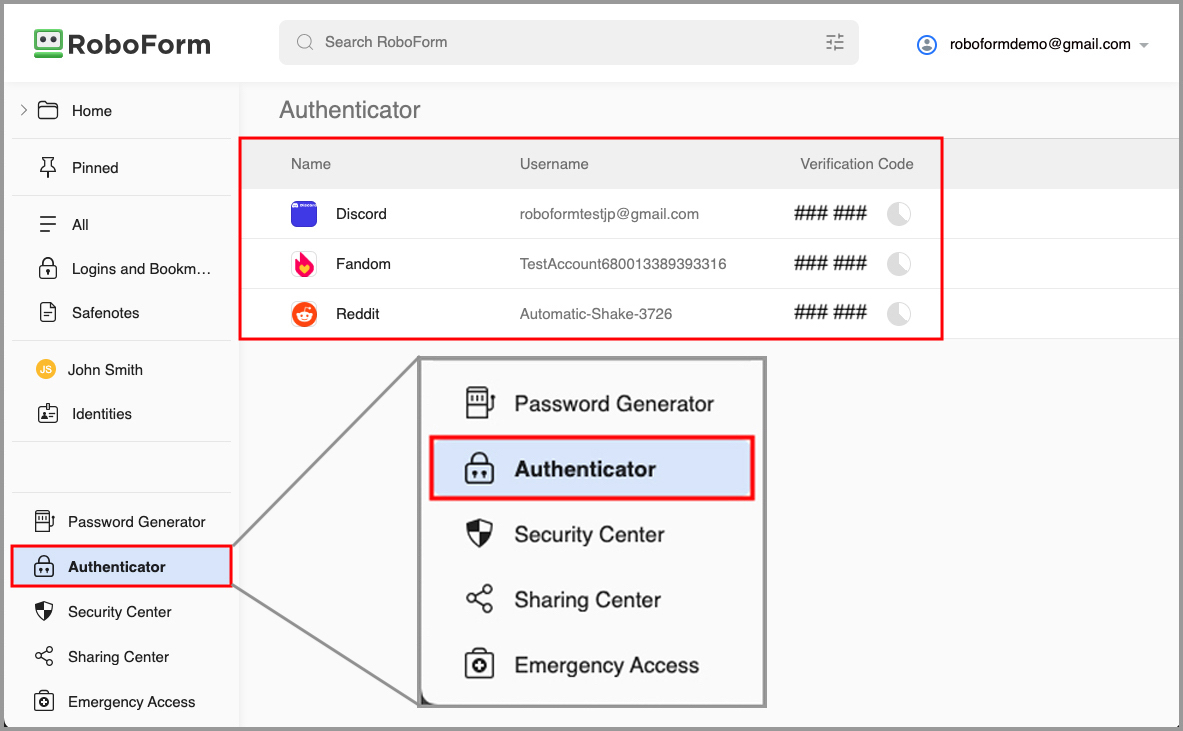
How to Set Up 2FA (Two Factor Authentication) Through A 3rd Party TOTP Authenticator App: RoboForm Extension
-
Open your browser and click the RoboForm extension icon. Click the 3 dots in the upper right corner. Select "Settings" from the menu.
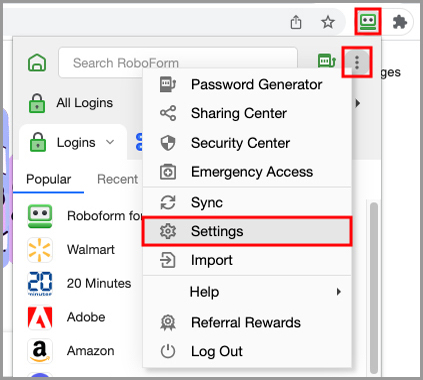
-
In the Settings menu, select "Security" from the column on the left. In the "Two-factor authentication" section, select the “Google Authenticator” option.
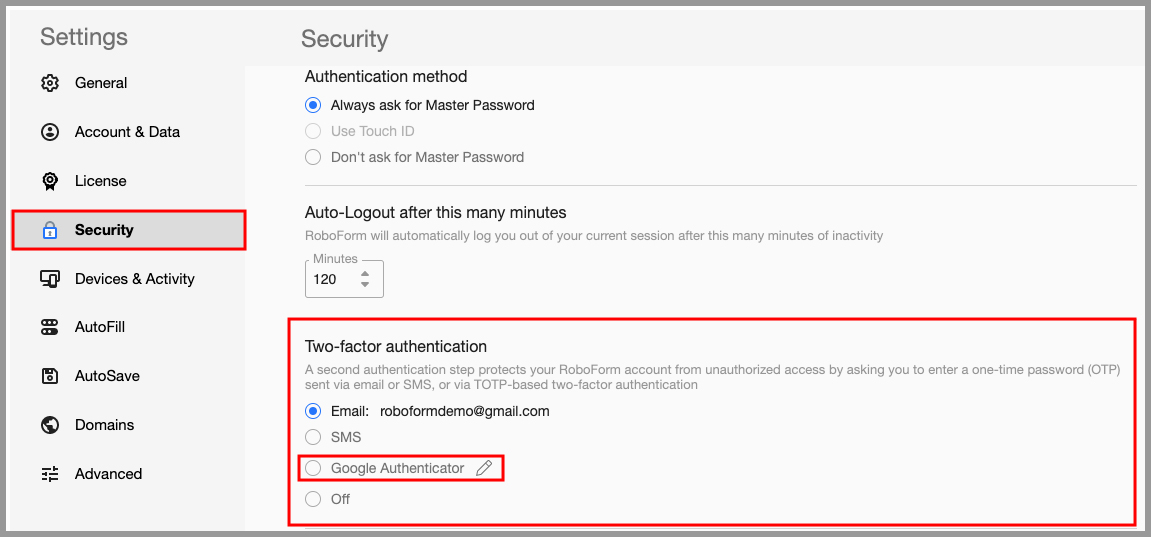
-
RoboForm may prompt you to verify your email address. Obtain the code sent to your email account and enter it in the designated field.
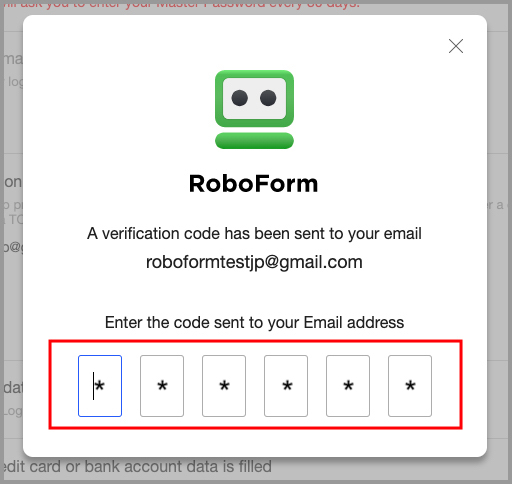
-
Using the device with the authenticator app installed, open the camera and scan the QR code or manually enter the secret key into your Google Authenticator app.
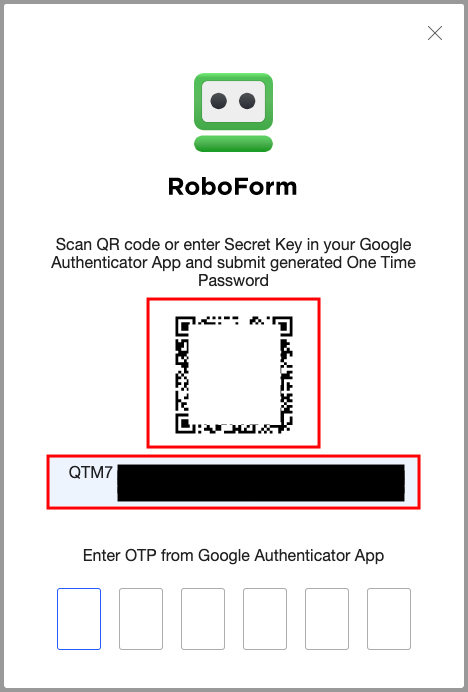
-
After scanning or entering the secret key, the authenticator app will present you with a six-digit numeric code.
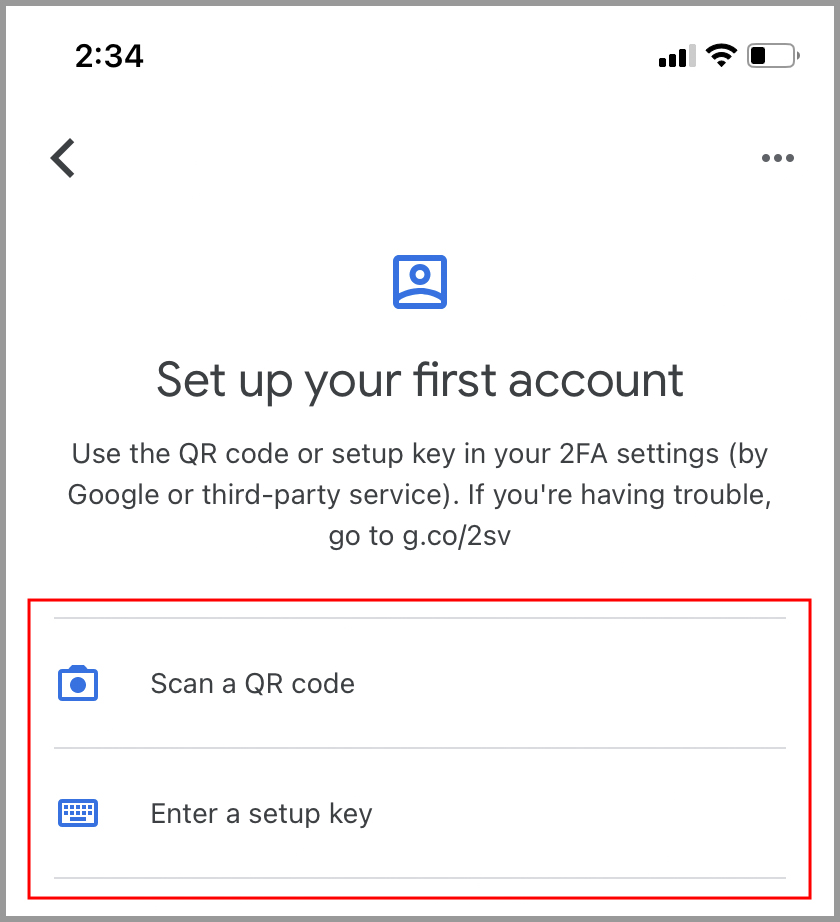
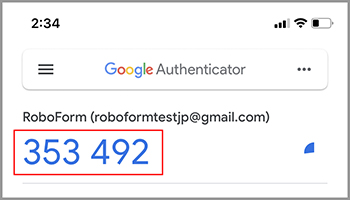
-
Enter this code into RoboForm where it says "Enter OTP from Google Authenticator App."
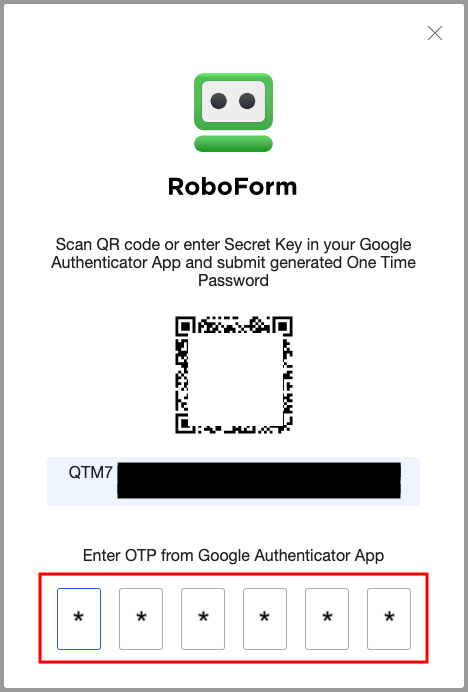
-
You have now enabled 2FA.

-
Moving forward, when accessing your RoboForm account from a new device, a One Time Password will be sent to your Google Authenticator app. You must successfully enter this six-digit numeric code into RoboForm to complete the authorization of that device before you can access your account.
While we strongly recommend using 2FA to protect your account data, if you wish to turn this security feature off, you can do so by going back to RoboForm's settings, selecting the Security tab, and checking the "Off" option under Two-factor authentication.
Chapter 13: Sharing and Sending
The RoboForm Sharing and Sending feature allows you to securely share RoboForm Data (items or folders) with others. Sharing and Sending uses a Public-Private Key Encryption which replaces the risky practice of sharing your Master Password or emailing sensitive data.
If your recipient does not have a RoboForm Account, the recipient will receive an email with instructions on how to create a free RoboForm account.
Sharing
Sharing RoboForm Data is similar to sharing a Google Doc - the shared data is updated to any changes (e.g., changing a password) and access to the shared data can be revoked at any time. The sharer may choose multiple recipients.
How to Share Individual RoboForm Items
- Right-click the item in your RoboForm Extension or Menu Bar Icon.
- Select “Sharing…” from the menu.
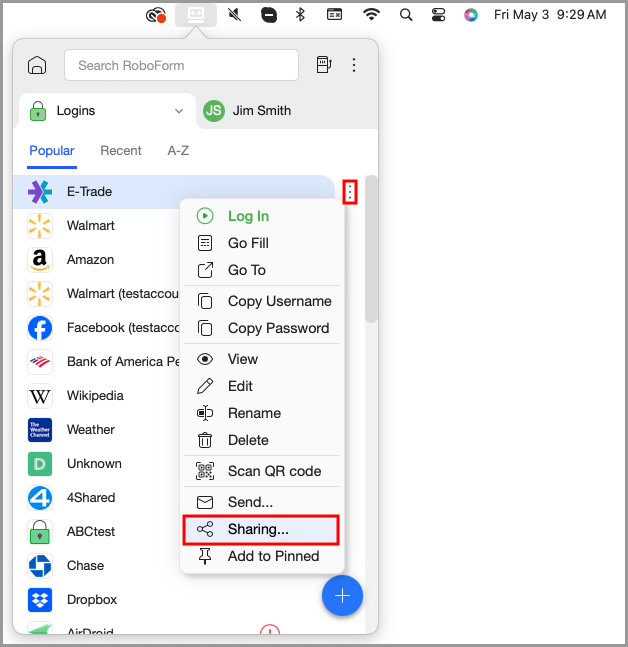
- You will be brought to the Start Page, and the RoboForm Sharing screen will open. Enter the recipient's email and click the blue "Add" button. Multiple recipients can be selected.
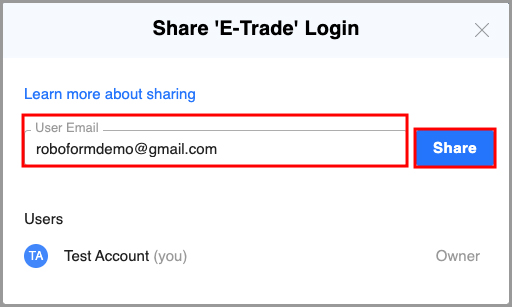
The recipient will be shown under Who Has Access with their name and email:
- If the recipient received and accepted the request, their name and email will be listed under Who Has Access (e.g., Jane Doe).
- If the recipient hasn’t received the request, their status will be Not Received Yet.
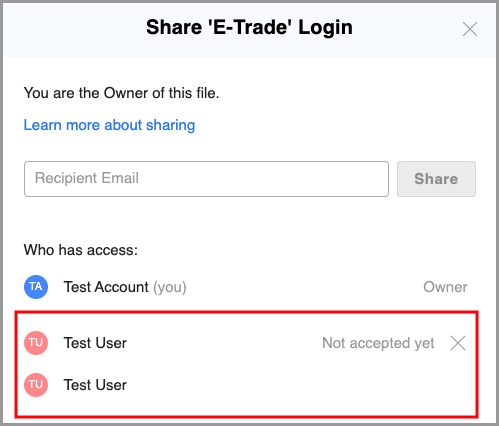
- If they deny the request, their name will be removed from Who Has Access.
To revoke Shared Data, click the X on the far right of the recipient. Another dialog will pop up checking whether you are sure to revoke access to this user.
Shared Folders
A Shared Folder containing multiple RoboForm items is similar to a shared folder in Google Drive. Access to the shared item can be revoked at any time. The sender may choose multiple recipients.
NOTE: RoboForm Premium users can only create 2 shared folders. RoboForm for Business Users can create multiple shared folders.
How to Create a Shared Folder on the Start Page
- Open your browser and click the RoboForm extension icon. Click the "House" icon in the upper left corner of the extension's menu. You will be brought to the Start Page.
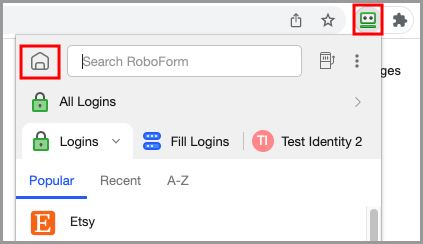
- In the bottom left corner of the Start Page, click the "Sharing Center" tab. Then, click the [ + ] button in the lower right hand corner of the Sharing Center.
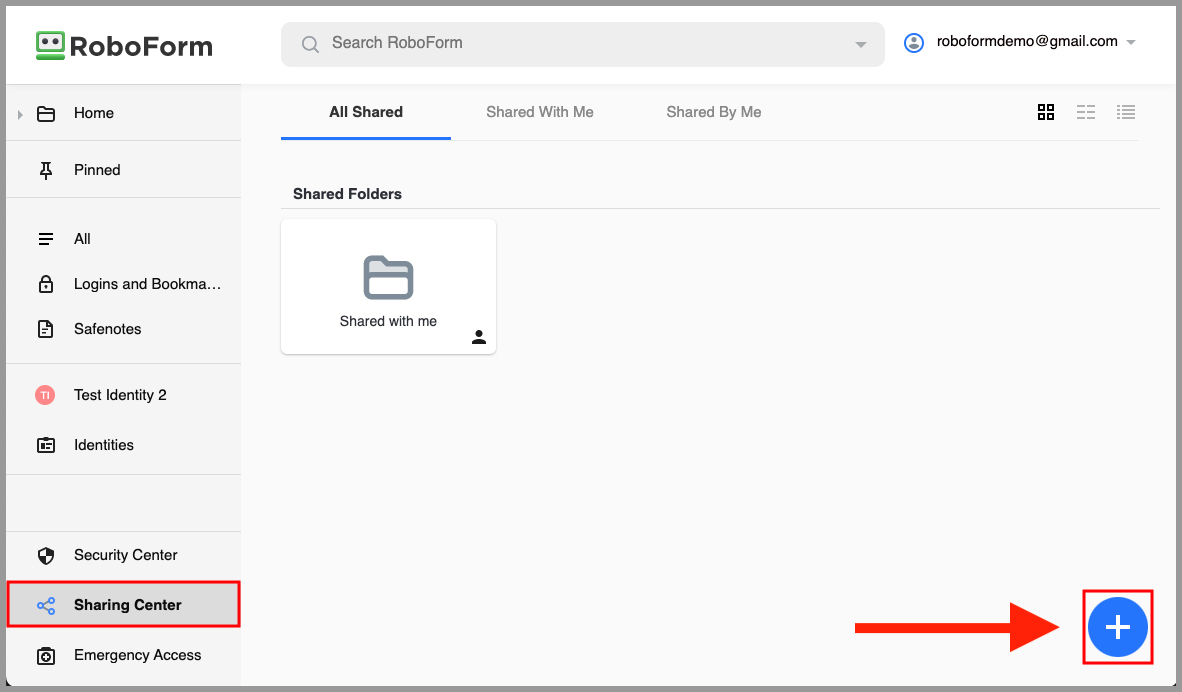
How to Create a Shared Folder in the RoboForm Editor
- Open the RoboForm Editor.
- Click the File menu in the top left corner. Select “New” from the menu. Then, click the “Create shared folder…” option.
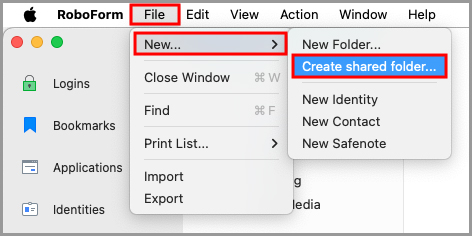
- The Create Shared Folder dialog will open. Name your Folder. Then, click the blue “Create” button.
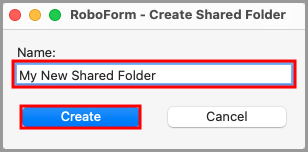
- Your Shared Folder will now appear in the Navigation Pane.
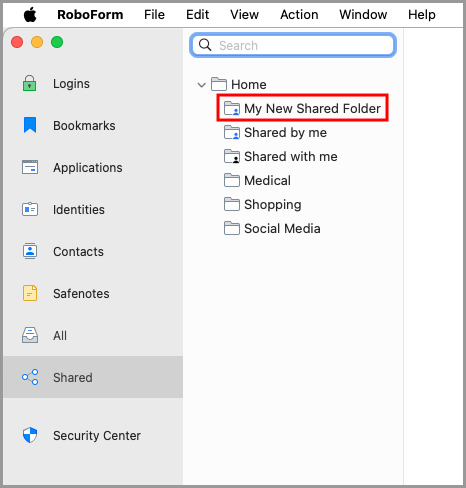
How to Add RoboForm Items into a Shared Folder
- Copy and Paste the item into the Shared Folder.
- Or, drag and drop the item into the Shared Folder.
How to Use a Shared Folder on the Start Page
- Name the shared folder and enter the email address of the recipient. Then, select the folder access level you wish to grant them:
- Full control: Full access rights. In addition to being able to view and edit all items, the recipient can adjust permission levels, as well as add or remove other recipients (including the original sender).
- Read and write: The recipient can view and edit RoboForm items in the Shared Folder, and the changes they make will be propagated to other recipients and the sender.
- Log in only: The recipient will not be able to edit or share RoboForm items in the Shared Folder. Logins can only be used to log in to websites, applications, and mobile apps (the password cannot be viewed in the Editor). Identities and Safenotes can be viewed in the Editor.
Once you are finished, click the blue "Add" button to add the recipient to the shared folder. Then, click the blue "Create" button to complete the folder creation and sharing process.
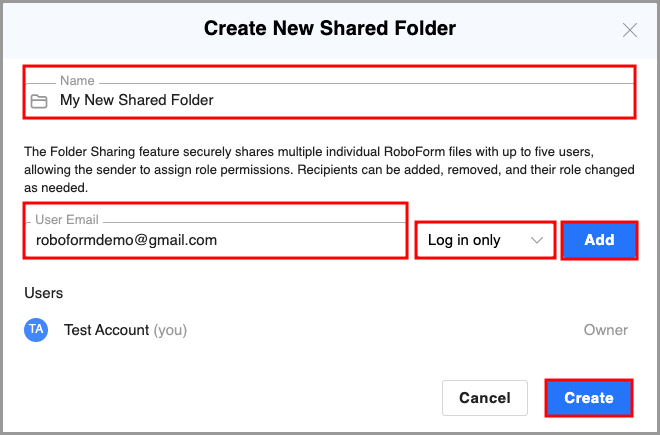
- The user you shared the folder with will receive a message notifying them that a RoboForm user would like to share data with them. To receive the shared folder, they will either need to log in to their account or sync if they are already logged in. Upon selecting “Accept,” the folder and its contents will be shared.
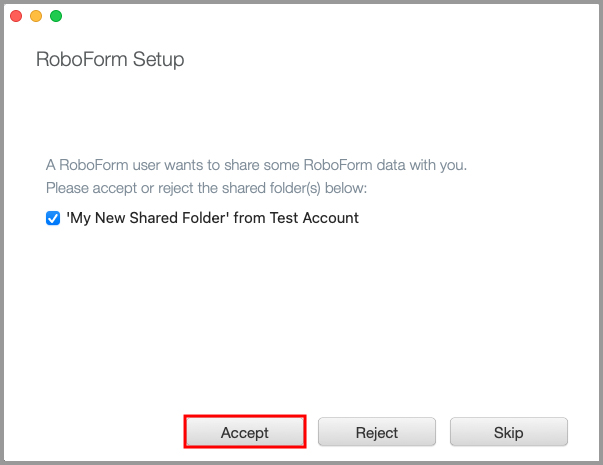
How to Use a Shared Folder in the RoboForm Editor
- Find the Shared Folder in the Navigation Pane in the RoboForm Editor.
- Right-click the folder and select “Sharing Settings…”
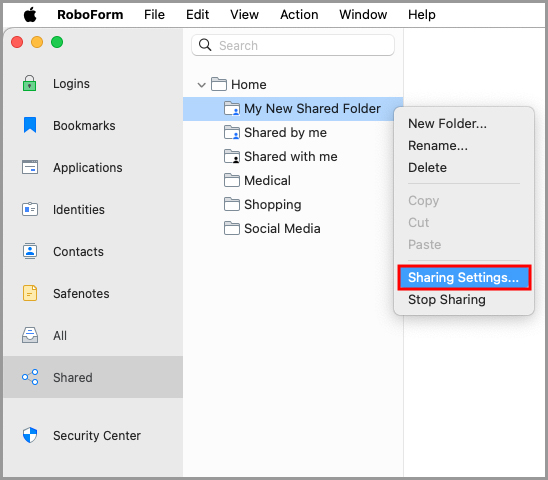
- The RoboForm Sharing window will open. Enter the recipient's email in the designated field. If your recipient does not have RoboForm, they will be emailed instructions on how to create a free RoboForm account.
Select their permission level. The sender can choose one of three different permission levels for the recipient:
- Log in only: The recipient will not be able to edit or share RoboForm items in the Shared Folder. Logins can only be used to log in to websites, applications, and mobile apps - the passwords cannot be viewed in the Editor. Identities and Safenotes can be viewed in the Editor.
- Read and write: The recipient can view and edit RoboForm items in the Shared Folder, and the changes they make will be propagated to other recipients and the sender.
- Full control: Full access rights. In addition to being able to view and edit all items, the recipient can adjust permission levels, as well as add or remove other recipients (including the original sender).
Once you are finished, click the blue “Add” button.
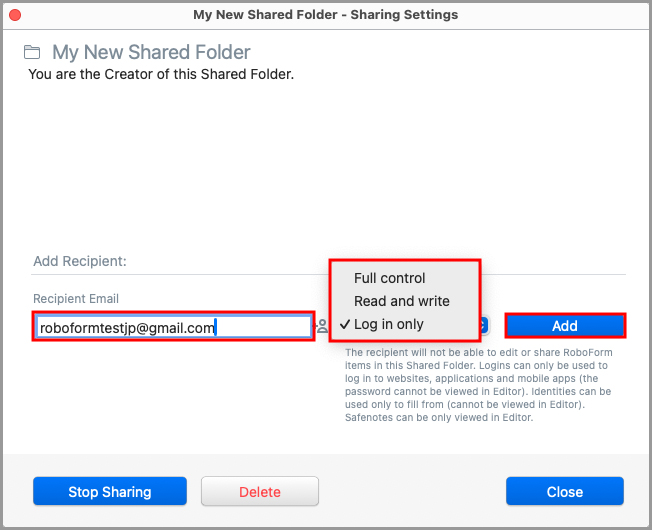
The recipient will be shown under “Recipients” with their email and permission level:
- If the recipient hasn’t received the request, their status will be Not Received Yet.
- If the recipient received and accepted the request, their name and email will be listed under Recipients.
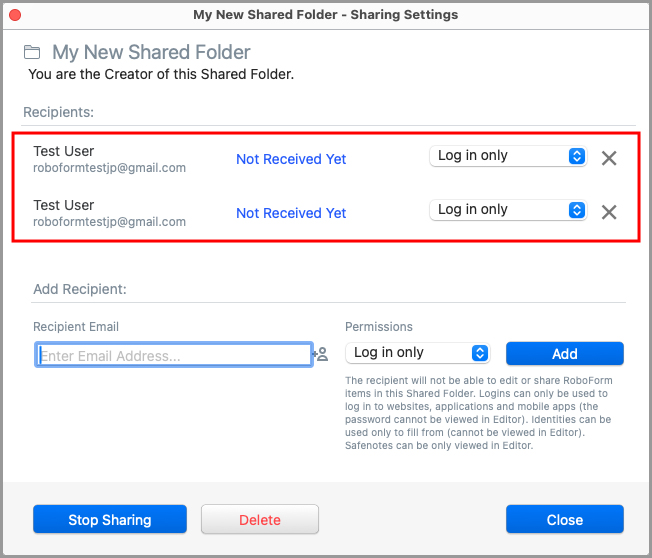
- If they deny the request, their name will be removed from Recipients.
To revoke Shared Data, click the X on the far right of the recipient. Another dialog will pop up checking whether you are sure to revoke access to this user.
Sending
Sending RoboForm Data is similar to sending an email. The RoboForm data is sent once, and any changes won’t be updated (e.g., changing a password) to the recipient, and access to the sent data can’t be revoked. You can send an item to multiple recipients.
How to Send Individual RoboForm Items
- Right-click the item in the RoboForm Extension or Menu Bar Icon.
- Select “Send…” from the menu.
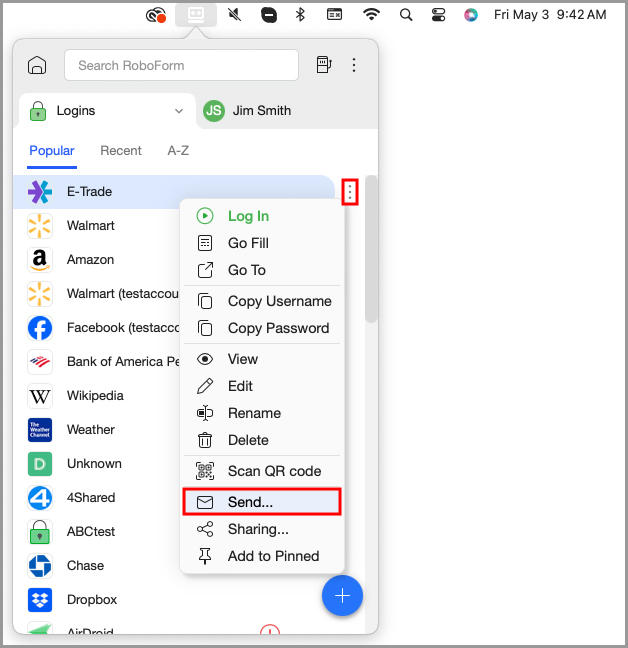
- The RoboForm Sharing screen will open. Enter the recipient's email and click the "Send" button.
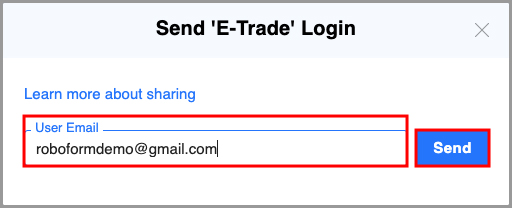
Chapter 14: Emergency Access
In case of an emergency, such as incapacitation or death, it could be vital to have a trusted person obtain access to your medical, financial, and other important information stored in RoboForm. With Emergency Access, you can set up measures for a pre-approved contact to securely receive access to your RoboForm Data after a certain time period passes.
Emergency Access uses public-private key encryption, similar to our Sharing and Sending features. This allows for secure access by the recipient without the grantor's Master Password.
To open Emergency Access and its settings, click the RoboForm Menu Bar Icon or extension. Then, click the 3 dots in the upper right corner and select “Emergency Access” from the menu.
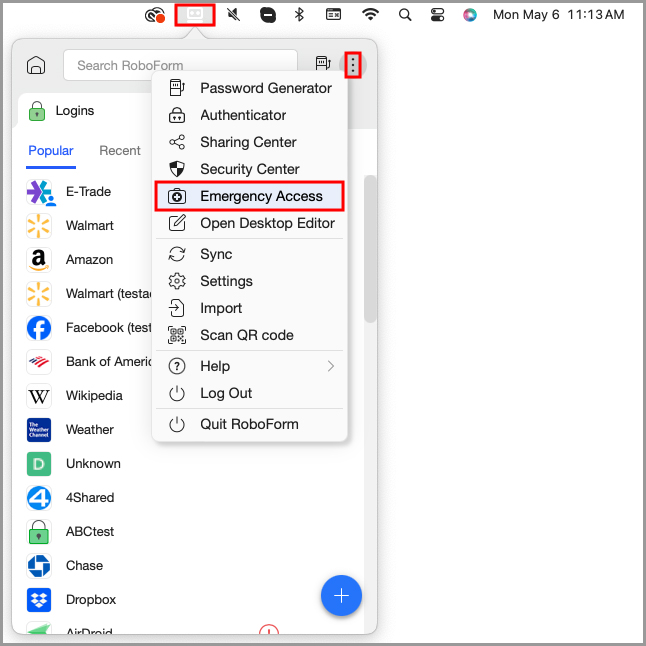
This will bring you to the Emergency Access page on the Start Page.
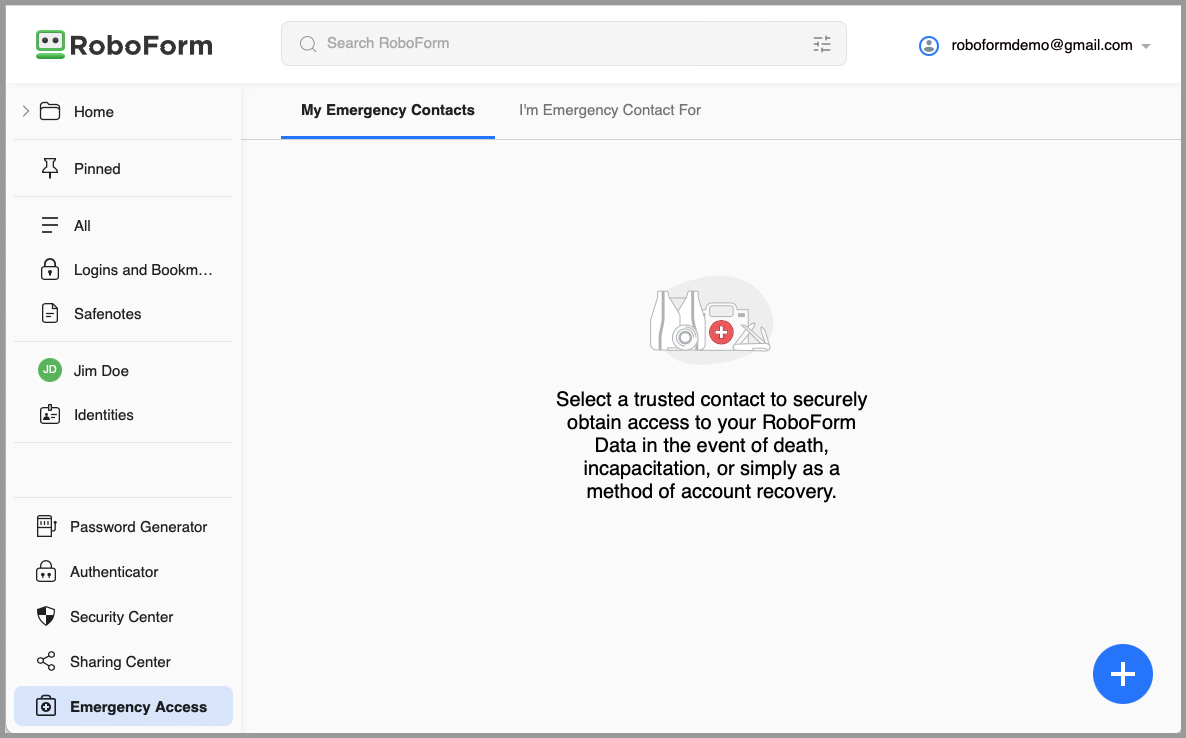
Make sure to set up Emergency Access as soon as possible to ensure you are prepared for an emergency. Setting up Emergency Access is explained below.
How to Set Up and Use Emergency Access
- On the Emergency Access page, click the blue [ + ] button in the bottom right corner.
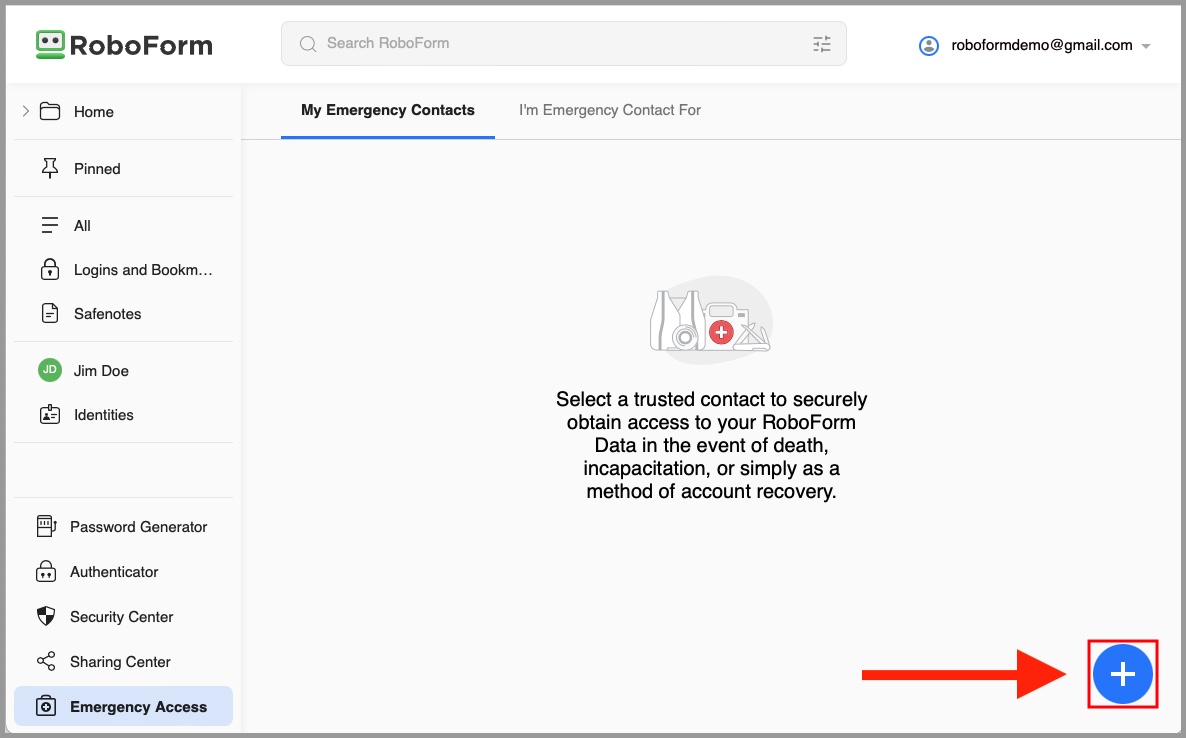
- Enter the email and desired timeout period for your Emergency Contact.
The timeout period is the amount of time that the grantor of Emergency Access has before they are able to decline the Emergency Contact's request for Access. If the grantor does not decline or respond before the timeout period lapses, the Emergency Contact will receive access to their RoboForm Data.
NOTE: Before you invite someone, make sure they have an existing RoboForm account. Emergency Access will not send an invitation to an email that is not already associated with a Free or Premium account. In order to use them as your emergency contact, have them create an account by installing RoboForm from https://www.roboform.com/download.
Timeout periods to choose from are:
- Immediately
- 12 hours
- 24 hours
- 2 days
- 3 days
- 7 days
- 14 days
- 30 days
- When you are done entering the Email and Timeout period, click the blue "OK" button. After clicking "OK," your invited Emergency Contact will appear under the "My Emergency Contacts" tab.
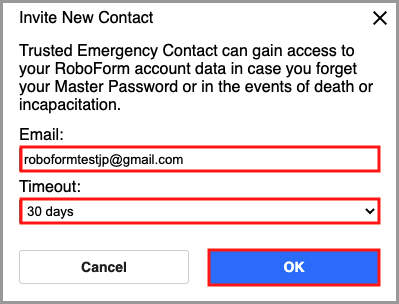

- The invited Emergency Contact will also be notified of the pending invitation via email, within the RoboForm interface, and in the "I'm Emergency Contact For" tab on the Emergency Access page, where they can choose to accept or decline the invitation.
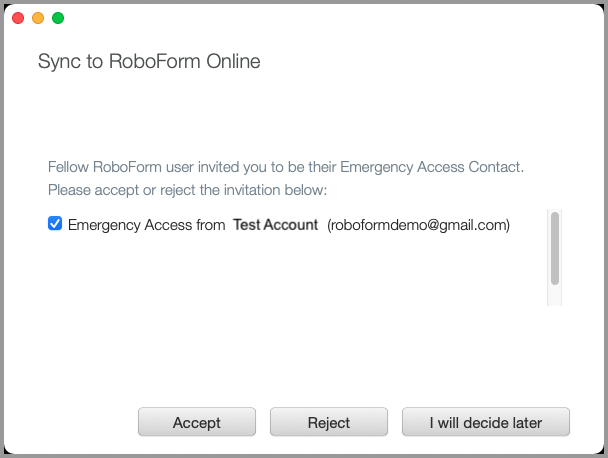

- The Emergency Access grantor will be notified when the invited Emergency Contact accepts or declines the invitation. The grantor will need to log in and/or sync the account after the invitation has been accepted.

- Upon accepting the invitation, Emergency Contacts have the option to request access to the grantor's RoboForm account data. You can do this through the Emergency Access page on the Start Page by clicking the "I'm Emergency Contact For" tab, clicking the 3 dots on the right of the account you are the Emergency Contact for, and selecting "Request Access" from the menu. A window will appear prompting you to confirm the request. Click the blue "Yes" button on this window.
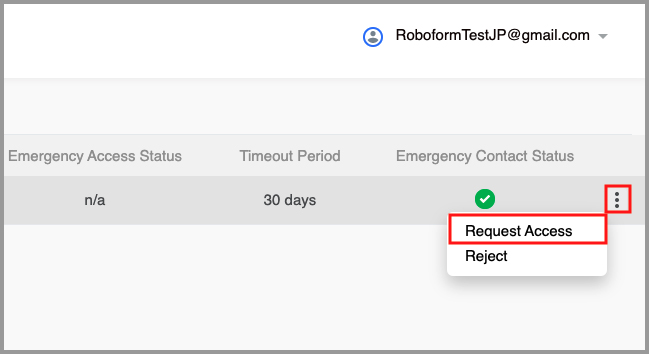
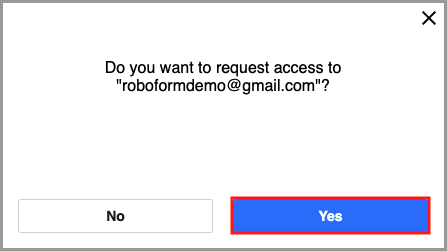
- Once the Emergency Contact sends the access request, they will receive confirmation of the sent request via email and within RoboForm's interface; the timer starts counting down the preset timeout period.

- As soon as the Emergency Contact requests access, the Emergency Access grantor is notified via email and within RoboForm's interface. They now have the option (within the preset timeout period) to manually grant, revoke, or not respond to the pending request.
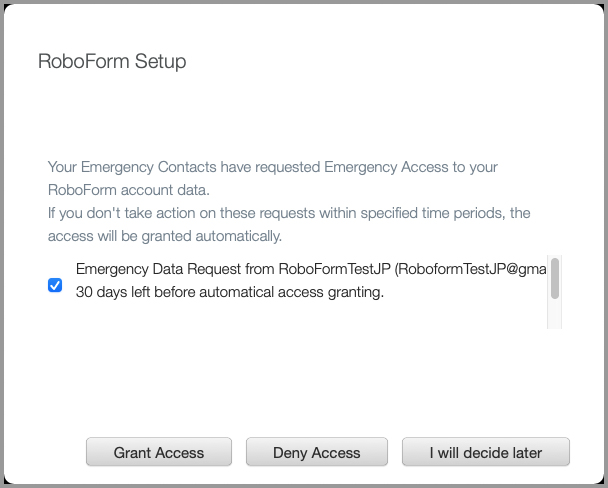

- If the request is manually granted or no reply is provided within the preset timeout period, the Emergency Contact will receive access to all of the grantor's RoboForm account data. The request for access can also be rejected by the Emergency Access sender within the same preset timeout period. In the case of rejection, the Emergency Contact will be notified, and no data will be shared.


- The Emergency Contact can access the grantor's data through the Emergency Access page on the Start Page by
clicking the "I'm Emergency Contact For" tab, clicking the 3 dots on the right of the account you are the Emergency
Contact for, and selecting "Get Data" from the menu.
The Emergency Access grantor's account data will open in view-only mode with an option for the Emergency Contact to also download specific items or the entire Emergency Access sender's RoboForm account data. The downloaded data will show up in the Emergency Contact's RoboForm account under a folder named after the grantor's email.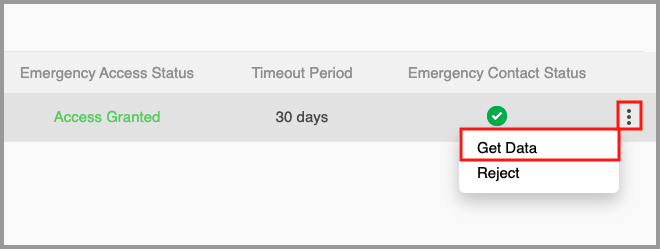
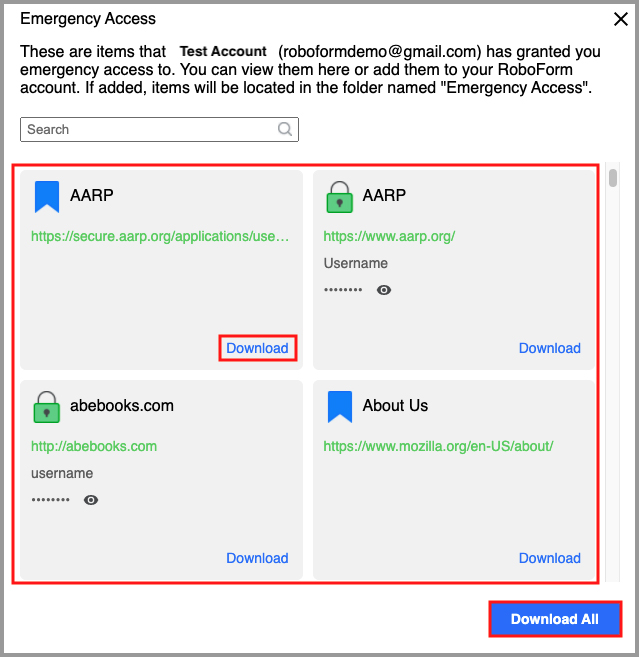
Chapter 15: Security Center
The Security Center identifies whether your passwords stored in RoboForm are unique, complex, and randomly generated. It also suggests which of your passwords should be changed and made stronger.
The Security Center is located:
- On the Start Page:
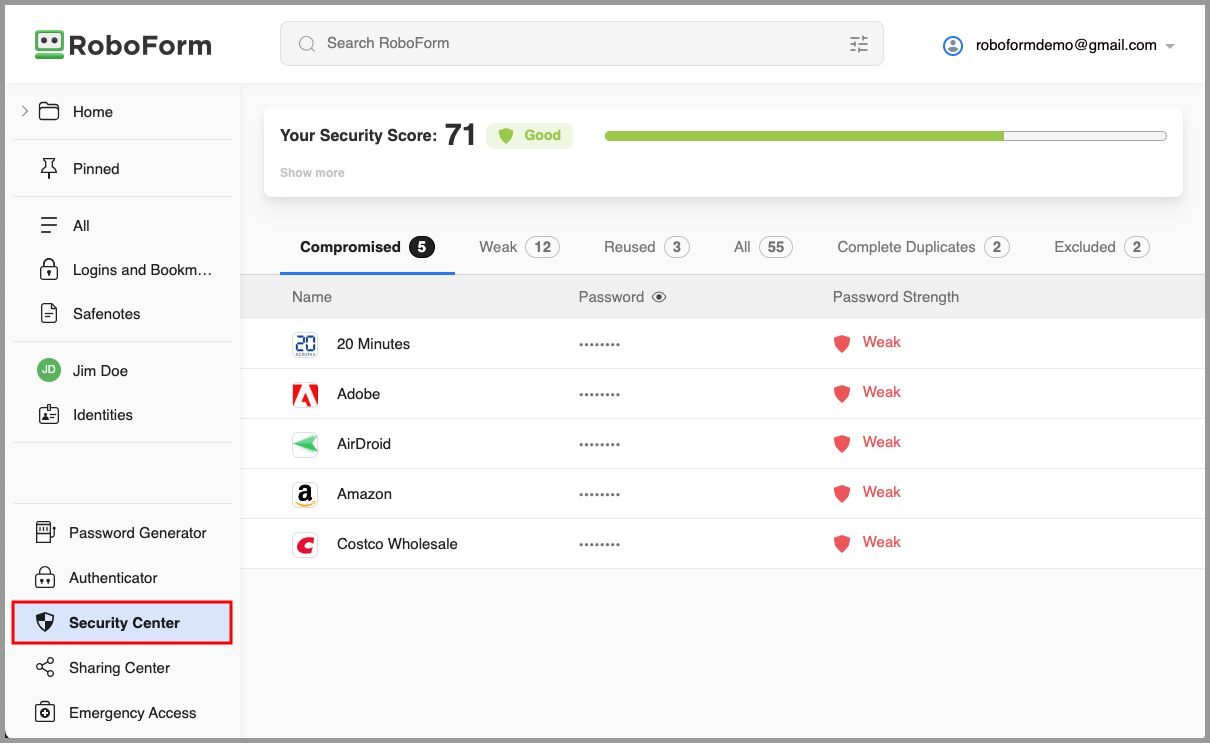
- In the RoboForm Editor as a tab in the Left Panel:
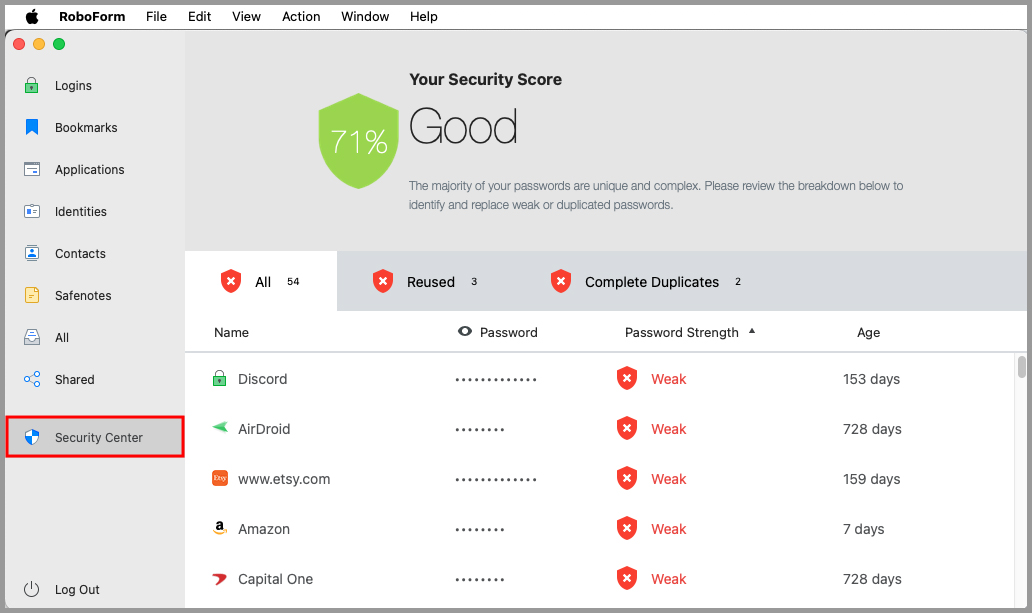
Security Score
What is the Security Score?
The Security Score represents the collective strength of all of your individual passwords. It is made up of an overall score out of 100, a rating (e.g., “Good”), and a recommendation of how to improve the score. The rating of the Security Score is divided into sections: Low (0-25%), Average (26-50%), Good (51-75%), and Excellent (76-100%).
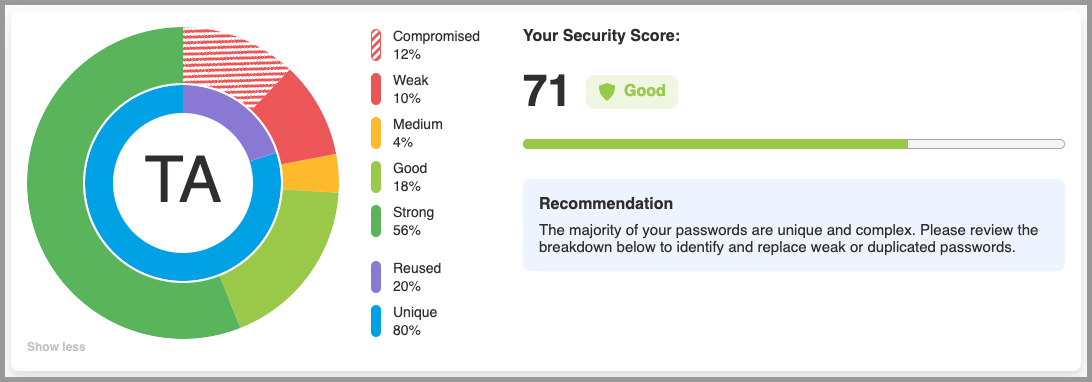
How is my Security Score calculated?
Your Security Score is calculated based on the following factors:
- Number of Compromised or Weak passwords
- Number of Duplicated Logins (username and password combinations)
- Number of Unique passwords
- Strength of individual passwords, which is based on:
- Password strength evaluation by the zxcvbn algorithm
- Checking the password against our Compromised Passwords base
- Checking whether the password is re-used
There are four possible password strengths:
- Strong: A password marked strong is considered Strong by zxcvbn, is not enlisted in the Compromised Passwords base, and is used only once.
- Good: A password marked good is considered Good by zxcvbn, is not enlisted in the Compromised Passwords base, and is used only once.
- Medium: A password marked medium is considered Medium by zxcvbn, is not enlisted in the Compromised Passwords base, and is used only once.
- Weak: A password can be marked weak for the following reasons:
- It is considered Weak by zxcvbn
- It is listed in the Compromised Passwords base
- It is considered Good or lower by zxcvbn, is not enlisted in the Compromised Passwords base, and is used for two different domains
- It is considered Strong by zxcvbn, is not enlisted in the Compromised Passwords base, and is used for three or more different domains
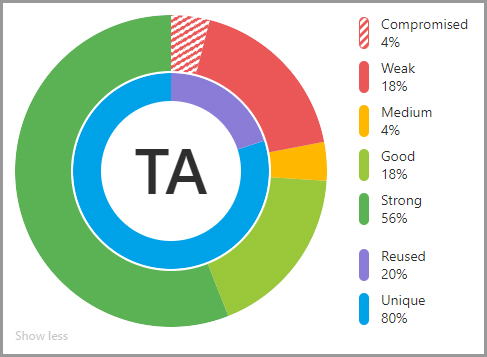
Security Center Overview
Once in the Security Center, you will see your Security Score displayed at the top of the window, with the individual password breakdown below. Clicking "Show more" beneath your Security Score will present you with a more detailed breakdown of the strength of your passwords.
Password strength for individual passwords is calculated using an algorithm based on zxcvbn. Logins can be sorted based on Name, Password Strength, or Age (starting with when they were stored in RoboForm).
NOTE: Sorting by age is only possible in the Weak, Reused, and All tabs.

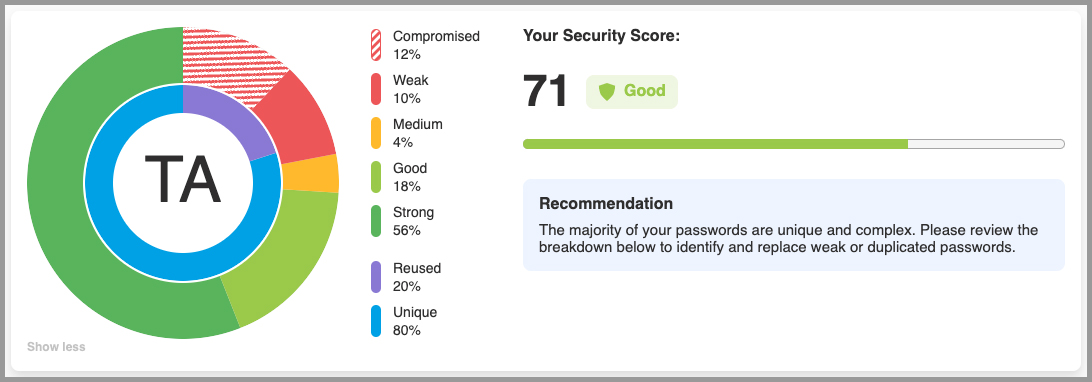
When you first open the Security Center, you will be on the Compromised Tab. To update a Compromised Login, or to increase a weak password’s individual strength and, by extension, the overall Security Score, hover your mouse over a Login and click the "Log In" (play button) button which will appear. Then, use the site’s procedure to update the password using the RoboForm Password Generator. Once saved in RoboForm, the Security Center will recalculate the score.
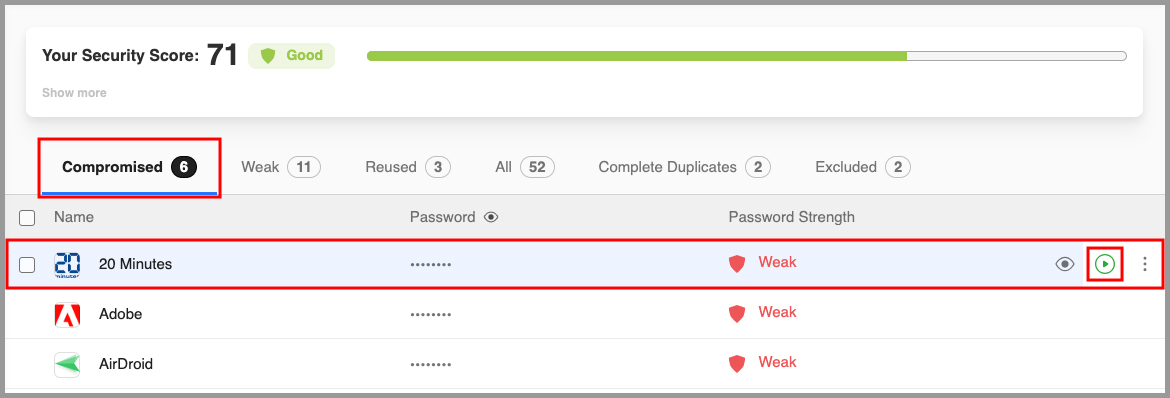
Compromised
The Compromised tab contains Logins with passwords that have previously been seen in a documented data breach where hackers released the stolen data publicly or sold it on the dark web. To learn more about Compromised Passwords and what to do if you see them, click here.
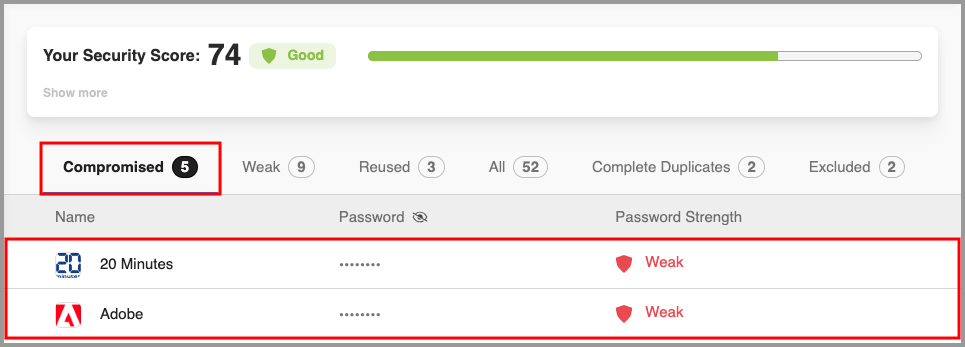
Weak
The Weak tab contains Logins with passwords which have a weak password strength score. We recommend that you update these passwords using the RoboForm Password Generator. To read our tutorial on using the RoboForm Password Generator, click here.
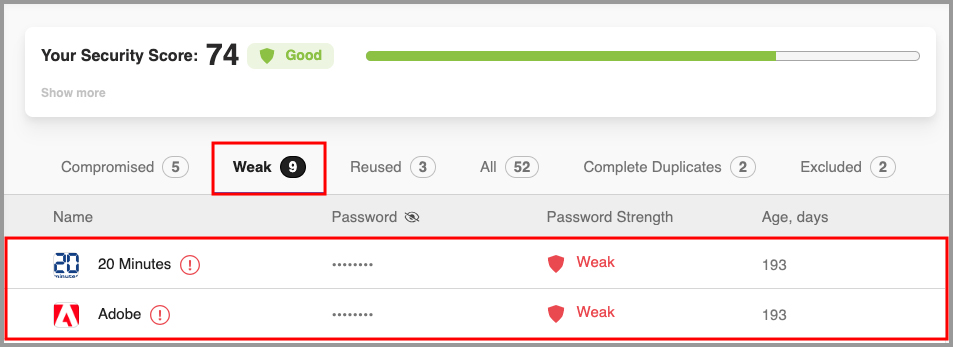
While viewing a Login with a password rated as Weak, you can view an explanation on why it was rated that way.
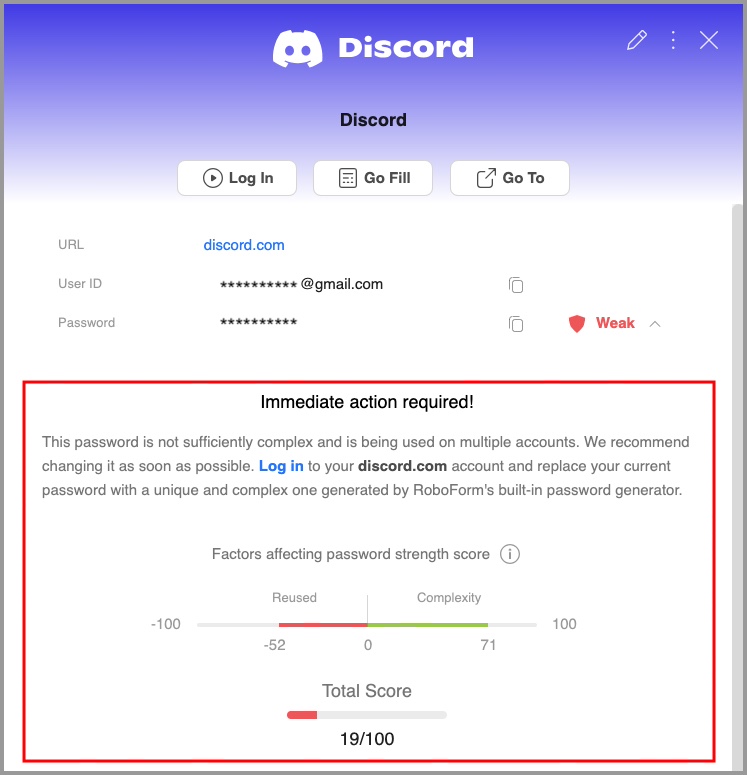
Reused
The Reused tab contains Logins with passwords you have reused multiple times. These passwords are grouped together based on their respective Logins.
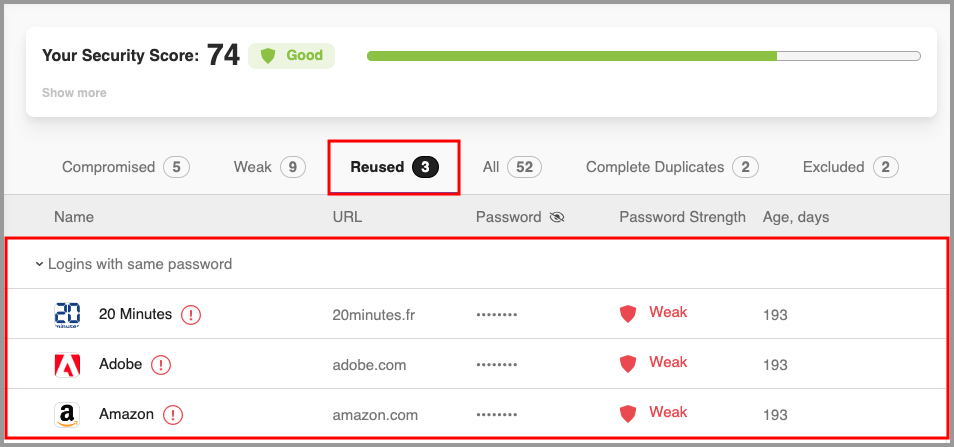
All
The All tab contains all of your RoboForm Logins along with their Password Strength and Age.
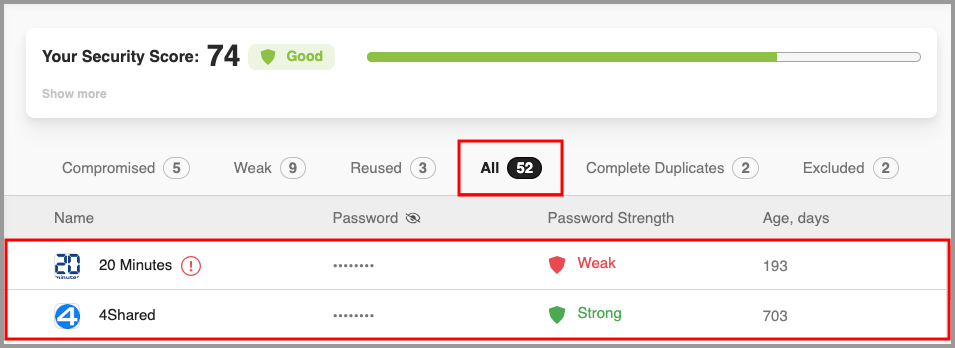
Complete Duplicates
The Complete Duplicates tab contains Logins which have an identical username and password. The Security Center makes finding and deleting them a one-step process.
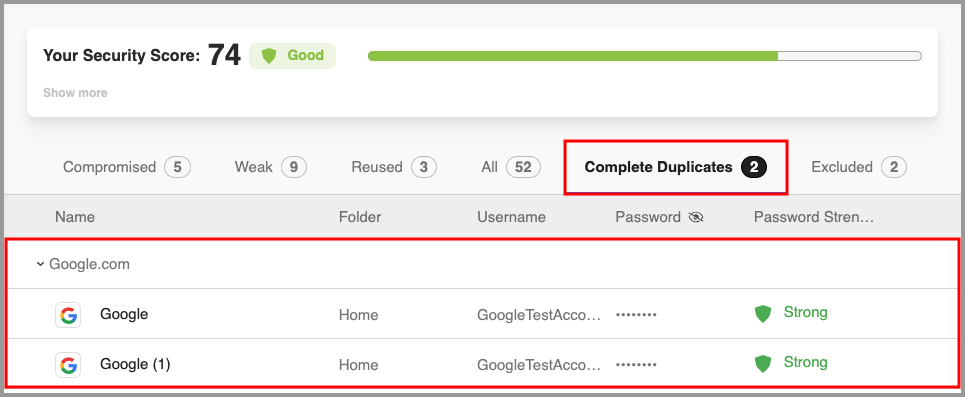
Excluded
The Excluded tab contains Logins which you have selected to be excluded from your Security Score calculation. To learn how to exclude a Login from your Security Score, click here.
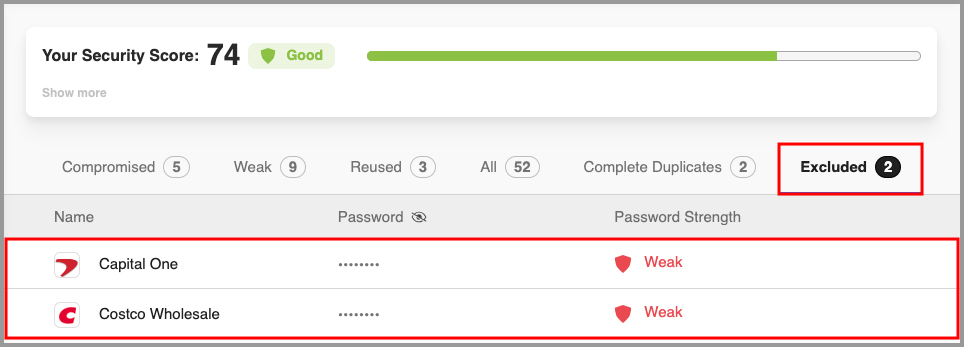
Compromised Passwords
On the Start Page, the Security Center also has a “Compromised Passwords” tab.
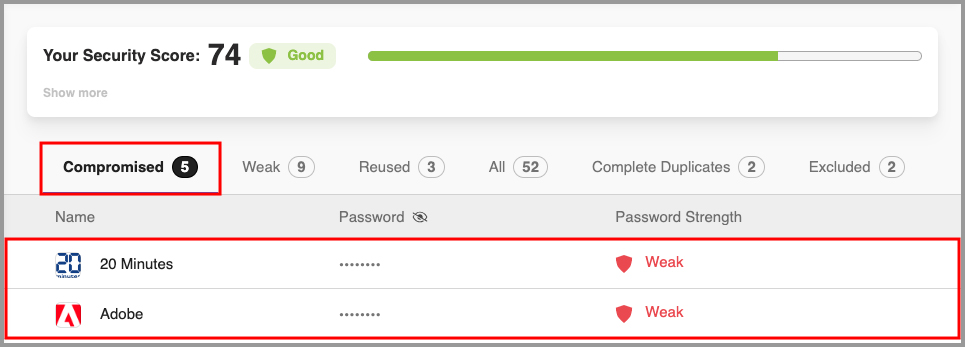
What is a compromised password?
A compromised password is an individual password that has previously been seen in a documented data breach where hackers released the stolen data publicly or sold it on the dark web. To detect compromised passwords, RoboForm checks against a list maintained by Have I Been Pwned (HIBP), a service that collects passwords exposed in data breaches.
How can I tell which of my passwords have been compromised?
Logins with compromised passwords are marked with a red exclamation point icon.

What should I do if I see a password that is compromised?
You should update it immediately. To update a compromised password, follow these steps:
- Click the house icon
 in the upper left of the RoboForm extension to go to the Start Page.
in the upper left of the RoboForm extension to go to the Start Page. - Select "Security Center" in the bottom left navigation tab, then go to the "Compromised" tab.
- Hover your cursor over top of the Login in the Compromised tab on the Start page and click the "Log In" (play button) button.
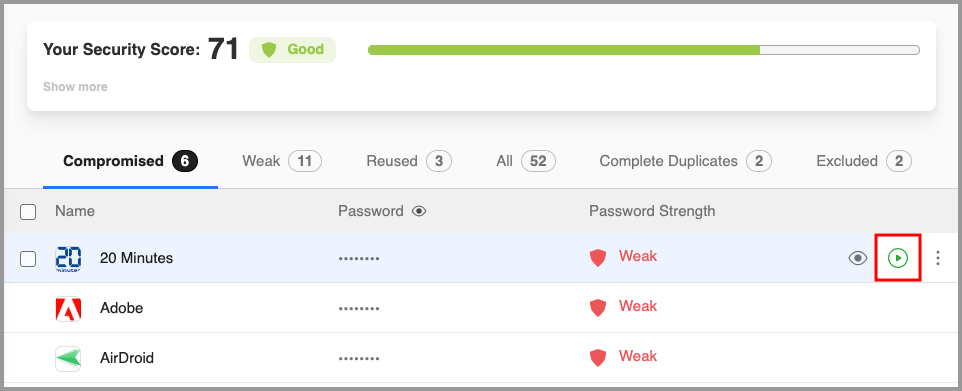
Once logged in, go to the site’s “Change Password” menu. Use the RoboForm Password Generator to create a complex password rated Strong. From there, RoboForm will save the updated password, remove the exclamation point indication, and update your Security Score accordingly.
For help using the RoboForm Password Generator, click here for our tutorial video and article.
Other Common Questions
I can't or don't want to change a password marked as compromised. How can I remove the red exclamation point icon?
Excluding the compromised password from your Security Score will also remove the red exclamation point icon. To exclude a compromised password, follow these steps:
- Click the house icon
 in the upper left of the RoboForm extension to go to the Start Page.
in the upper left of the RoboForm extension to go to the Start Page. - Select "Security Center" in the bottom left navigation tab, then go to the "Compromised" tab.
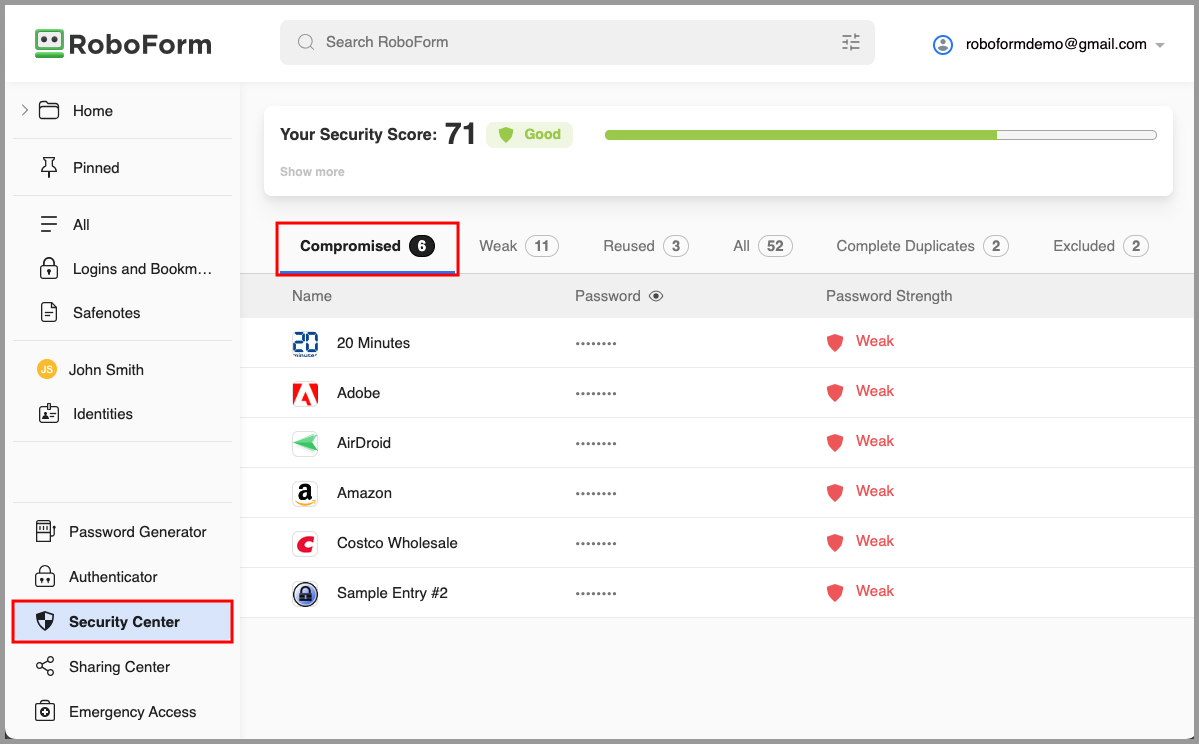
- Hover your mouse over the login you wish to exclude the password for and click the 3 dots which will appear on the right.
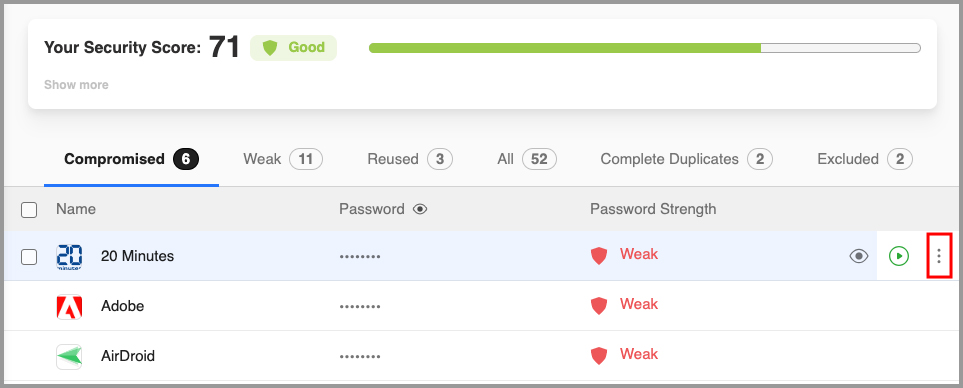
NOTE: If you would like to select multiple Logins from the Compromised passwords list, hover your mouse over top of one of the items you wish to select and then check the box which will appear on its left.
Once this box is checked, a menu will appear at the top of your Compromised passwords list with options to:
- Exclude from Security Score - Excludes all checked Logins from your Security Score.
- Batch Log In - Opens all checked Logins in new tabs and logs you in to each.
- Move - Allows you to change the folder all checked Logins are stored in.
- Clone - Allows you to duplicate all checked Logins.
- Delete - Allows you to delete all checked Logins.
- Select All - Allows you to select every Login in the Compromised passwords list.
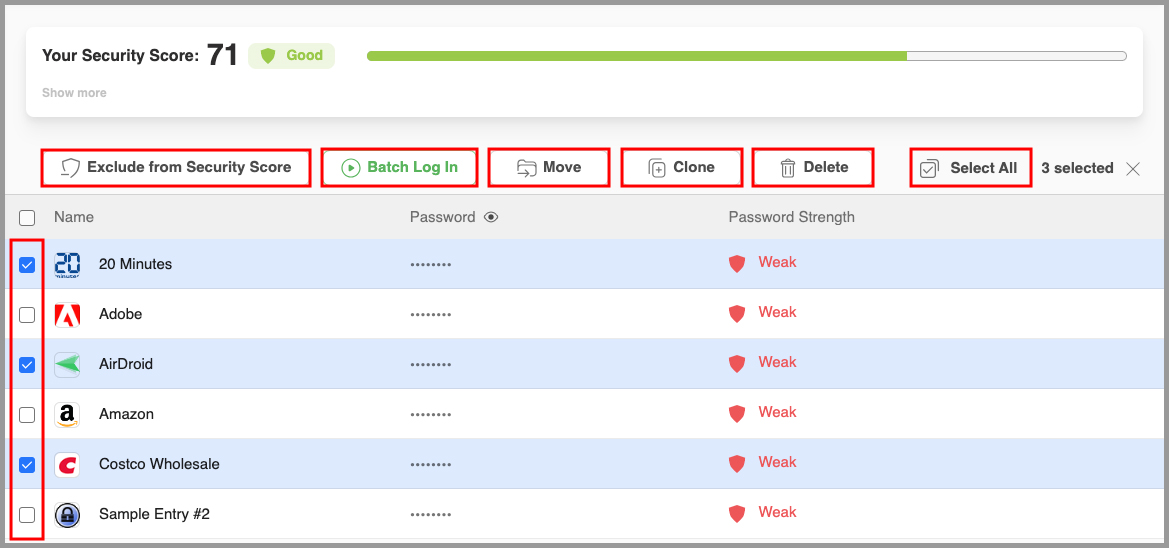
- Select "Exclude from Security Score" from the menu. RoboForm will no longer display the red exclamation point for this Login or include it in your Security Score.
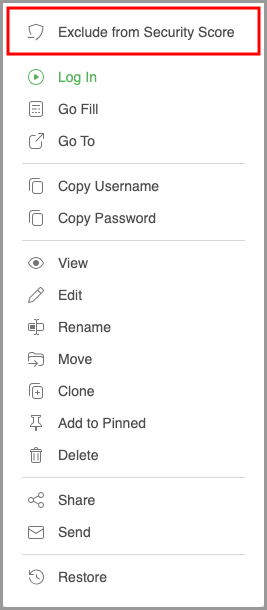
NOTE: If you wish to re-include this Login, you can do so by going to the "Excluded" tab and then clicking the "Include in Security Score" (shield icon) button.

How do I remove the red exclamation point icon from showing up for all Logins?
- Click the house icon
 in the upper left of the RoboForm extension to go to the Start Page.
in the upper left of the RoboForm extension to go to the Start Page. - In the top right under your account email, click the "Settings" option.
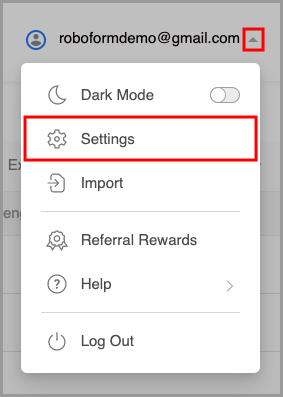
- Under the "Security" tab, toggle off the "Show compromised passwords indicator" option. Then, click the blue "Done" button in the upper right corner.
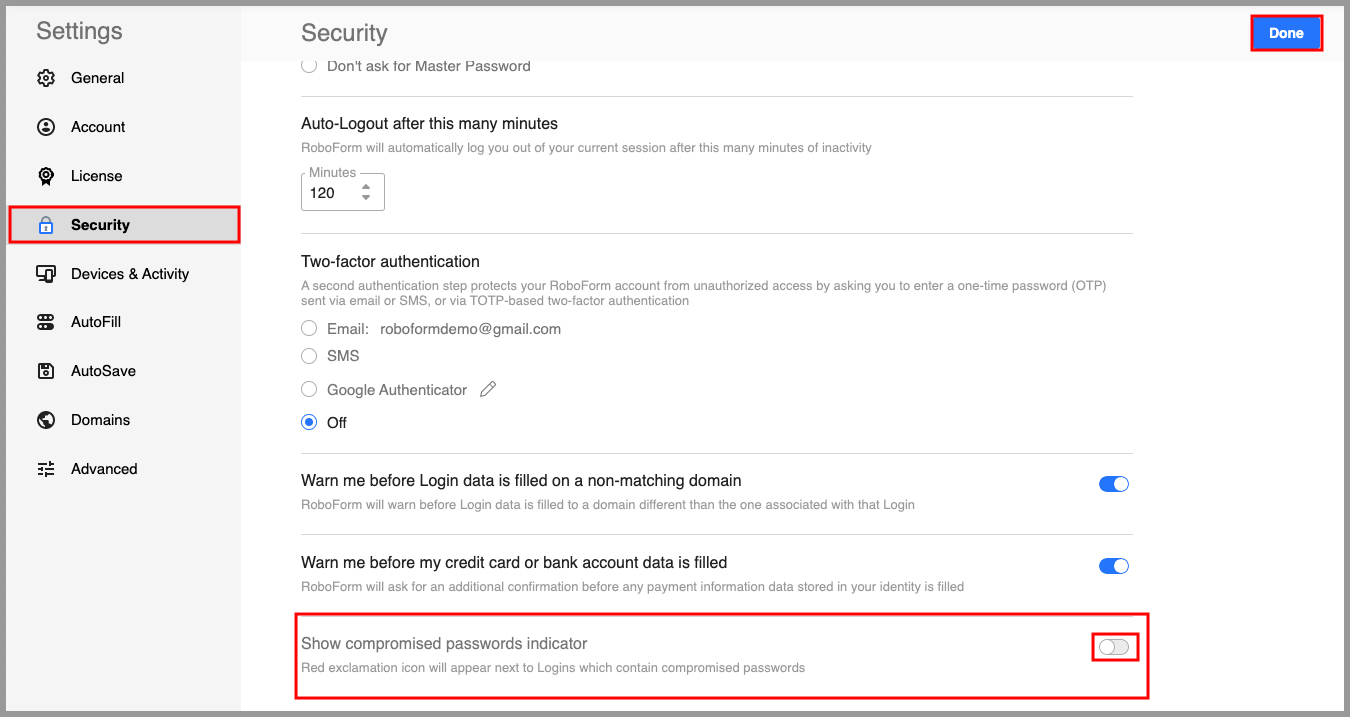
How does RoboForm know that a password is compromised?
RoboForm checks against the Pwned Passwords list maintained by HIBP. The list is comprised of hundreds of millions of real-world passwords previously exposed in data breaches. This exposure makes them unsuitable for ongoing use as they're at much greater risk of being used to take over other accounts.
How does RoboForm securely and anonymously scan my passwords without revealing them?
The passwords on the full HIBP list of compromised passwords are hashed with SHA-1. In addition, the RoboForm client does not transmit complete password hashes when checking against the list. As discussed in more detail here, we use a technique called k-anonymity in order to verify without revealing the individual password.
Can RoboForm tell me when or where an individual compromised password was hacked?
No. Our provider HIBP does not store any information about who the password belonged to, only that it has previously been exposed publicly and how many times it has been seen.
How to Improve Your Security Score
Improving your security score means regularly updating compromised, weak, reused, or duplicated passwords. To elevate your score, utilize our password generator to create random, unique, and complex passwords. To read more about how to improve your Security Score using the RoboForm Password Generator, click here.
For example, a weak password would be something like "ABC123!". Go to the "Change Password" page for the account associated with this password, and hover your mouse over top of the RoboForm icon next to the "New Password" field.
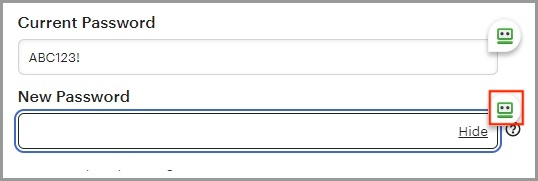
Then, use the RoboForm Password Generator to generate and fill a new password which is rated strong, for example: x3XB9Eu5VcKz67&^.
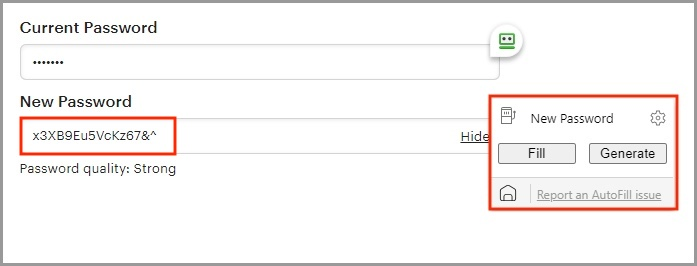
Chapter 16: RoboForm Online
RoboForm Online is now the same as the Start Page. You can still log in to RoboForm online through RoboForm’s website, but the appearance is now identical to the Start Page.
You can find RoboForm Online here. Simply log in with the email that is associated with your RoboForm account and your RoboForm Master Password.
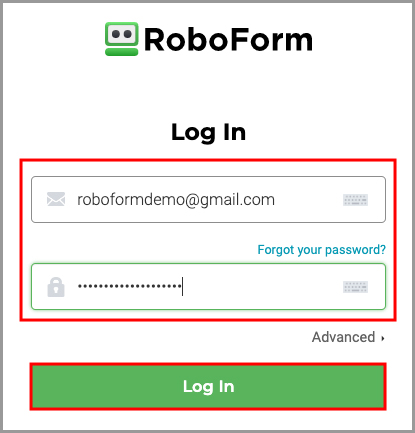
For information on RoboForm Online, please refer to Chapter 17: Start Page.
Chapter 17: RoboForm Start Page
The RoboForm Start Page is available here and allows quick access to all of your Logins, Bookmarks, Safenotes, Identities, Contacts, and more.
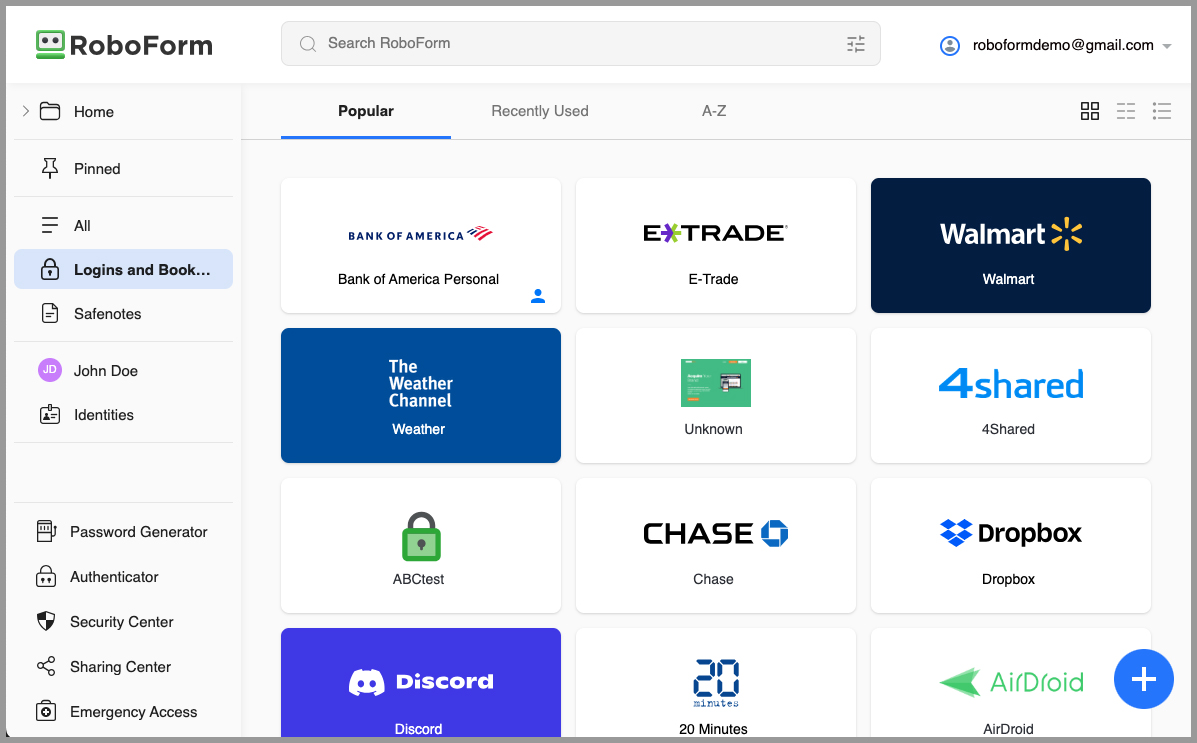
Accessing The Start Page
To use the RoboForm Start Page, the RoboForm Browser Extension must be installed into the browser you wish to use. You can easily access the Start Page by clicking the RoboForm Extension in your browser, and then clicking the house icon in the upper left corner.
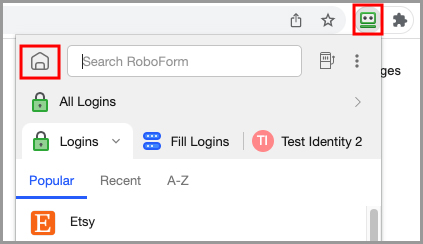
Navigating The Start Page
Sorting
You can sort/view your RoboForm data via the three selections listed under the search bar: Popular (most frequently used), Recently Used (most recently used), and A-Z (alphabetical order).

Folders and Item Types
In the left navigation bar, clicking the drop-down to the left of the Home folder will display a list of all subfolders:
- The All tab will display a list of all RoboForm data files and folders (Logins, Identities, Bookmarks, Contacts, and Safenotes).
- The Logins and Bookmarks tab displays a list of Logins and Bookmarks only.
- The Safenotes tab displays a list of Safenotes only.
- The Identities tab displays a list of Identities only.
- Clicking on an Identity listed in this column will open the Identity for viewing.
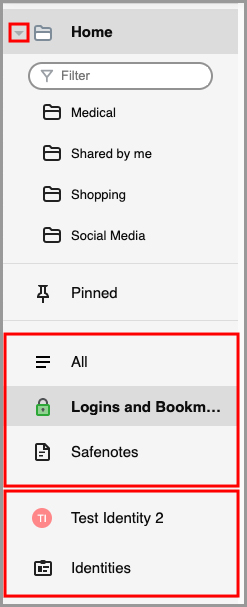
If you click directly on the Identity in the column on the left, or you go to the Identities tab and click on an Identity, you will open a window which displays the information attached to that Identity. This information can be edited as needed by clicking the Pencil icon in the top right corner, or copied by clicking the Copy icon to the right of the pencil icon.
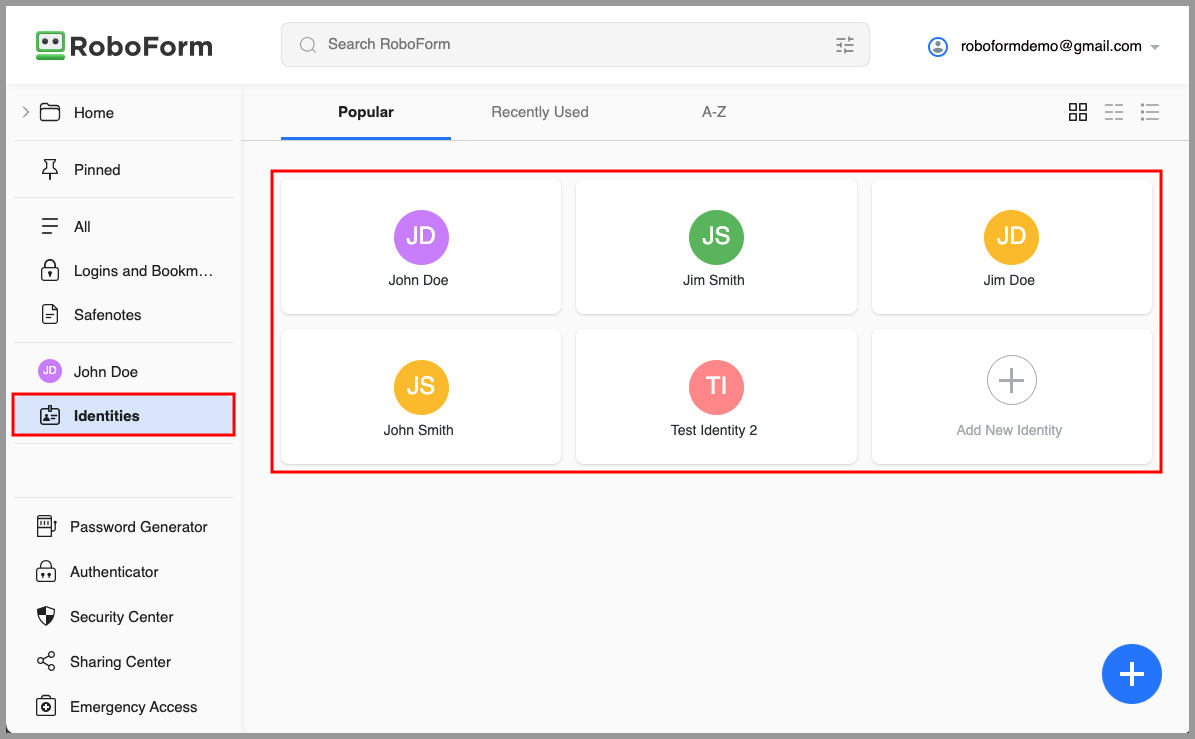
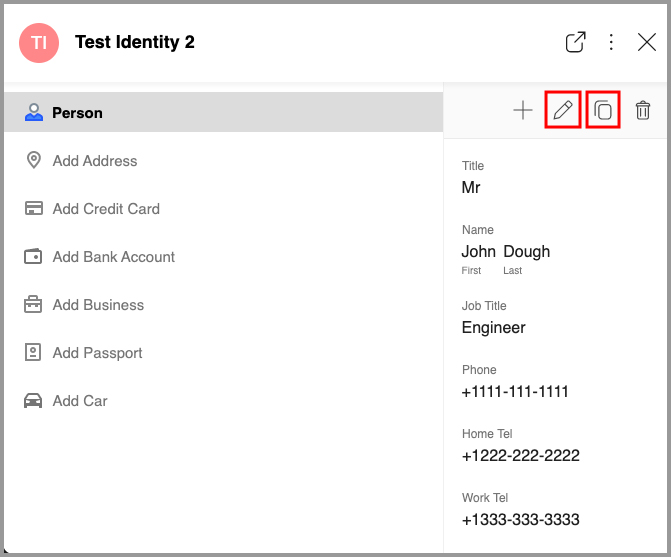
Adding Logins to Your Start Page
- While on the "Logins and Bookmarks" tab, click the blue [ + ] icon in the lower right corner of your Start Page.
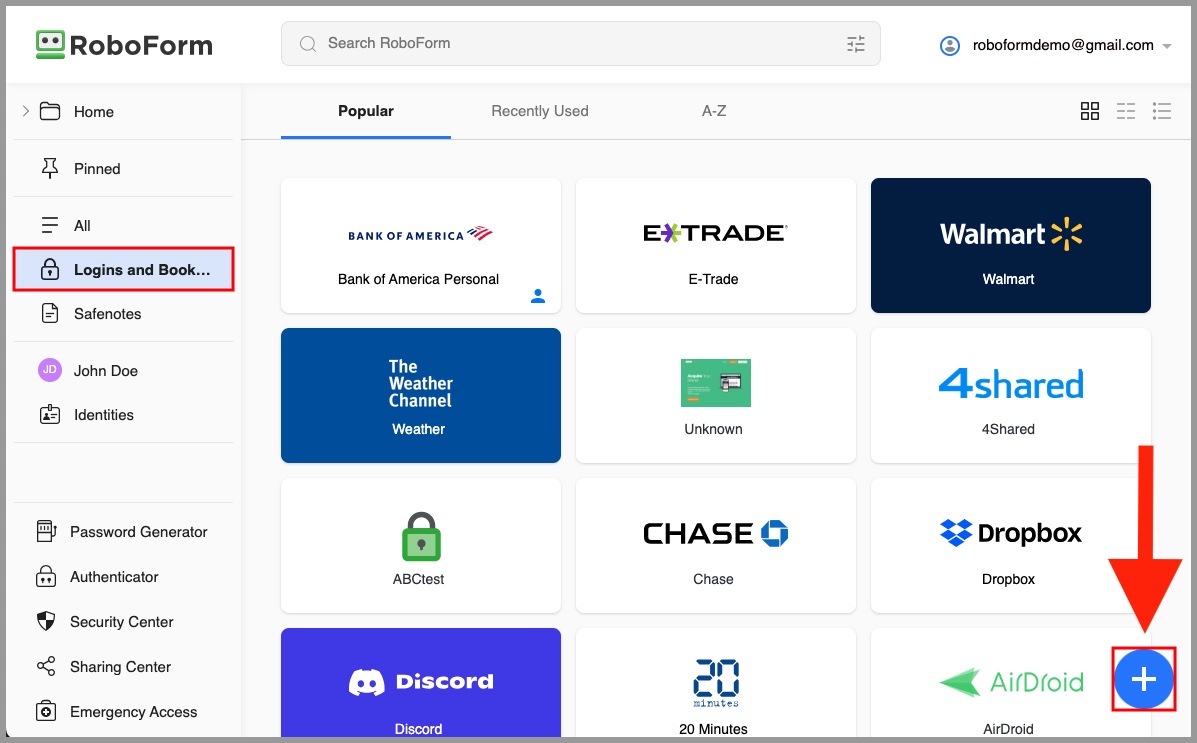
- The “Add New Login” window will appear. This window contains a list of commonly saved websites. Use the search field to search for the website you wish to save.
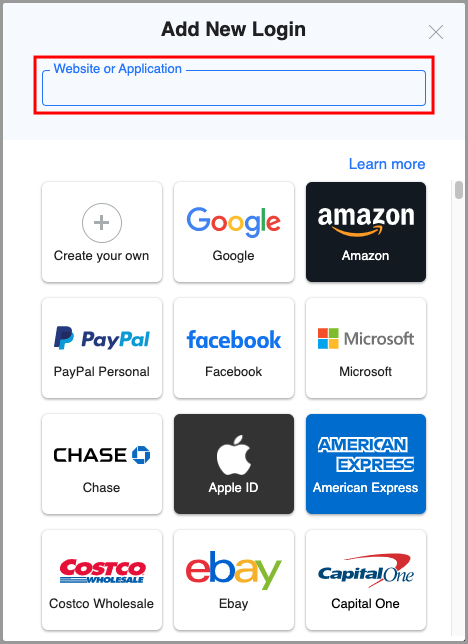
- Name the Login as you wish, enter your username and password, and select the folder you wish to store the Login in. If you would like to pin the newly saved Login to your Start Page, click the Pin icon. Use the "Add Note" button to add any notes that you would like to save with your new Login. Then, click the “Save” button.
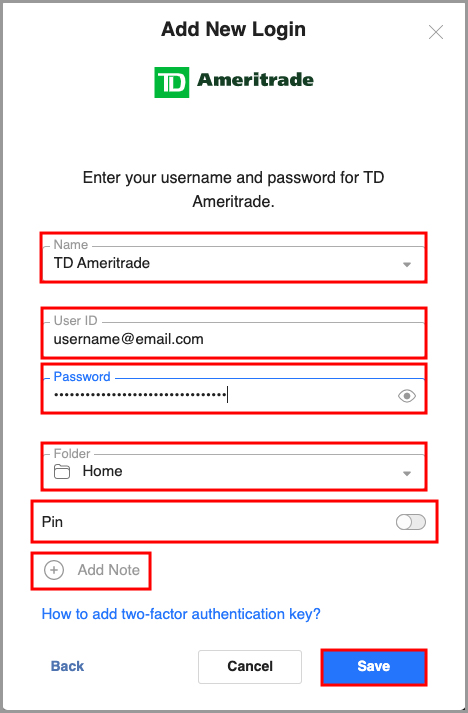
Customizing Your Start Page
There are a variety of different ways that you can customize the appearance and functionality of your RoboForm Start Page.
Start Page Layout
You can change the format in which you view your data by selecting Grid, Compact, and List icons on the right, under your account dropdown.
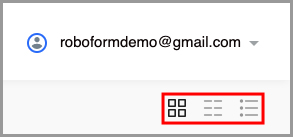
Pinned
The Pinned tab allows you to customize the Start Page with the RoboForm files you access most often. In the upper right of each Login, you can click the 3 dots and select “Add to Pinned” to add that Login to your pinned list.

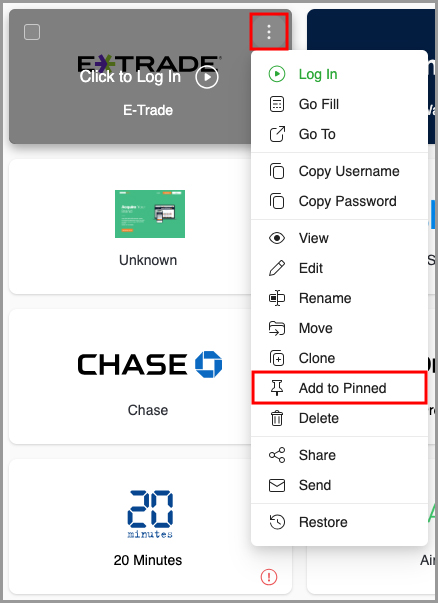
Dark Mode
You can turn on “Dark Mode” by clicking on your account’s dropdown menu in the upper right, and toggling the button next to “Dark Mode” to the “On” position. This is useful if you find bright, white screens irritating to your eyes, and would prefer a darker color theme on your Start Page.
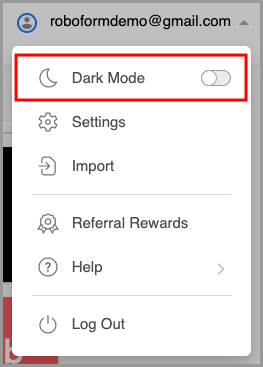
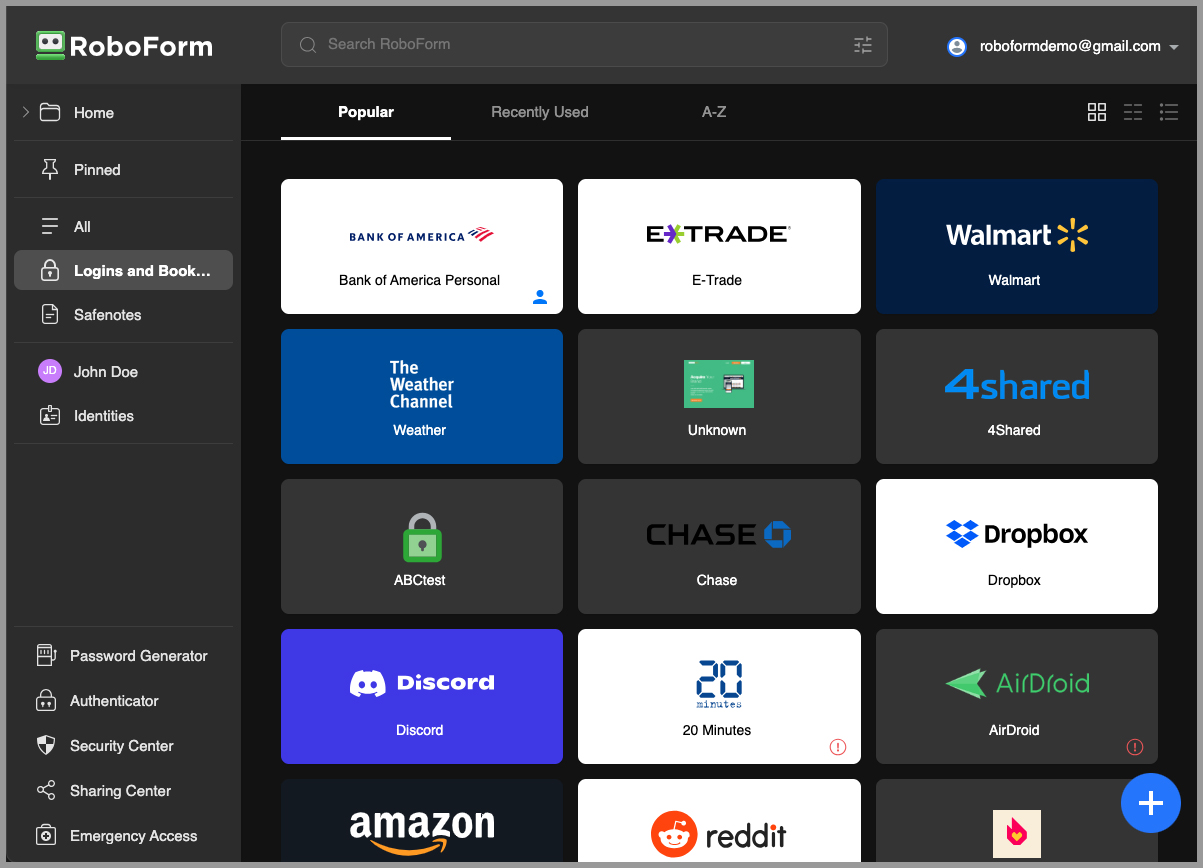
Editing Your Data from the Start Page
You may edit individual Logins, Identities, Bookmarks, and Contacts from within the RoboForm Start Page.
NOTE: You can also edit these items from the RoboForm Desktop Editor.
To edit a Login or Bookmark:
- Click the three vertical dots. Then, select “Edit” from the menu.
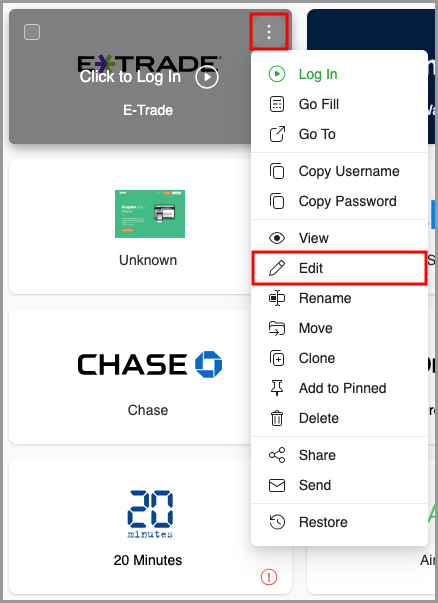
- Edit the fields as needed and then click the blue "Save" button.
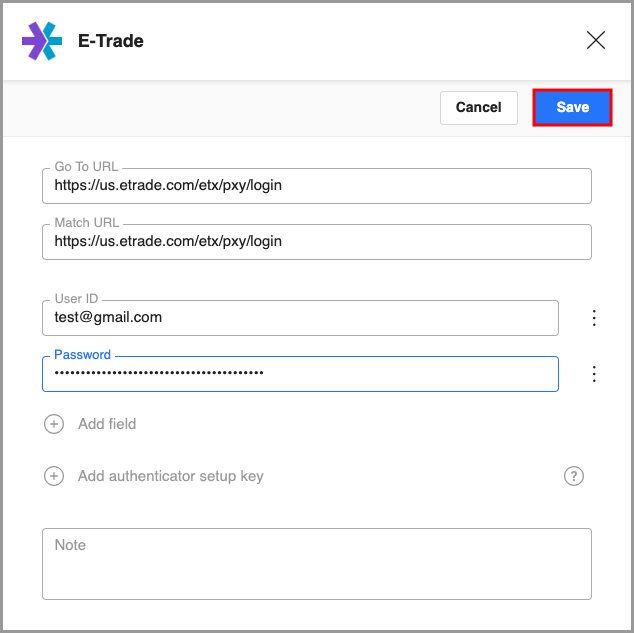
To edit an Identity or Contact:
- Click the 3 vertical dots. Then, select “View” from the menu.
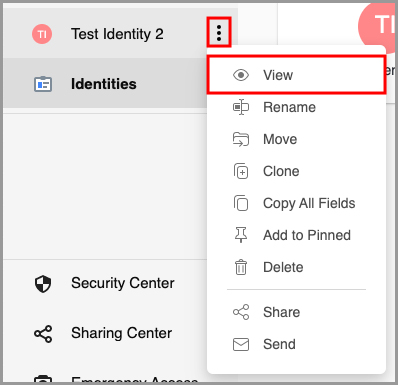
- Click the “Pencil” icon at the top right.
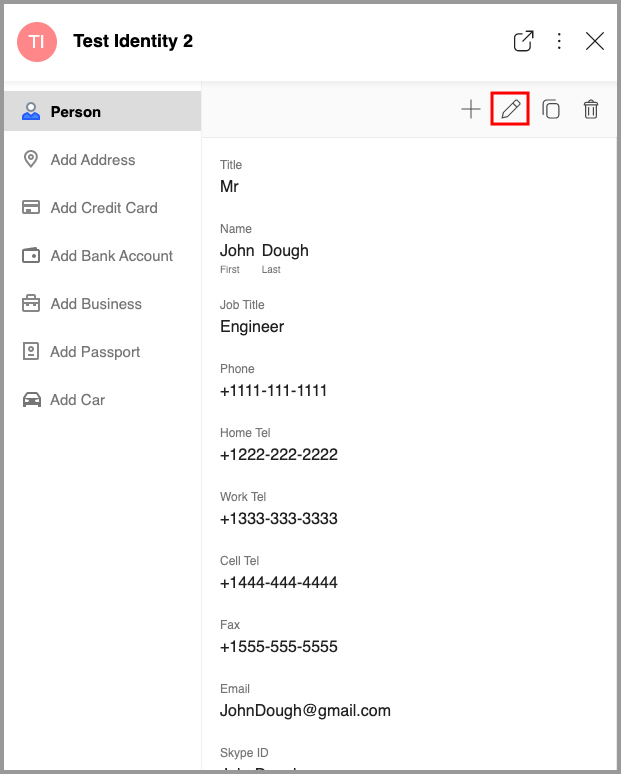
- Edit the fields as needed and then click the blue “Save” button.
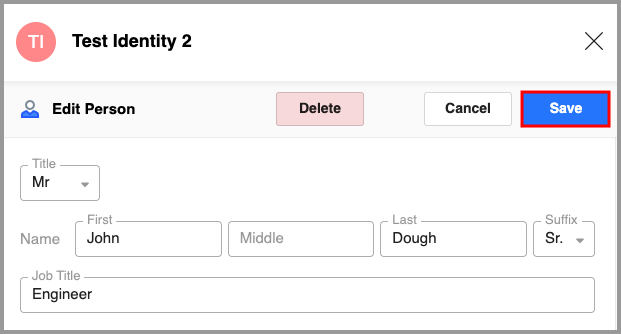
To edit a Safenote:
Go to the "Safenotes" tab and click the Safenote you wish to edit. You will now be viewing your Safenote.
On this screen, click the text field of the Safenote to edit the text. Edit the Safenote as needed and then click the blue “Save” button.

Additional Start Page Options
From the Start Page, you may also log in, go fill, go to, copy username, copy password, view, edit, rename, move, clone, delete, add to pinned, share, send, and print RoboForm Logins, Bookmarks, and Safenotes.
Click the three vertical dots located at the right-hand corner of an individual Login, Bookmark, or Safenote. Depending on whether you are selecting a Login, Bookmark, or Safenote, a menu will appear offering you some combination of options to log in, go fill, go to, copy username, copy password, view, edit, rename, move, clone, add to pinned, delete, share, send, and restore.
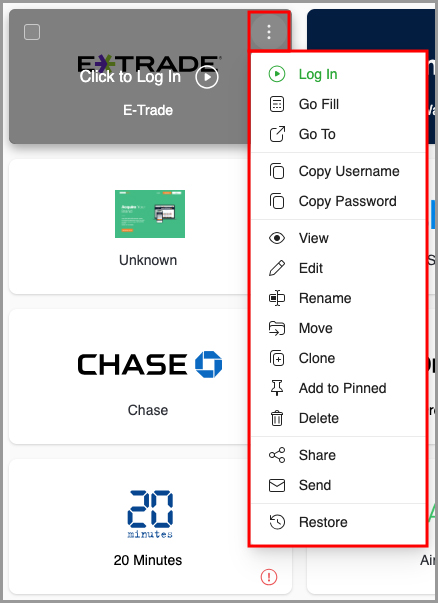
You can find the option to “Print” by selecting “View” from this menu, and clicking the 3 vertical dots in the upper right of the view page.
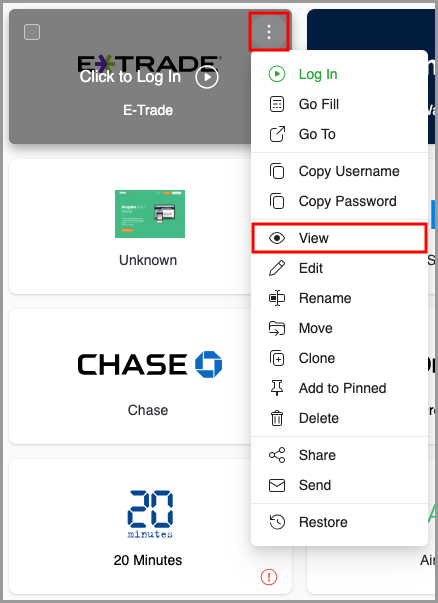
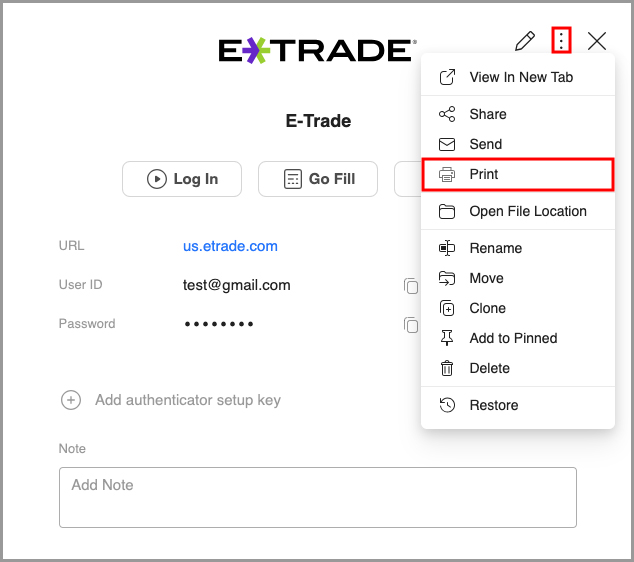
There are also options in the bottom left corner to view the Password Generator, Authenticator, Sharing Center, Security Center, and the Emergency Access page from the Start Page.
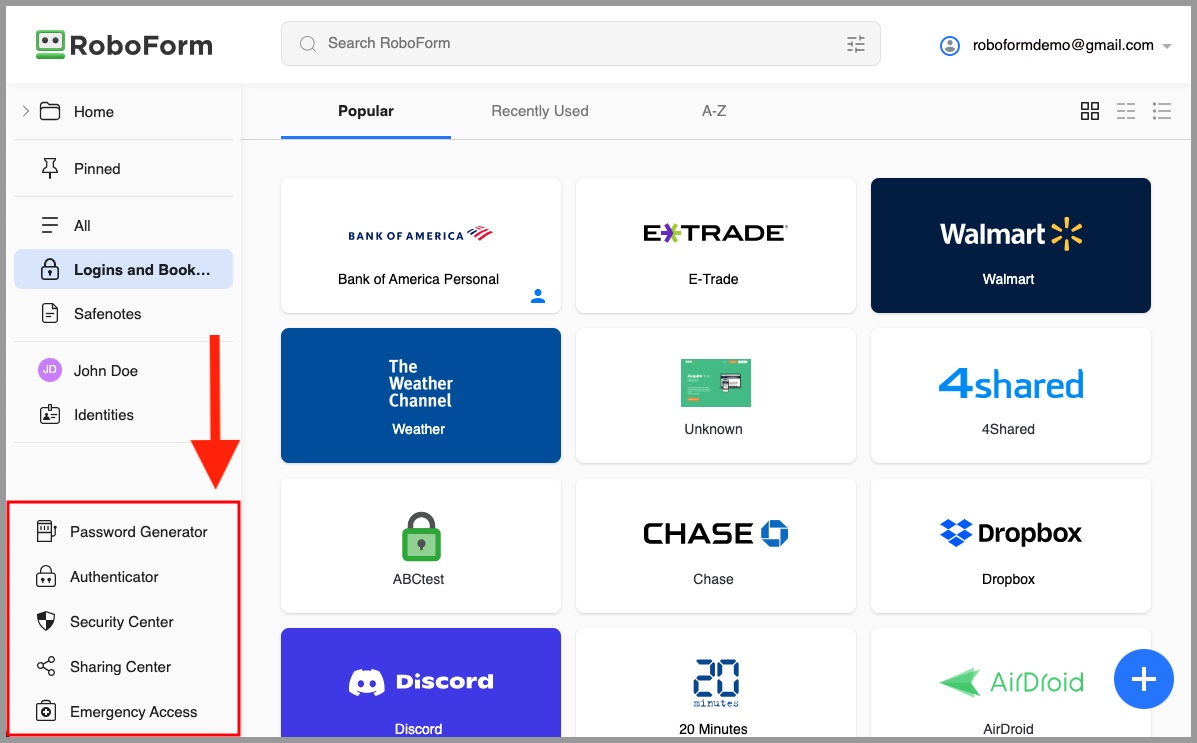
To view your account settings from your RoboForm account, you can click your account’s dropdown in the upper right, and select “Settings” from the menu.
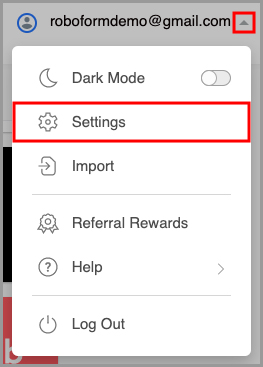
Using Start Page Search
You can easily conduct a search for any data included within your RoboForm account using the Search RoboForm bar at the top of the page.

Chapter 18: Settings
The Preferences menu contains all the options and settings for RoboForm.
Accessing Preferences
You can open Preferences by one of the following ways:
- In the RoboForm Menu Bar Icon near the date and time of your computer.
- With the Editor open, click the “RoboForm” menu in your Menu Bar and then select the “Preferences” option. This menu is only visible at the top-left of your computer when the RoboForm Editor is open.
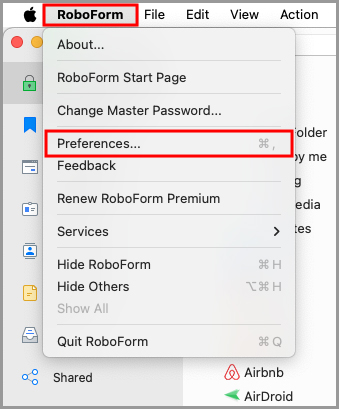
Preferences Window Layout
The Preferences window is split into two sections:
- The column on the left shows the navigation tabs: General, Integration, Security, Account & Data, and Advanced.
- The Details Pane shows the settings available for the selected navigation tab.
After making any changes, click OK to save your Preferences. Clicking OK will close the Preferences window. Cancel closes the Preferences window without saving any of your changes.
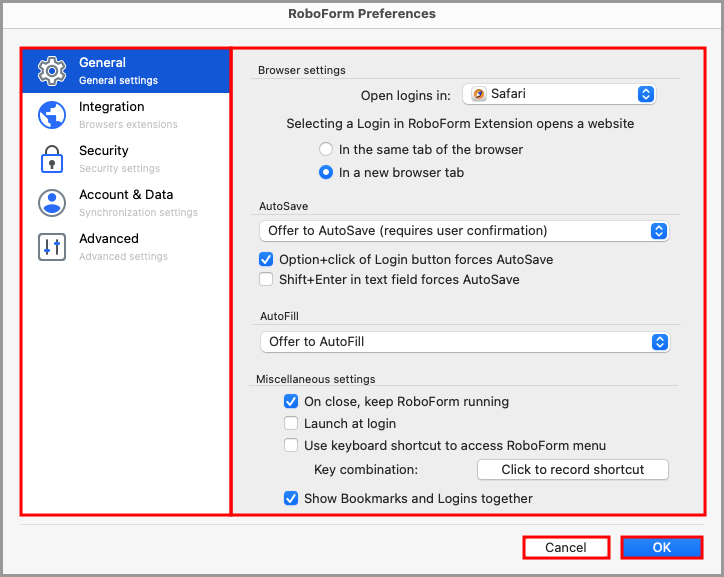
The next section will go through each tab in the Left Panel and explain the options in each tab.
General
Browser Settings
- Open logins in: Allows you to select the default browser for Logins to open in.
- Selecting a Login in RoboForm Extension opens a website:
- In the same tab of the browser - Logins opened with the extension will open in the current browser tab.
- In a new browser tab - Logins opened with the extension will open in a new browser tab.
AutoSave
- Do Not Offer to AutoSave - RoboForm will not offer to AutoSave.
- Offer to AutoSave (requires user confirmation) - RoboForm will offer to AutoSave, but will require you to confirm the action.
- AutoSave Without Asking - RoboForm will automatically AutoSave without requiring your confirmation.
- Option + click of Login button forces AutoSave - Will force AutoSave when you hold the Option key and click the Login button.
- Shift + Enter in text field forces AutoSave - Will force AutoSave when you hold the Shift key and press the Enter key.
AutoFill
- Do Not Offer to AutoFill - RoboForm will not offer to AutoSave.
- Offer to AutoFill - RoboForm will offer to AutoSave.
- AutoSave Without Asking (if only one choice) - RoboForm will automatically AutoSave without requiring your confirmation, if only one choice is available.
Miscellaneous Settings
- On close, keep RoboForm running - When the Editor is closed, RoboForm continues running.
- Use keyboard shortcut to access RoboForm menu - Allows you to set up a keyboard shortcut to open the Status Menu Icon.
- How to set up a keyboard shortcut:
- Check the box and then click the “Click to record shortcut” button.
- Type one of these shortcut keys: Command ⌘; Shift ⇧; Option ⌥; Control ⌃; and then type any letter or number. For example, ⌘ + C. Saving this will allow you to open the Status Menu with your shortcut.
NOTE: This command only works when RoboForm is logged into.
- How to set up a keyboard shortcut:
- Show Bookmarks and Logins together - Combines your Bookmarks and your Logins into the Logins menu in the RoboForm Extension.
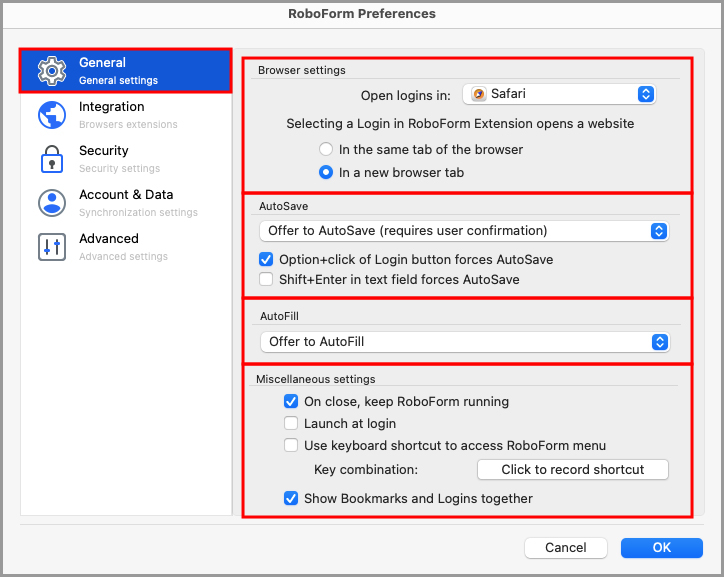
Integration
This tab shows which Browsers and Applications can connect to RoboForm.
You can install the RoboForm browser extension or, if it is already installed, manage the extension by clicking the “Manage Extension” button below each browser listed.
NOTE: Make sure to check the browser’s Extension settings page to ensure that RoboForm has no barriers to being activated on your browser.
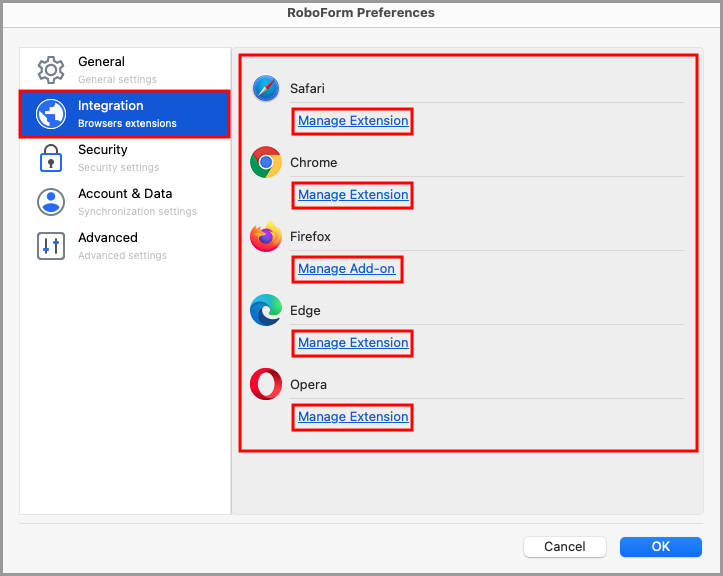
Security
This page provides Security options.
Master Password
- The Set Master Password… button allows you to change your Master Password.
Unlocking
- Don’t ask for Master Password - Checking this box will turn off your Master Password. For security reasons, we recommend against this.
- Enable Touch ID - Checking this box will enable Touch ID if you have a Mac Touch ID attached to your computer.
- Enable Apple Watch - Checking this box will enable integration with the Apple Watch.
Auto-Logout
- Auto-Logout on User Switch or Lock Workstation - When checked, means that RoboForm will automatically log you out when you switch Users or lock your workstation. You can turn this off by unchecking it.
- Auto-Logout after this many minutes - Shows the amount of minutes before Automatic Logoff. To change the time period, simply type in a number or click the up and down arrows to select a number of minutes.
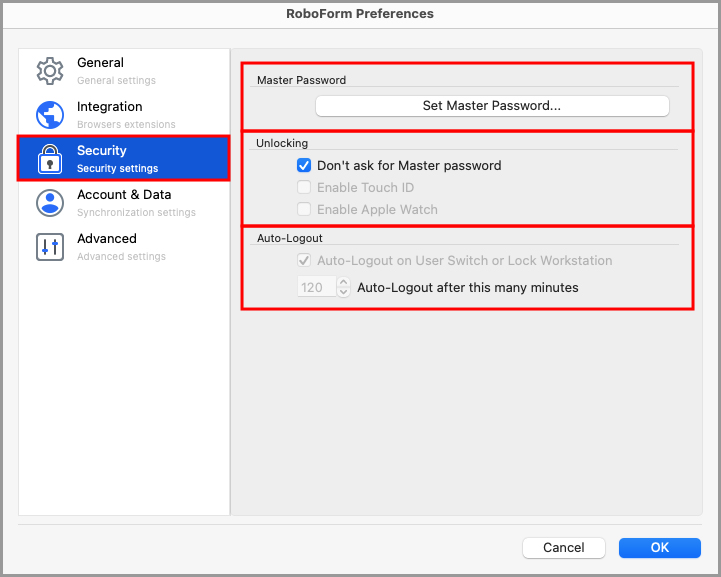
How to Change Master Password:
- Click the RoboForm icon in the top right of your screen on the Menu Bar. Click the 3 dots in the upper right corner. Then, select "Settings" from the menu.
- Select "Security" from the column on the left. Then, click the "Set Master Password" button at the top of the window.
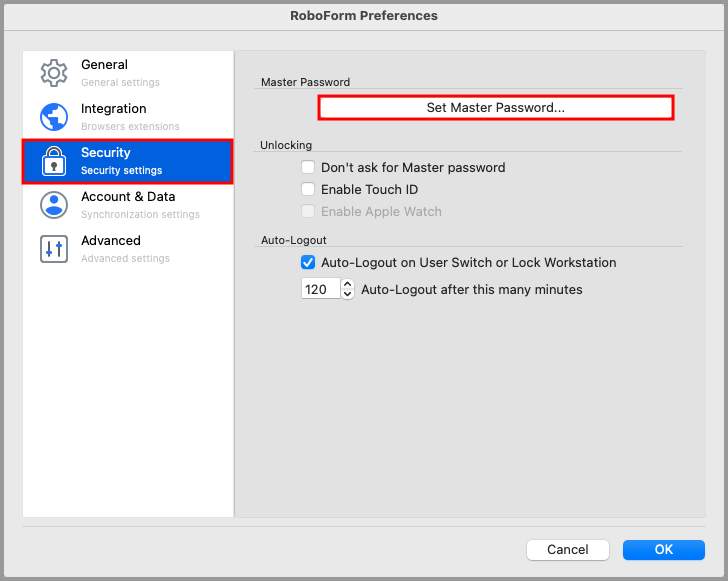
- You will be prompted to enter your current Master Password. Enter it, and click the blue "Next" button. On the next page, enter a new and secure Master Password that you will be able to remember and then re-enter it to confirm. Then, click the blue "Next" button.
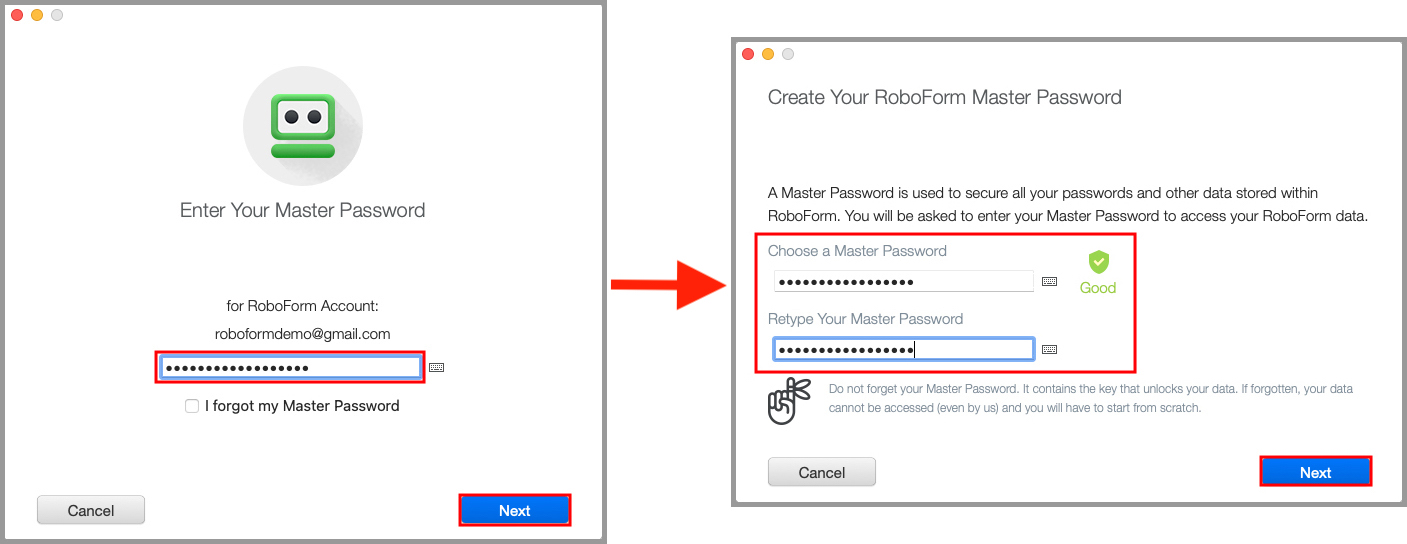
NOTE: If you forget your Master Password, you can reset it through the RoboForm mobile app without losing your data. Click here for our tutorial on enabling the Master Password Restore feature on iOS. Click here for our tutorial on enabling the Master Password Restore feature on Android.
- A RoboForm window will display confirming that the Master Password change was successful. Click the blue "OK" button.
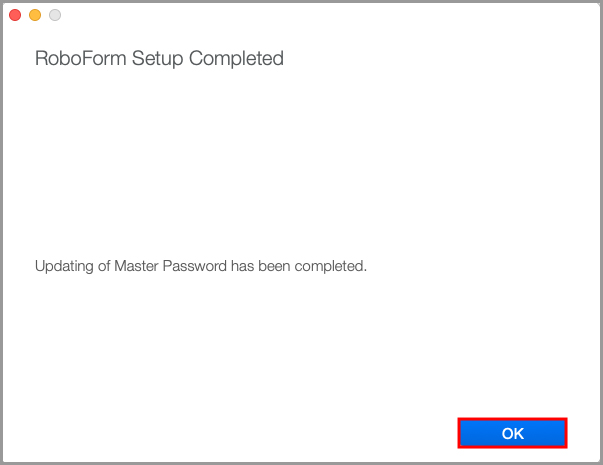
Account & Data
This page provides options for Data and Syncing Data.
RoboForm Premium
- Account: Shows the Email associated with your RoboForm Account. Clicking the email will open RoboForm Online, which you can read more about in Chapter 16: RoboForm Online.
- Automatic Sync: When checked, will automatically sync your device and your RoboForm account whenever you log in with your Master Password or you edit an item. Uncheck this if you want to do manual sync.
- Sync RoboForm: Manually syncs your data.
- Show Changed Files without Syncing (Analyze only): Analyzes the RoboForm data without syncing.
- Change Account: Opens a dialog to login into a different RoboForm Account.
License Information
Shows your license type and expiration date. If you are a free user, you can click the “Upgrade Account” button to purchase a subscription to RoboForm Premium.
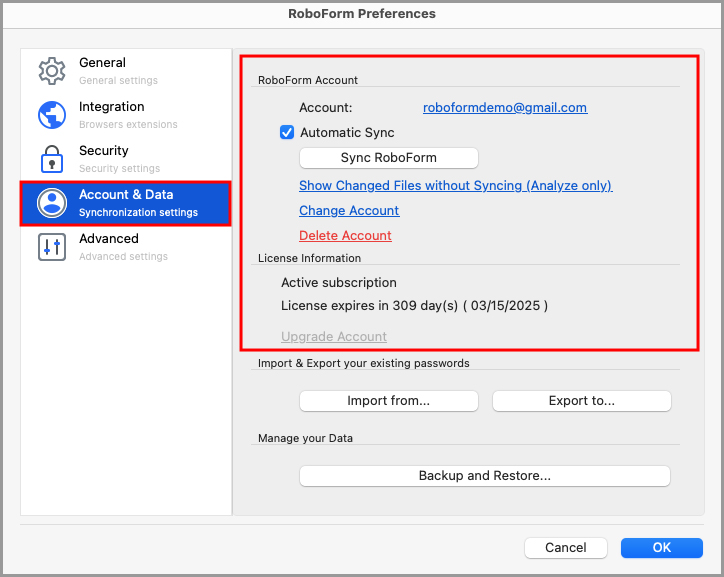
Import and Export
- Import from…: Allows you to import any data from browsers or other password managers to RoboForm.
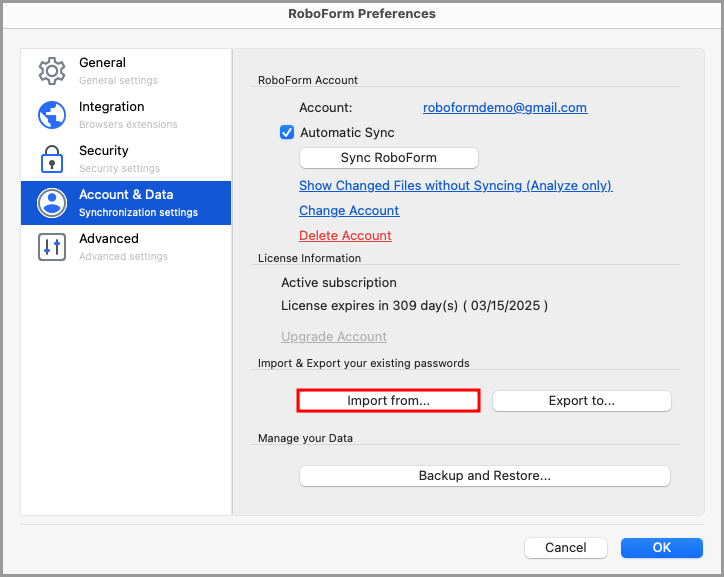
For browsers, click the Import button next to the browser name.
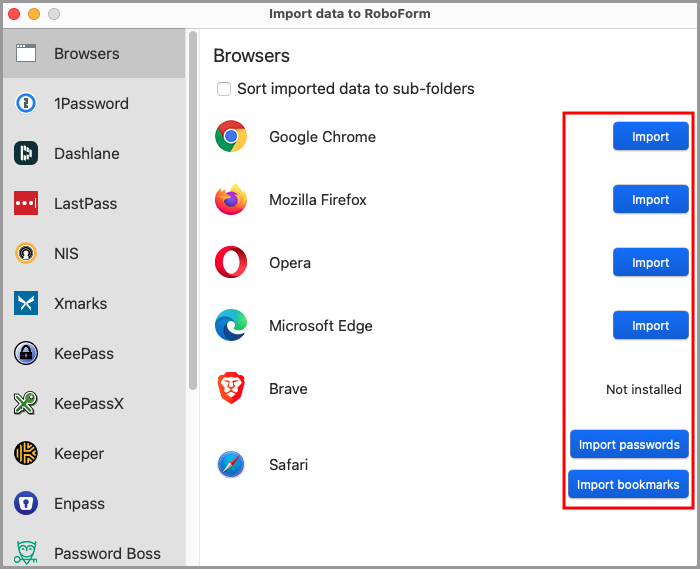
For other password managers, follow the directions on the page corresponding to the password manager you are importing from.
- Import into folder: Allows you to select a folder to import your data into.
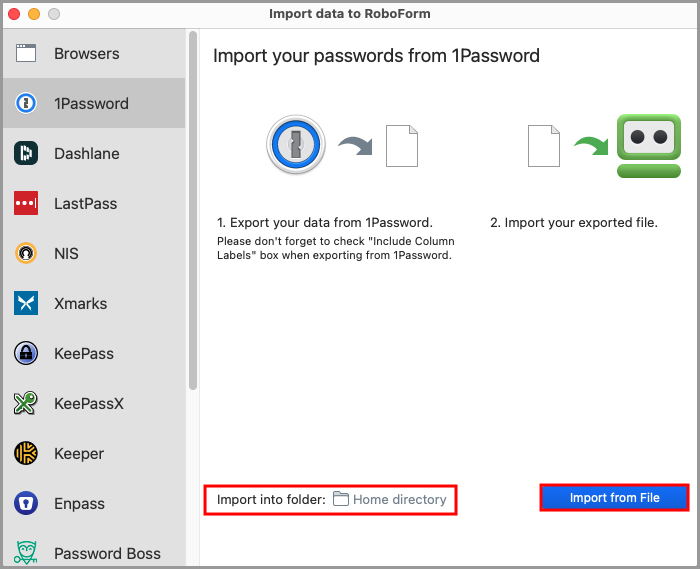
- Export to…: Allows you to export your RoboForm Data to a location on your computer.
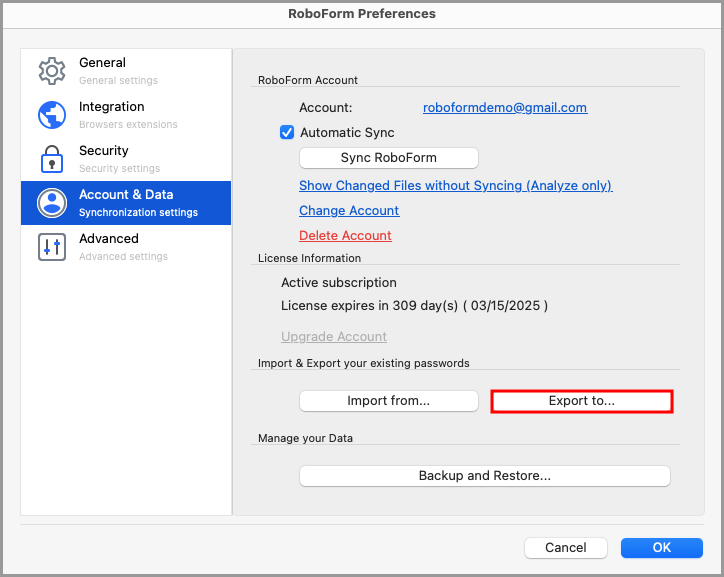
Backup and Restore…
Opens a window showing options to backup or restore your RoboForm Data.
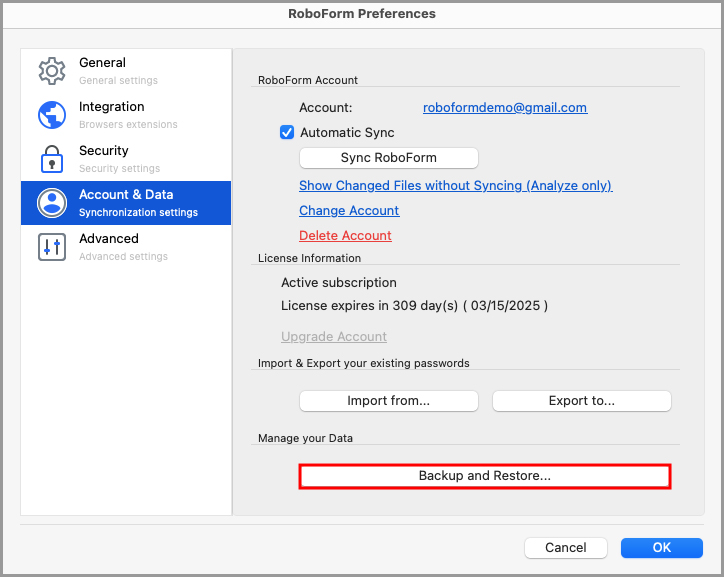
- The first pane shows Available Restore Points. These are points in time that RoboForm Data can be restored back to.
- To restore data to a time point, simply select the desired restore point and click Restore.
- To create a new restore point click Create new Backup. The new restore point will appear at the top of the list.
- To remove a restore point, select it and click Delete.
- Restore from folder: Allows you to find a restore location for your RoboForm Data. Simply find the location in Browse and click Restore.
- Preserve as manual: Allows you to preserve the restore point as a manual backup.
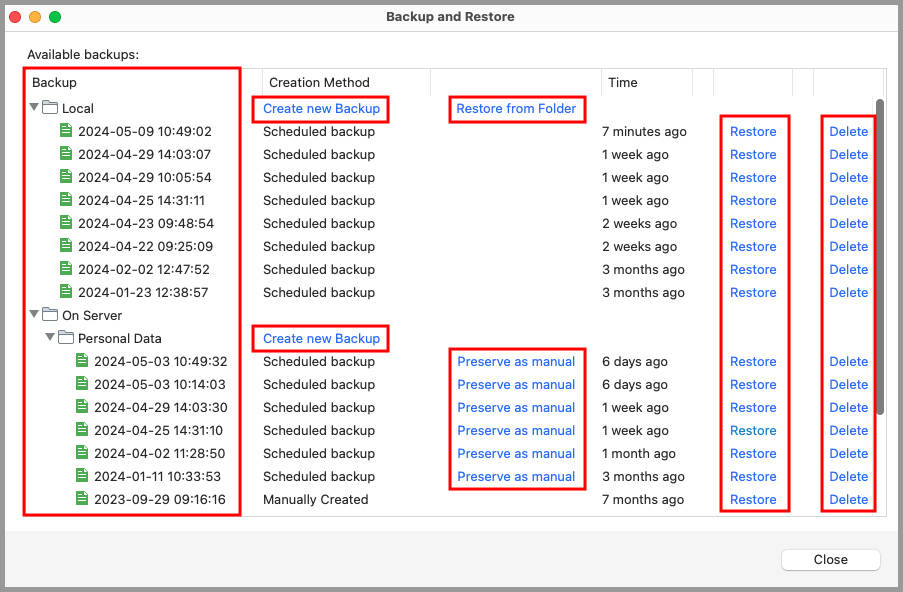
How to Export RoboForm Data
- Click the RoboForm icon in the Menu Bar and select “Settings” from the menu.
- Select “Account & Data” from the column on the left and click the “Export To” button.
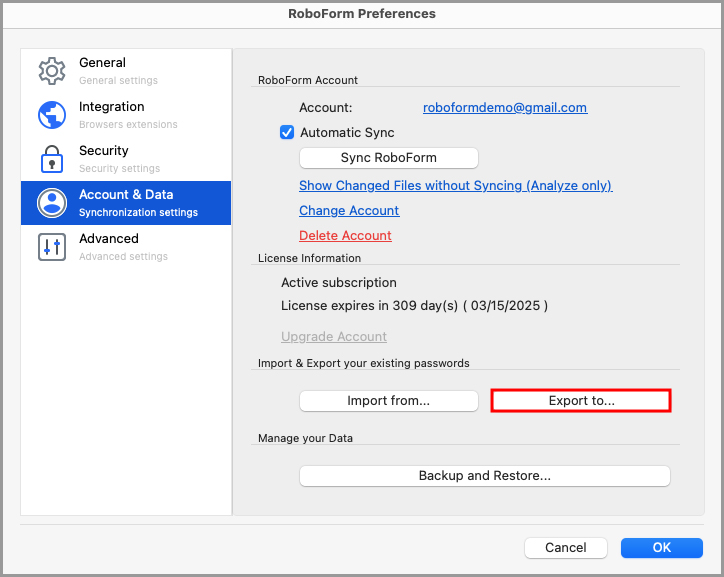
- RoboForm will prompt you to input your Master Password in order to confirm the export.
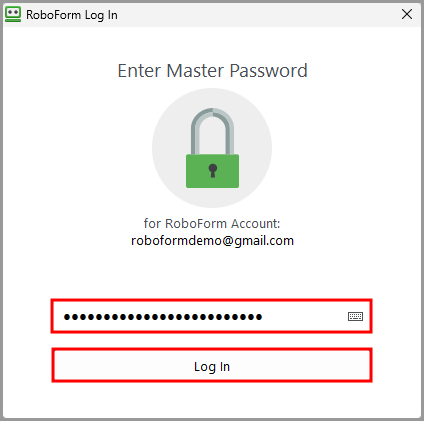
- Select the Folder you would like to export under “Data to Export.”
- Select a location for your exported data by clicking the “Browse” button.
- Select the format you would like your files to be exported in. The options are HTML file or CSV file.
- Click the blue “Export” button.
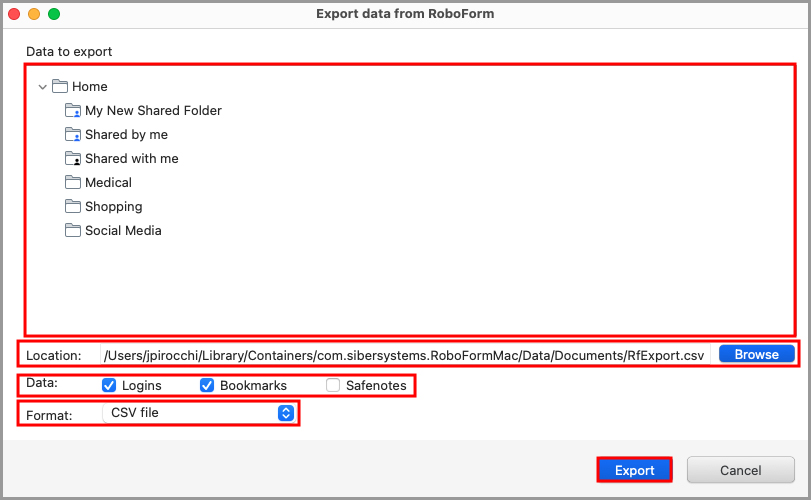
- RoboForm will present you with a window warning you that your exported data will not be encrypted. Click the blue “Yes” button to confirm the export.
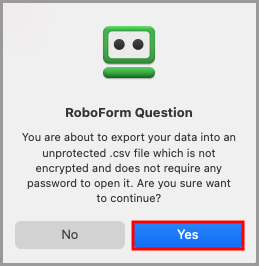
- The Export will show its status bar and say when the Export is complete.
- You can click the “Open containing folder” button to see where the exported data is now.
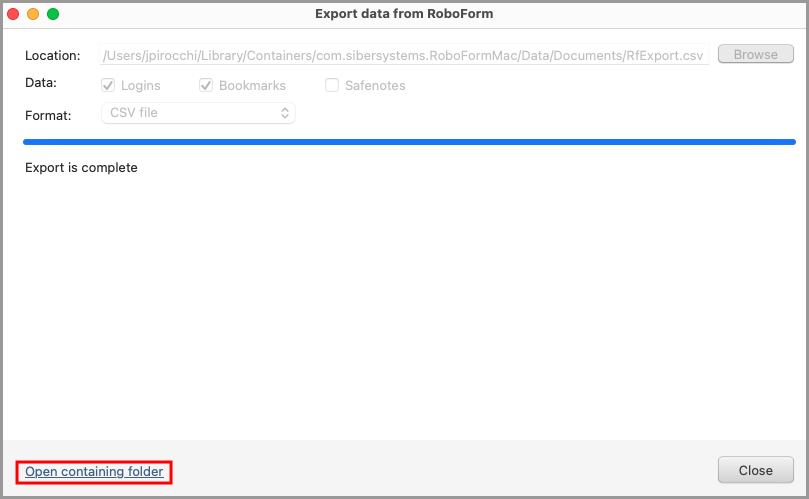
Advanced
This tab has options for Domain Equivalencies.
Some websites are under the same organizations and utilize the same Logins or Accounts but have different URLs. These are called Mirrors.
For example: Bank of America uses mbna.com, bankofamerica.com, bofa.com, and usecfo.com.
Domain Equivalencies simplifies this problem by creating a single Login for multiple sites.
For this list, add a new domain equivalency by clicking the “ + ”, typing your first domain in domain1, and the equivalent in domain2.
For example, if we were to use our Bank of America example again, we might do something like this: “<domain1> = mbna.com and <domain2> = bankofamerica.com”.
These settings will then apply in Matching Logins.
To delete a Domain Equivalency, select the Domain Equivalency and click the “ - ” to delete it.
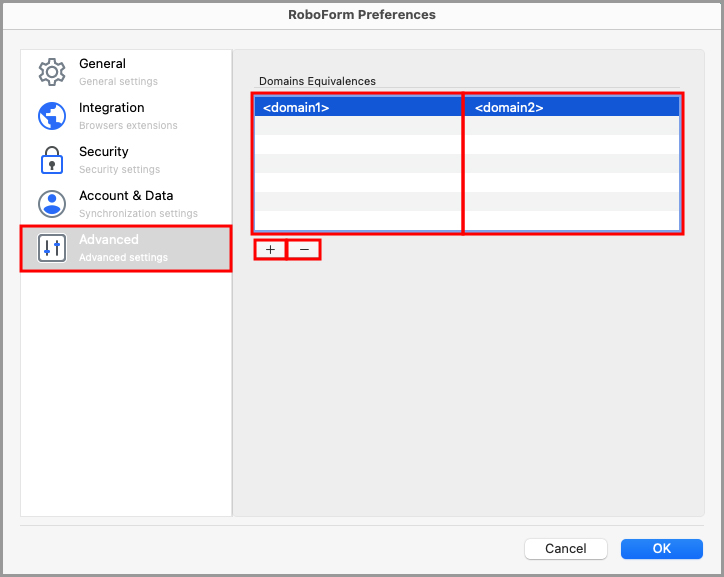
Extension Settings
The Settings menu hosts all the settings and preferences for the RoboForm Extension.
Accessing Settings
You can open Settings by one of the following ways:
- In the RoboForm Extension, click the 3 dots in the upper right corner and select Settings.
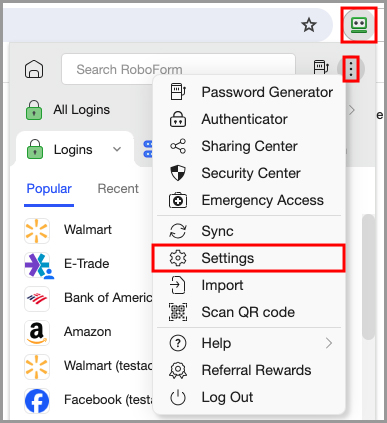
- On the RoboForm Start Page, click the account dropdown and select Settings.
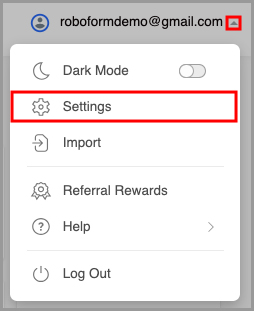
Settings Window Layout
The Settings window is split into two sections:
- The Left Panel shows navigation tabs such as Language, Browsers & Apps, etc.
- The Details Pane shows the options available in the selected navigation tab.
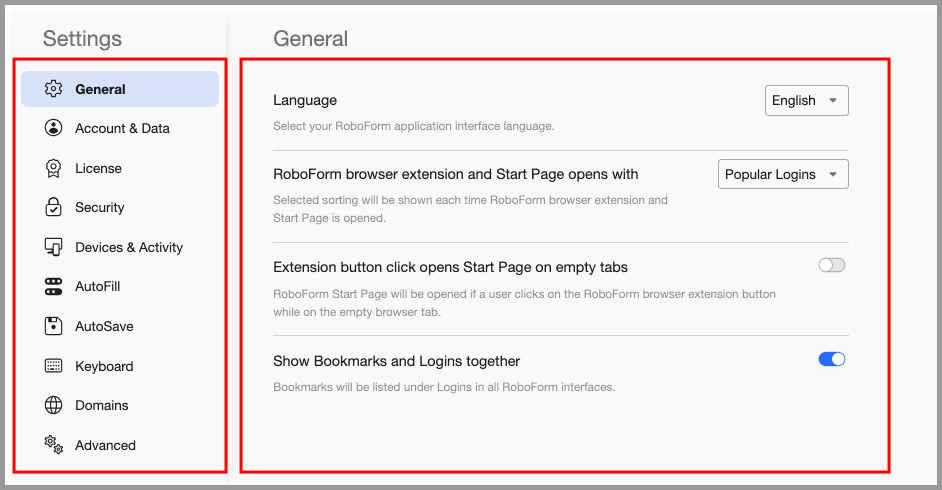
General
- The first option on the General page is to change the Language for your RoboForm interface. Simply select the language in the drop-down menu.
- RoboForm Browser Extension and Start Page opens with: Allows you to select from the dropdown how your RoboForm data is sorted in the RoboForm Extension and Start Page.
- Extension button click opens Start Page on empty tabs: Allows you to select that the RoboForm Start Page will be opened if a user clicks on the RoboForm browser extension button while on an empty browser tab.
- Show Bookmarks and Logins together: Allows you to select that Bookmarks will be listed under Logins in all RoboForm interfaces.
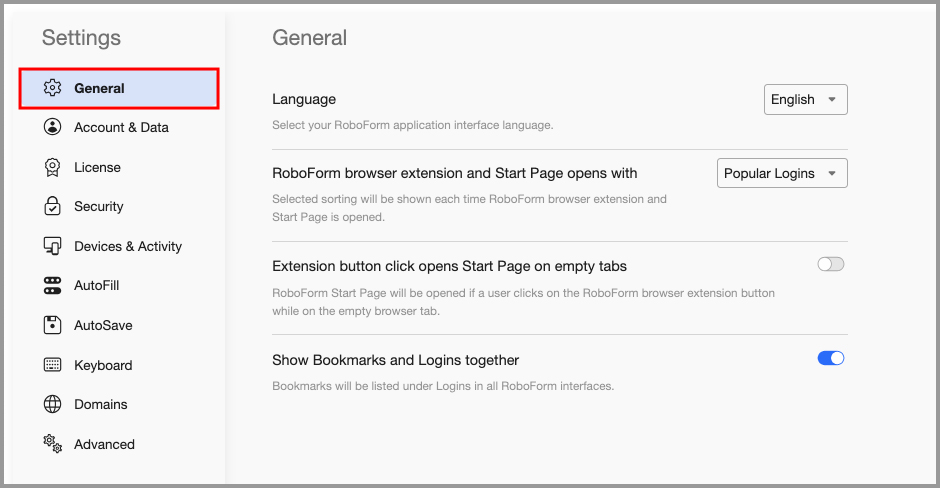
Account & Data
- First and Last Name: The first and last name associated with your account.
- Email: The email you used to sign up for the account.
- Import & Export your existing passwords: Allows you to import or export passwords to or from RoboForm.
- Change Master Password: Allows you to change your Master Password.
- Clear Usage Logs: Allows you to clear your Popular and Recent lists.
- Backup & Restore: Allows you to backup or restore your RoboForm data.
- Delete My RoboForm Account: Allows you to delete your RoboForm account.
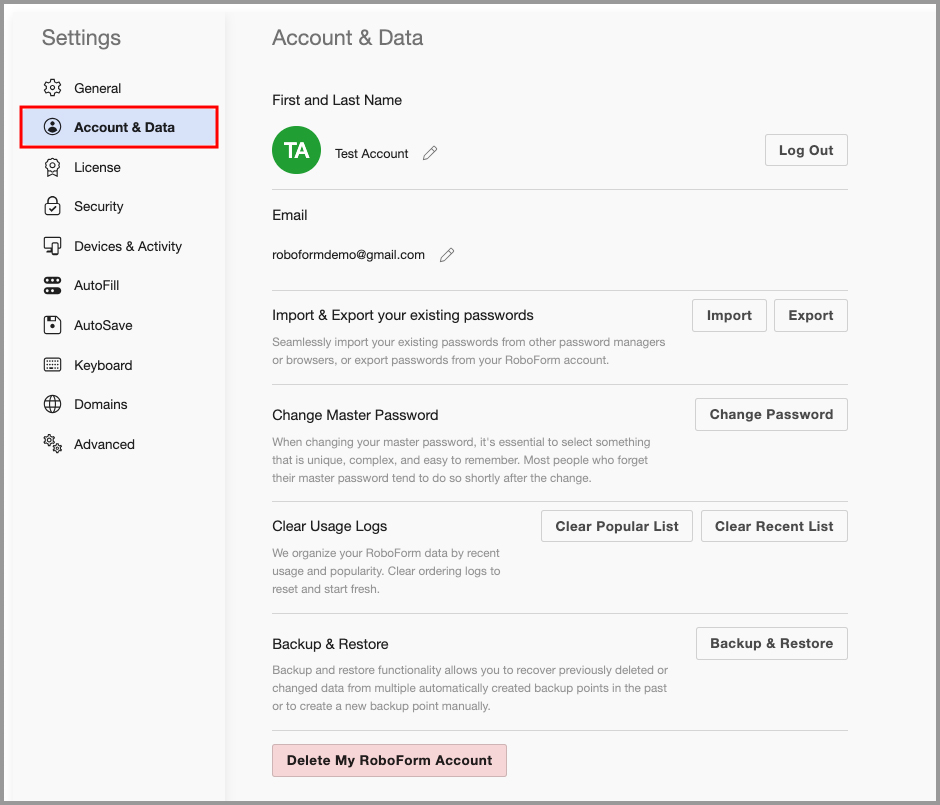
License
- License type: Lists the type of license you have for RoboForm.
- License status: Displays whether your license is active or inactive and the expiration date of the license.
- Auto Renewal Status: Allows you to toggle your Auto Renewal status on/off, lists the next billing date, and lists the price the license will renew at.
- Payment Info: Displays the payment method you have on file for your account.
- Activated Accounts: Shows other licenses you have available under your account (if applicable).
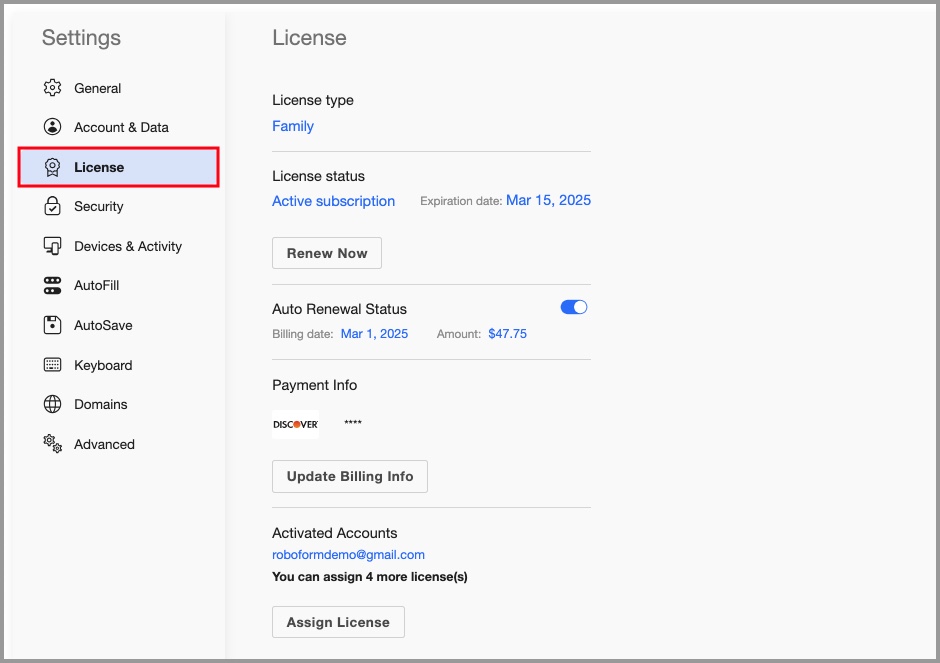
Security
This page allows you to view some of your security information.
- Authentication Method:
- Always ask for Master Password - When checked, means you can only log in by typing your Master Password.
- Use Touch ID - Allows you to use Touch ID to log in instead of your Master Password.
- Don’t ask for Master Password - When checked, will turn off the prompt requesting the Master Password. For security reasons, we recommend against this.
- Auto-Logout after this many minutes: The time period before RoboForm automatically logs you off. You can turn off Auto-Logout by checking the box. The number at the bottom shows the amount of minutes before Automatic Logout. To change the time period, simply type in a number or click the up and down arrows to select a number of minutes.
- Two-factor authentication - Allows you to set up a second authentication step to protect your RoboForm account from unauthorized access.
- Warn me before Login data is filled on a non-matching domain - RoboForm will warn you before Login data is filled to a domain different than the one associated with that Login.
- Warn me before my credit card or bank account data is filled - RoboForm will ask for additional confirmation before any payment information data stored in your identity is filled.
- Show compromised passwords indicator - Allows you to toggle on or off the Compromised Passwords indicator.
- Encryption iteration count - The number of times that the password is hashed during the derivation of the symmetric key.
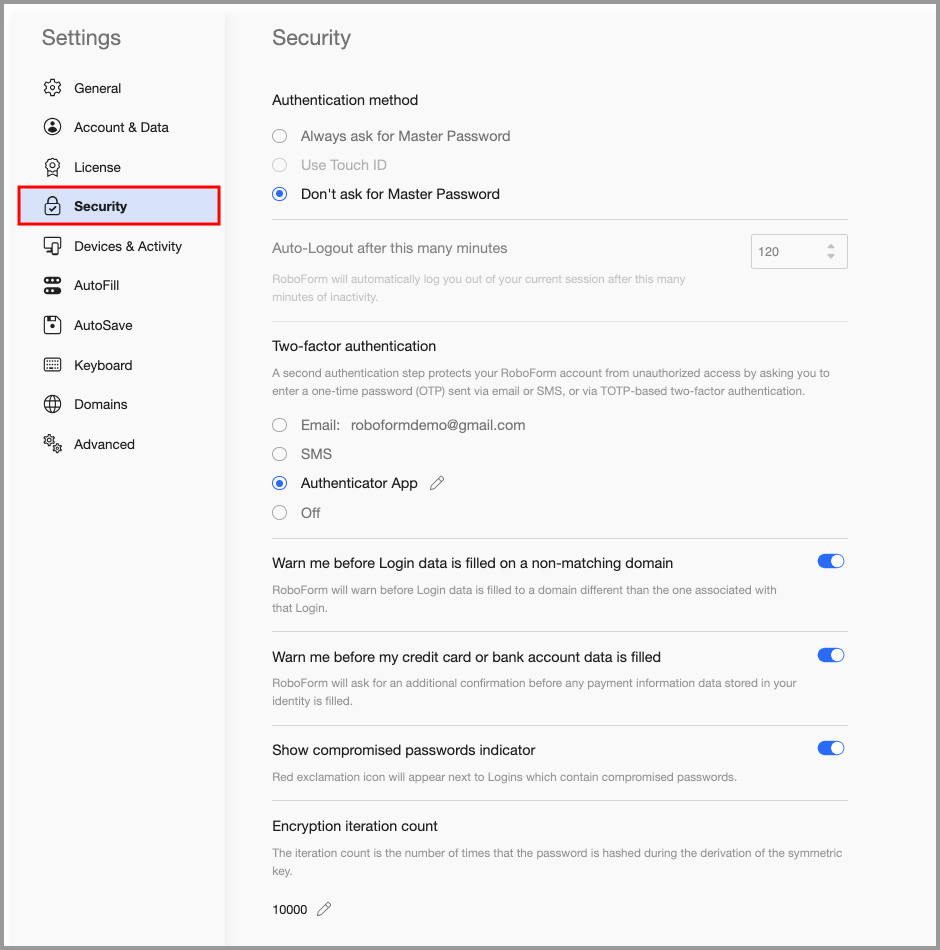
Devices & Activity
This page shows which devices you have authorized and recent activity on your account. You can use this page to help verify the security of your account.
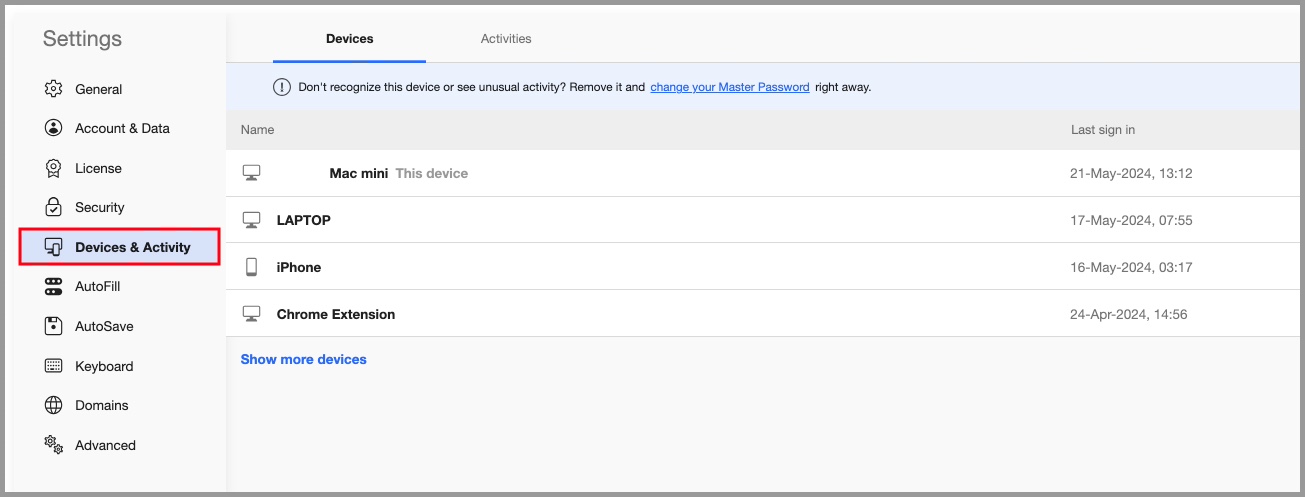
If you see a device that you do not recognize, select it and click "Remove this device" in the bottom left.

AutoFill
This page provides AutoFill options. Read more in Chapter 10: AutoFill Dialog.
- AutoFill:
- Do not Offer to AutoFill - When checked, means RoboForm will not offer to automatically fill forms.
- Offer to AutoFill - When checked, means that when RoboForm encounters a form that can be filled from a Matching Login or an Identity, the in-page AutoFill icon will offer to AutoFill the form.
- AutoFill Without Asking (if only one choice) - When checked, will automatically fill all forms when you visit a web page with the Matching Login or Identity. If there are multiple matching Logins, the AutoFill dialog will pop up. Read more about AutoFill in Chapter 10: AutoFill Dialog.
- Offer to AutoFill from Contacts - Offers to fill from Contacts in addition to Identities.
- Offer to AutoFill Basic Authentication dialogs in Browsers - When checked, means that when RoboForm encounters a Basic Authentication, AutoFill will offer to fill the Matching Login.
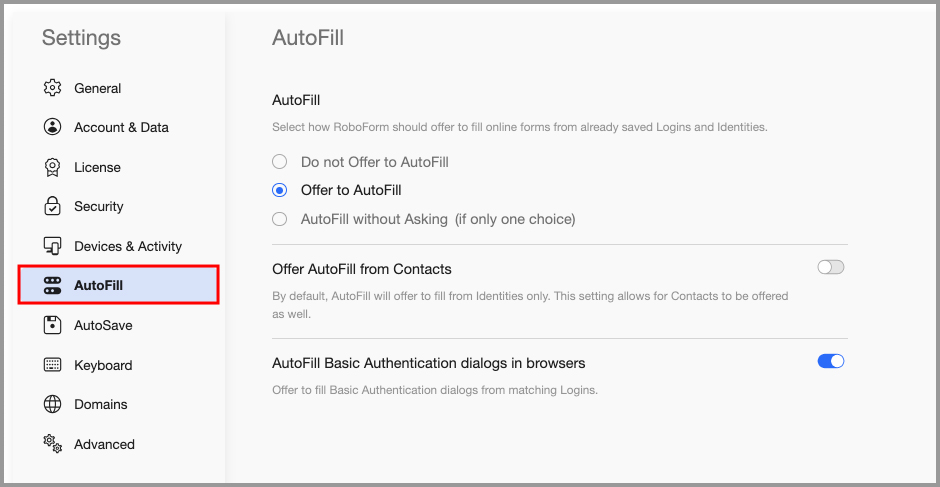
AutoSave
This page provides AutoSave options. Read more in Chapter 4: Logins.
- AutoSave:
- Do not Offer to AutoSave - When checked, means RoboForm will not offer to automatically save Logins.
- Offer to AutoSave (require user confirmation) - When checked, means that when you submit a Login, RoboForm will offer to save it.
- AutoSave without Asking - When checked, means that when you submit a Login, RoboForm will save it automatically.
- AutoSave from Basic Authentication dialogs in browsers - Opens the AutoSave dialog when you submit (log in to) a Windows Dialog or Basic Authentication form. Read more about Basic Authentication in Chapter 4: Logins.
- Enable keyboard shortcut: ALT + click on sign-in button forces AutoSave - This is a method to force AutoSave a Login. Type in your login details and hold the ALT key + click the login button for the AutoSave Dialog to appear.
- Enable keyboard shortcut: SHIFT + ENTER in text field forces AutoSave - This is a method to force AutoSave a Login. Type in your login details and hold Shift + Enter for the AutoSave Dialog to appear.
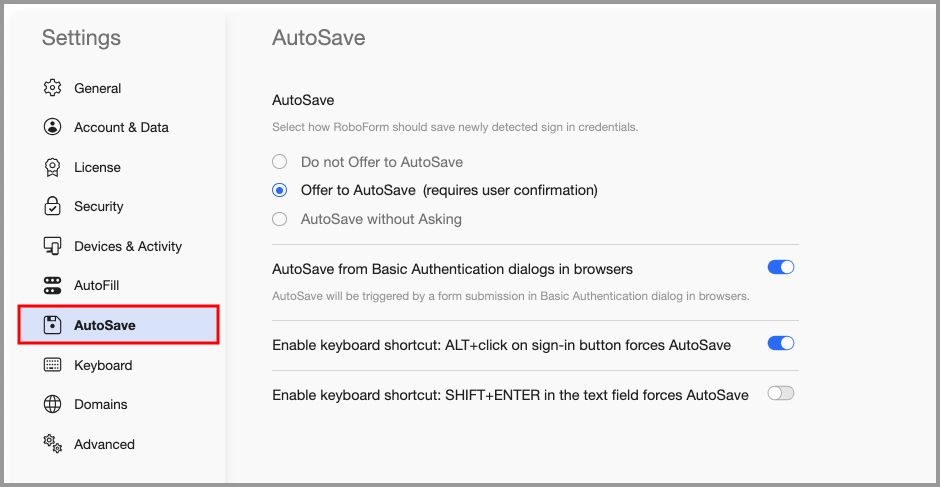
Keyboard
Enable RoboForm Shortcuts in Browser means that Keyboard shortcuts will be available when this option is checked. Unchecking it will disable shortcuts.
To use a shortcut, hold Alt and the Key command to trigger the shortcut.
List of default commands:
- Alt + X - Opens Logins
- Alt + N - Opens Identities
- Alt + C - Opens Safenotes
- Alt + U - Opens the RoboForm Button
- Alt + I - Opens RoboForm Taskbar icon
- Alt + L - Logoff
- Alt + M - Matching Passcards
- Alt + O - Opens RoboForm Options
- Alt + P - Opens Password Generator
- Alt + R - Show and Hide RoboForm Toolbar
- Alt + S - Opens Search Box
- Alt + Z - Fill and Submit the web page you are on
- Alt + - - Resets Fields to their original values
- Alt + = - Sets Fields with check marks
- Alt + 0 - Clears the Fields that are filled
- Alt + , - Opens Identities Editor
- Alt + . - Opens Passcards Editor
- Alt + / - Opens Safenotes Editor
- Alt + ] - Offers to fill forms on a website
- Alt + [ - Opens dialog to save forms on a website
- Alt + 1-9 - Fills in your Identity according to the order, 1 being the first identity
At the bottom of the page, there are options to use Ctrl or Shift instead of Alt, and an option to use the Right Alt key for shortcuts in addition to the left.
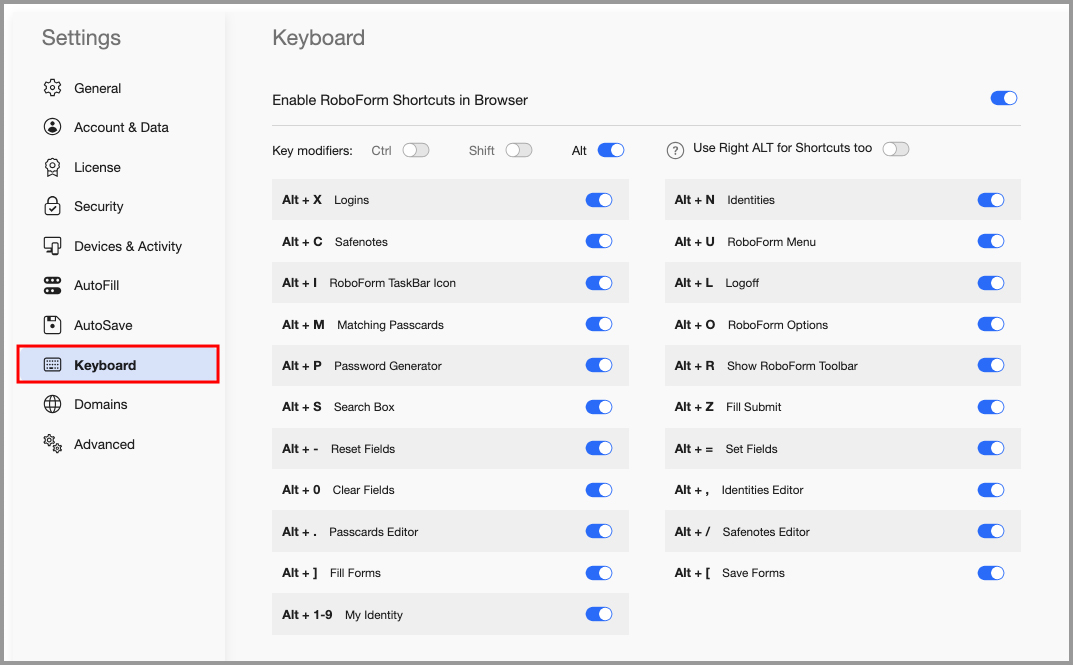
Domains
Equivalent Domains: Some websites are under the same organizations and utilize the same Logins or Accounts, but have different URLs. These are called Mirrors.
Domain Equivalencies simplifies this problem by creating a single Login for multiple URLs. For this list, add Domains that share the same Login. Use " = " to mark the domains equal to each other, e.g., “apple.com=itunes.com.” These settings will then apply in Matching Logins.
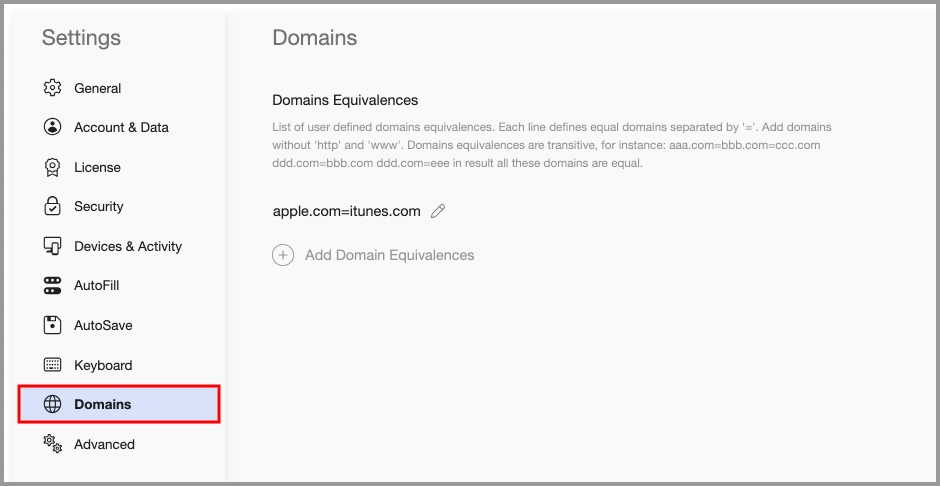
Advanced
- Enable integration with installed RoboForm application - Toggles on and off integration between the RoboForm browser extension and the RoboForm desktop application.
- Use Desktop Editor for View and Edit - Allows you to choose to use the Desktop Editor instead of the Start Page to view and edit your data.
- Enable RoboForm Desktop Menu - Allows you to choose to have the RoboForm Desktop menu included in the browser extension.
- Disable browser built-in password manager when RoboForm extension is installed - Allows you to automatically disable your browser’s built-in password manager when the RoboForm extension is installed.
- How to calculate data popularity - Allows you to choose the algorithm RoboForm uses to calculate data popularity.
- How fast does used data become popular - Allows you to choose the speed at which used data becomes labeled as Popular.
- Open Options in installed RoboForm - Allows you to open the RoboForm Desktop Application’s options.
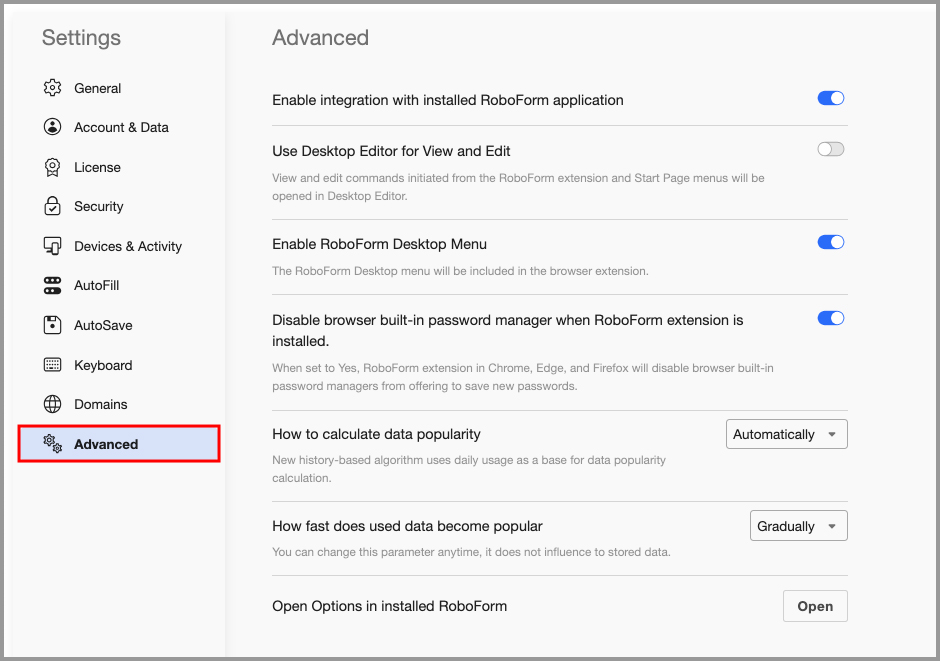
Chapter 19: RoboForm Security
The security of our users’ data is of the utmost importance to us.
The next few sections outline the different layers of protection that RoboForm employs.
Encryption
All RoboForm data is packed into a single file encrypted using AES encryption with 256-bit keys. To protect against dictionary, brute force, or other attacks, we generate encryption keys using the PBKDF2 password hashing algorithm with a random salt and SHA-256 as a hash function.
All decryption of your RoboForm data happens on your device and not on our servers. The encryption key is derived from the Master Password and never leaves the client device. This applies for both installed versions of RoboForm as well as web access.
No RoboForm data can be accessed without the Master Password. We have no way of knowing what your Master Password is because RoboForm does not transmit it to our servers.
Authentication
As part of our RoboForm Premium subscription, we offer secure sync and backup of encrypted RoboForm data (sync can be turned off on Windows and Mac).
All RoboForm data that leaves your device is encrypted both in transit and when stored on our servers.
To enable the sync process, our server has to authenticate your RoboForm account credentials. To do this, we use an authentication hash. The authentication hash is generated from your Master Password. However, we use a different algorithm than that for deriving the local encryption key. This is how we securely sync without being able to decrypt your underlying data, nor know what your Master Password is.
To further ensure the security of your account, we offer options for OTP (One Time Password) and 2FA (Two-Factor Authentication). Read more about how to set up OTP/2FA in Chapter 12: Authenticator.
Secure Sharing and Sending
We use public-private key encryption for our Secure Sharing feature as well as for individual item Sending. This allows you to provide access to your RoboForm data to trusted recipients with different permission levels without sharing your Master Password.
